DBTG SET Revisited
VerifiedAdded on 2019/09/26
|32
|11057
|213
Report
AI Summary
The assignment content provides an overview of the SURLY database system, including its components and operations. The main topics covered are: indexing, B-trees, transaction logging (LOG), undoing (UNDO) and restoring (RESTORE), and file I/O (READ/ WRITE). The summary also mentions the importance of physical data independence, dynamic memory management, and garbage collection.
Contribute Materials
Your contribution can guide someone’s learning journey. Share your
documents today.
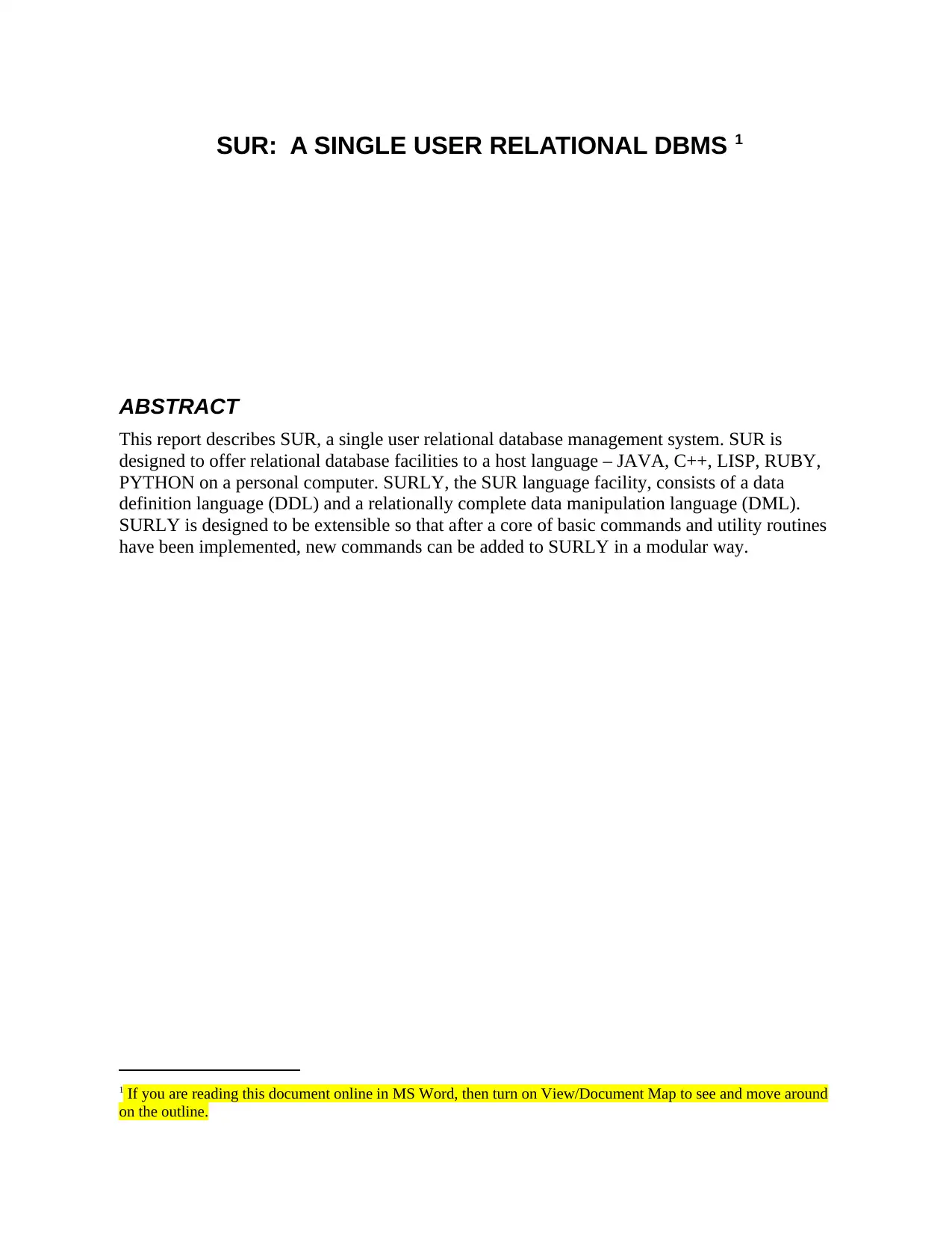
SUR: A SINGLE USER RELATIONAL DBMS 1
ABSTRACT
This report describes SUR, a single user relational database management system. SUR is
designed to offer relational database facilities to a host language – JAVA, C++, LISP, RUBY,
PYTHON on a personal computer. SURLY, the SUR language facility, consists of a data
definition language (DDL) and a relationally complete data manipulation language (DML).
SURLY is designed to be extensible so that after a core of basic commands and utility routines
have been implemented, new commands can be added to SURLY in a modular way.
1 If you are reading this document online in MS Word, then turn on View/Document Map to see and move around
on the outline.
ABSTRACT
This report describes SUR, a single user relational database management system. SUR is
designed to offer relational database facilities to a host language – JAVA, C++, LISP, RUBY,
PYTHON on a personal computer. SURLY, the SUR language facility, consists of a data
definition language (DDL) and a relationally complete data manipulation language (DML).
SURLY is designed to be extensible so that after a core of basic commands and utility routines
have been implemented, new commands can be added to SURLY in a modular way.
1 If you are reading this document online in MS Word, then turn on View/Document Map to see and move around
on the outline.
Secure Best Marks with AI Grader
Need help grading? Try our AI Grader for instant feedback on your assignments.

TABLE OF CONTENTS
SUR: A SINGLE USER RELATIONAL DBMS ........................................................................1
ABSTRACT...............................................................................................................................1
TABLE OF CONTENTS...........................................................................................................2
LIST OF FIGURES....................................................................................................................3
I. Core of SUR AND SURLY....................................................................................................4
A. SUR – Introduction...........................................................................................................4
B. The Syntax of SURLY......................................................................................................5
C. The Lexical Analyzer........................................................................................................8
D. Basic SURLY Commands.................................................................................................9
E. The SURLY Interpreter...................................................................................................12
G. INDEX statement (storage structures)............................................................................13
H. EXPORT and IMPORT statements.................................................................................17
I. Assignments......................................................................................................................17
II. Relational Algebra Commands............................................................................................18
A. The Relational Assignment Statement and Relexpr's......................................................18
B. PROJECT........................................................................................................................19
C. JOIN.................................................................................................................................20
D. SELECT and Qualifiers...................................................................................................20
E. DELETE WHERE...........................................................................................................22
F. Intermediate Results – PRINT and ASSIGN...................................................................22
G. UNION, INTERSECTION, SET-DI.FFERENCE, and COPY --optional......................23
H. Predicates EQUAL? arid SUBSET? --optional...............................................................23
I. Pseudo-Relation EMPTY – optional................................................................................23
J. Executable SURLY (ESURLY).......................................................................................24
K. Interactive SURLY..........................................................................................................25
L. Example Queries..............................................................................................................25
III. Extensions to SURLY........................................................................................................26
A. VIEW...............................................................................................................................26
B. TRIGGER........................................................................................................................26
C. INTEGRITY CONSTRAINT..........................................................................................27
D. RETRIEVE – a calculus operator for SURLY................................................................27
E. Hierarchical Formatted PRINT........................................................................................28
F. LINK................................................................................................................................31
G. INDEX Revisited............................................................................................................31
H. B-TREE...........................................................................................................................31
I. LOG, UNDO, DUMP, RESTORE...................................................................................31
J. READ/WRITE..................................................................................................................32
SUR: A SINGLE USER RELATIONAL DBMS ........................................................................1
ABSTRACT...............................................................................................................................1
TABLE OF CONTENTS...........................................................................................................2
LIST OF FIGURES....................................................................................................................3
I. Core of SUR AND SURLY....................................................................................................4
A. SUR – Introduction...........................................................................................................4
B. The Syntax of SURLY......................................................................................................5
C. The Lexical Analyzer........................................................................................................8
D. Basic SURLY Commands.................................................................................................9
E. The SURLY Interpreter...................................................................................................12
G. INDEX statement (storage structures)............................................................................13
H. EXPORT and IMPORT statements.................................................................................17
I. Assignments......................................................................................................................17
II. Relational Algebra Commands............................................................................................18
A. The Relational Assignment Statement and Relexpr's......................................................18
B. PROJECT........................................................................................................................19
C. JOIN.................................................................................................................................20
D. SELECT and Qualifiers...................................................................................................20
E. DELETE WHERE...........................................................................................................22
F. Intermediate Results – PRINT and ASSIGN...................................................................22
G. UNION, INTERSECTION, SET-DI.FFERENCE, and COPY --optional......................23
H. Predicates EQUAL? arid SUBSET? --optional...............................................................23
I. Pseudo-Relation EMPTY – optional................................................................................23
J. Executable SURLY (ESURLY).......................................................................................24
K. Interactive SURLY..........................................................................................................25
L. Example Queries..............................................................................................................25
III. Extensions to SURLY........................................................................................................26
A. VIEW...............................................................................................................................26
B. TRIGGER........................................................................................................................26
C. INTEGRITY CONSTRAINT..........................................................................................27
D. RETRIEVE – a calculus operator for SURLY................................................................27
E. Hierarchical Formatted PRINT........................................................................................28
F. LINK................................................................................................................................31
G. INDEX Revisited............................................................................................................31
H. B-TREE...........................................................................................................................31
I. LOG, UNDO, DUMP, RESTORE...................................................................................31
J. READ/WRITE..................................................................................................................32

LIST OF FIGURES
Figure 1. The Syntax of SURLY...................................................................................................6
Figure 2. Sample Test Data...........................................................................................................7
Figure 3: Secondary Indices in SURLY......................................................................................16
Figure 4: Sample Data, A Hierarchical, Formatted PRINT Command, and the Corresponding
Output...................................................................................................................................30
Figure 1. The Syntax of SURLY...................................................................................................6
Figure 2. Sample Test Data...........................................................................................................7
Figure 3: Secondary Indices in SURLY......................................................................................16
Figure 4: Sample Data, A Hierarchical, Formatted PRINT Command, and the Corresponding
Output...................................................................................................................................30
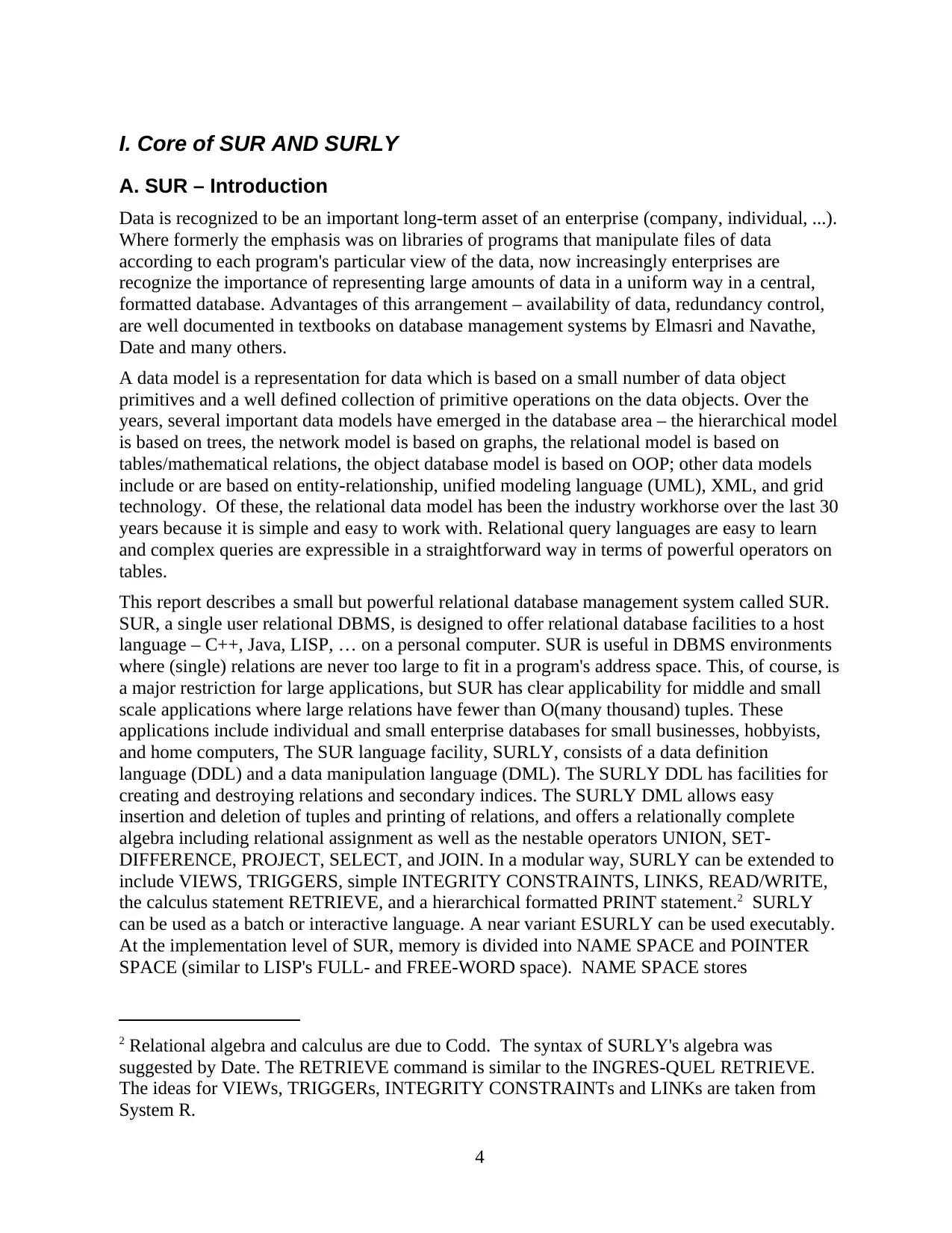
I. Core of SUR AND SURLY
A. SUR – Introduction
Data is recognized to be an important long-term asset of an enterprise (company, individual, ...).
Where formerly the emphasis was on libraries of programs that manipulate files of data
according to each program's particular view of the data, now increasingly enterprises are
recognize the importance of representing large amounts of data in a uniform way in a central,
formatted database. Advantages of this arrangement – availability of data, redundancy control,
are well documented in textbooks on database management systems by Elmasri and Navathe,
Date and many others.
A data model is a representation for data which is based on a small number of data object
primitives and a well defined collection of primitive operations on the data objects. Over the
years, several important data models have emerged in the database area – the hierarchical model
is based on trees, the network model is based on graphs, the relational model is based on
tables/mathematical relations, the object database model is based on OOP; other data models
include or are based on entity-relationship, unified modeling language (UML), XML, and grid
technology. Of these, the relational data model has been the industry workhorse over the last 30
years because it is simple and easy to work with. Relational query languages are easy to learn
and complex queries are expressible in a straightforward way in terms of powerful operators on
tables.
This report describes a small but powerful relational database management system called SUR.
SUR, a single user relational DBMS, is designed to offer relational database facilities to a host
language – C++, Java, LISP, … on a personal computer. SUR is useful in DBMS environments
where (single) relations are never too large to fit in a program's address space. This, of course, is
a major restriction for large applications, but SUR has clear applicability for middle and small
scale applications where large relations have fewer than O(many thousand) tuples. These
applications include individual and small enterprise databases for small businesses, hobbyists,
and home computers, The SUR language facility, SURLY, consists of a data definition
language (DDL) and a data manipulation language (DML). The SURLY DDL has facilities for
creating and destroying relations and secondary indices. The SURLY DML allows easy
insertion and deletion of tuples and printing of relations, and offers a relationally complete
algebra including relational assignment as well as the nestable operators UNION, SET-
DIFFERENCE, PROJECT, SELECT, and JOIN. In a modular way, SURLY can be extended to
include VIEWS, TRIGGERS, simple INTEGRITY CONSTRAINTS, LINKS, READ/WRITE,
the calculus statement RETRIEVE, and a hierarchical formatted PRINT statement.2 SURLY
can be used as a batch or interactive language. A near variant ESURLY can be used executably.
At the implementation level of SUR, memory is divided into NAME SPACE and POINTER
SPACE (similar to LISP's FULL- and FREE-WORD space). NAME SPACE stores
2 Relational algebra and calculus are due to Codd. The syntax of SURLY's algebra was
suggested by Date. The RETRIEVE command is similar to the INGRES-QUEL RETRIEVE.
The ideas for VIEWs, TRIGGERs, INTEGRITY CONSTRAINTs and LINKs are taken from
System R.
4
A. SUR – Introduction
Data is recognized to be an important long-term asset of an enterprise (company, individual, ...).
Where formerly the emphasis was on libraries of programs that manipulate files of data
according to each program's particular view of the data, now increasingly enterprises are
recognize the importance of representing large amounts of data in a uniform way in a central,
formatted database. Advantages of this arrangement – availability of data, redundancy control,
are well documented in textbooks on database management systems by Elmasri and Navathe,
Date and many others.
A data model is a representation for data which is based on a small number of data object
primitives and a well defined collection of primitive operations on the data objects. Over the
years, several important data models have emerged in the database area – the hierarchical model
is based on trees, the network model is based on graphs, the relational model is based on
tables/mathematical relations, the object database model is based on OOP; other data models
include or are based on entity-relationship, unified modeling language (UML), XML, and grid
technology. Of these, the relational data model has been the industry workhorse over the last 30
years because it is simple and easy to work with. Relational query languages are easy to learn
and complex queries are expressible in a straightforward way in terms of powerful operators on
tables.
This report describes a small but powerful relational database management system called SUR.
SUR, a single user relational DBMS, is designed to offer relational database facilities to a host
language – C++, Java, LISP, … on a personal computer. SUR is useful in DBMS environments
where (single) relations are never too large to fit in a program's address space. This, of course, is
a major restriction for large applications, but SUR has clear applicability for middle and small
scale applications where large relations have fewer than O(many thousand) tuples. These
applications include individual and small enterprise databases for small businesses, hobbyists,
and home computers, The SUR language facility, SURLY, consists of a data definition
language (DDL) and a data manipulation language (DML). The SURLY DDL has facilities for
creating and destroying relations and secondary indices. The SURLY DML allows easy
insertion and deletion of tuples and printing of relations, and offers a relationally complete
algebra including relational assignment as well as the nestable operators UNION, SET-
DIFFERENCE, PROJECT, SELECT, and JOIN. In a modular way, SURLY can be extended to
include VIEWS, TRIGGERS, simple INTEGRITY CONSTRAINTS, LINKS, READ/WRITE,
the calculus statement RETRIEVE, and a hierarchical formatted PRINT statement.2 SURLY
can be used as a batch or interactive language. A near variant ESURLY can be used executably.
At the implementation level of SUR, memory is divided into NAME SPACE and POINTER
SPACE (similar to LISP's FULL- and FREE-WORD space). NAME SPACE stores
2 Relational algebra and calculus are due to Codd. The syntax of SURLY's algebra was
suggested by Date. The RETRIEVE command is similar to the INGRES-QUEL RETRIEVE.
The ideas for VIEWs, TRIGGERs, INTEGRITY CONSTRAINTs and LINKs are taken from
System R.
4
Paraphrase This Document
Need a fresh take? Get an instant paraphrase of this document with our AI Paraphraser
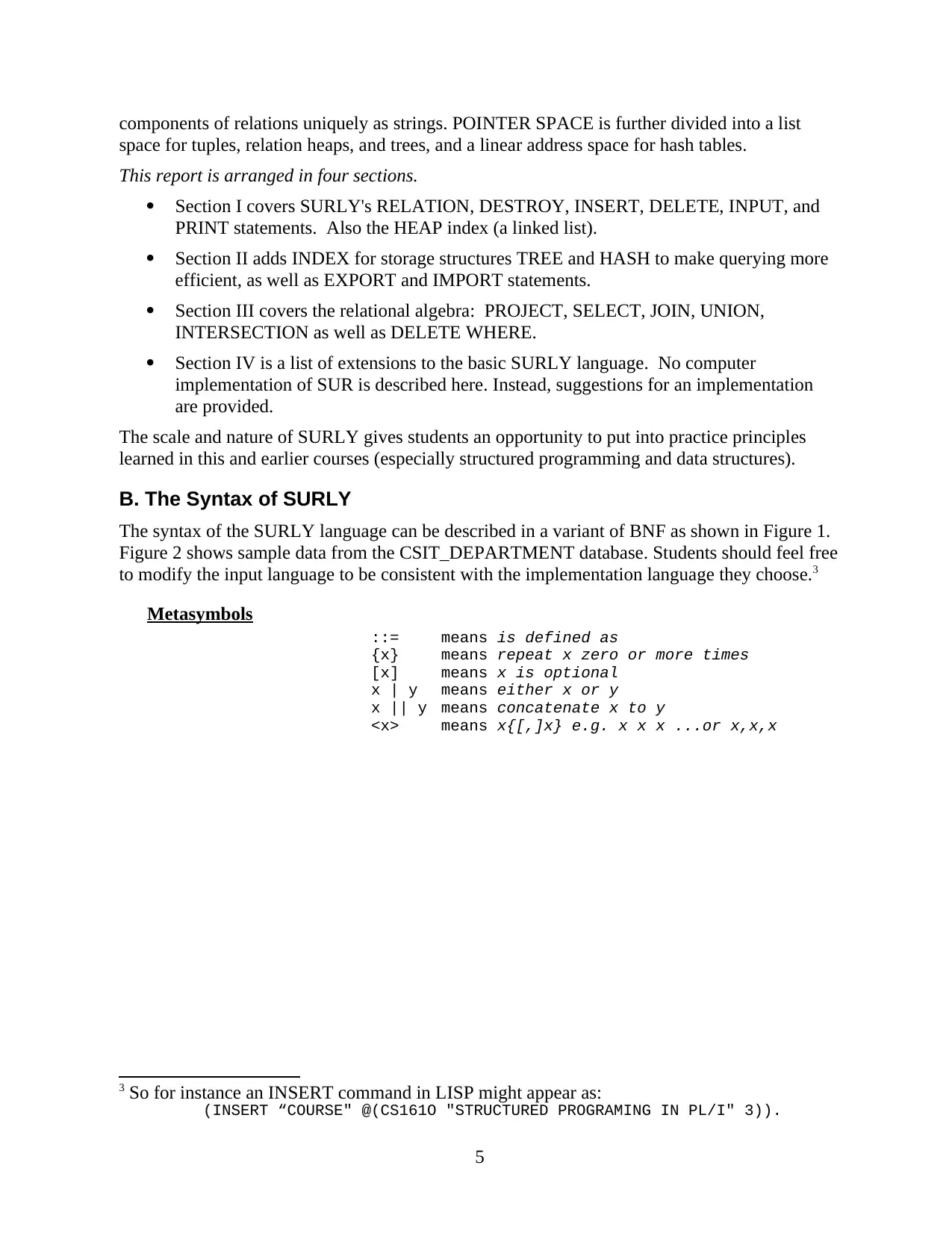
components of relations uniquely as strings. POINTER SPACE is further divided into a list
space for tuples, relation heaps, and trees, and a linear address space for hash tables.
This report is arranged in four sections.
Section I covers SURLY's RELATION, DESTROY, INSERT, DELETE, INPUT, and
PRINT statements. Also the HEAP index (a linked list).
Section II adds INDEX for storage structures TREE and HASH to make querying more
efficient, as well as EXPORT and IMPORT statements.
Section III covers the relational algebra: PROJECT, SELECT, JOIN, UNION,
INTERSECTION as well as DELETE WHERE.
Section IV is a list of extensions to the basic SURLY language. No computer
implementation of SUR is described here. Instead, suggestions for an implementation
are provided.
The scale and nature of SURLY gives students an opportunity to put into practice principles
learned in this and earlier courses (especially structured programming and data structures).
B. The Syntax of SURLY
The syntax of the SURLY language can be described in a variant of BNF as shown in Figure 1.
Figure 2 shows sample data from the CSIT_DEPARTMENT database. Students should feel free
to modify the input language to be consistent with the implementation language they choose.3
Metasymbols
::= means is defined as
{x} means repeat x zero or more times
[x] means x is optional
x | y means either x or y
x || y means concatenate x to y
<x> means x{[,]x} e.g. x x x ...or x,x,x
3 So for instance an INSERT command in LISP might appear as:
(INSERT “COURSE" @(CS161O "STRUCTURED PROGRAMING IN PL/I" 3)).
5
space for tuples, relation heaps, and trees, and a linear address space for hash tables.
This report is arranged in four sections.
Section I covers SURLY's RELATION, DESTROY, INSERT, DELETE, INPUT, and
PRINT statements. Also the HEAP index (a linked list).
Section II adds INDEX for storage structures TREE and HASH to make querying more
efficient, as well as EXPORT and IMPORT statements.
Section III covers the relational algebra: PROJECT, SELECT, JOIN, UNION,
INTERSECTION as well as DELETE WHERE.
Section IV is a list of extensions to the basic SURLY language. No computer
implementation of SUR is described here. Instead, suggestions for an implementation
are provided.
The scale and nature of SURLY gives students an opportunity to put into practice principles
learned in this and earlier courses (especially structured programming and data structures).
B. The Syntax of SURLY
The syntax of the SURLY language can be described in a variant of BNF as shown in Figure 1.
Figure 2 shows sample data from the CSIT_DEPARTMENT database. Students should feel free
to modify the input language to be consistent with the implementation language they choose.3
Metasymbols
::= means is defined as
{x} means repeat x zero or more times
[x] means x is optional
x | y means either x or y
x || y means concatenate x to y
<x> means x{[,]x} e.g. x x x ...or x,x,x
3 So for instance an INSERT command in LISP might appear as:
(INSERT “COURSE" @(CS161O "STRUCTURED PROGRAMING IN PL/I" 3)).
5
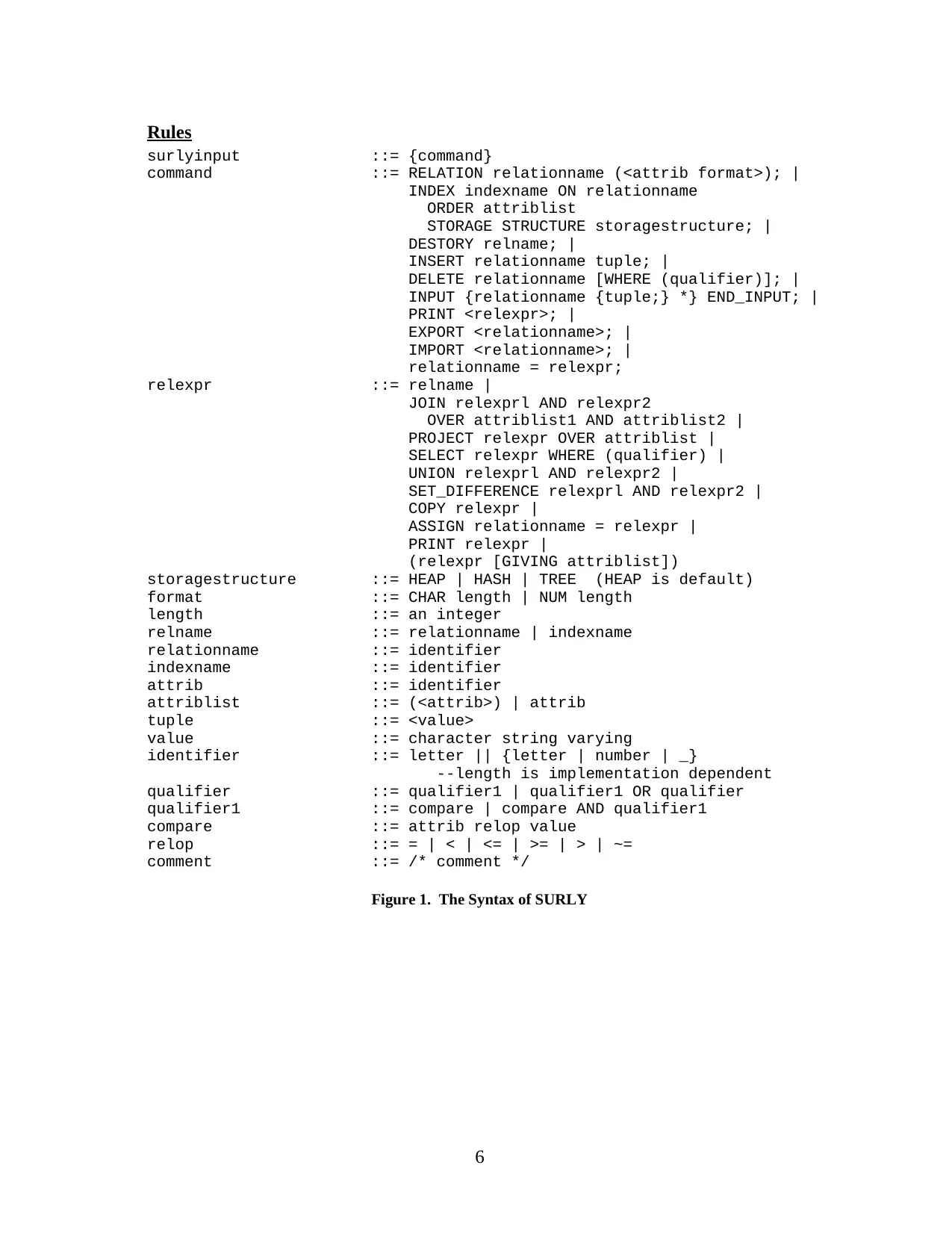
Rules
surlyinput ::= {command}
command ::= RELATION relationname (<attrib format>); |
INDEX indexname ON relationname
ORDER attriblist
STORAGE STRUCTURE storagestructure; |
DESTORY relname; |
INSERT relationname tuple; |
DELETE relationname [WHERE (qualifier)]; |
INPUT {relationname {tuple;} *} END_INPUT; |
PRINT <relexpr>; |
EXPORT <relationname>; |
IMPORT <relationname>; |
relationname = relexpr;
relexpr ::= relname |
JOIN relexprl AND relexpr2
OVER attriblist1 AND attriblist2 |
PROJECT relexpr OVER attriblist |
SELECT relexpr WHERE (qualifier) |
UNION relexprl AND relexpr2 |
SET_DIFFERENCE relexprl AND relexpr2 |
COPY relexpr |
ASSIGN relationname = relexpr |
PRINT relexpr |
(relexpr [GIVING attriblist])
storagestructure ::= HEAP | HASH | TREE (HEAP is default)
format ::= CHAR length | NUM length
length ::= an integer
relname ::= relationname | indexname
relationname ::= identifier
indexname ::= identifier
attrib ::= identifier
attriblist ::= (<attrib>) | attrib
tuple ::= <value>
value ::= character string varying
identifier ::= letter || {letter | number | _}
--length is implementation dependent
qualifier ::= qualifier1 | qualifier1 OR qualifier
qualifier1 ::= compare | compare AND qualifier1
compare ::= attrib relop value
relop ::= = | < | <= | >= | > | ~=
comment ::= /* comment */
Figure 1. The Syntax of SURLY
6
surlyinput ::= {command}
command ::= RELATION relationname (<attrib format>); |
INDEX indexname ON relationname
ORDER attriblist
STORAGE STRUCTURE storagestructure; |
DESTORY relname; |
INSERT relationname tuple; |
DELETE relationname [WHERE (qualifier)]; |
INPUT {relationname {tuple;} *} END_INPUT; |
PRINT <relexpr>; |
EXPORT <relationname>; |
IMPORT <relationname>; |
relationname = relexpr;
relexpr ::= relname |
JOIN relexprl AND relexpr2
OVER attriblist1 AND attriblist2 |
PROJECT relexpr OVER attriblist |
SELECT relexpr WHERE (qualifier) |
UNION relexprl AND relexpr2 |
SET_DIFFERENCE relexprl AND relexpr2 |
COPY relexpr |
ASSIGN relationname = relexpr |
PRINT relexpr |
(relexpr [GIVING attriblist])
storagestructure ::= HEAP | HASH | TREE (HEAP is default)
format ::= CHAR length | NUM length
length ::= an integer
relname ::= relationname | indexname
relationname ::= identifier
indexname ::= identifier
attrib ::= identifier
attriblist ::= (<attrib>) | attrib
tuple ::= <value>
value ::= character string varying
identifier ::= letter || {letter | number | _}
--length is implementation dependent
qualifier ::= qualifier1 | qualifier1 OR qualifier
qualifier1 ::= compare | compare AND qualifier1
compare ::= attrib relop value
relop ::= = | < | <= | >= | > | ~=
comment ::= /* comment */
Figure 1. The Syntax of SURLY
6
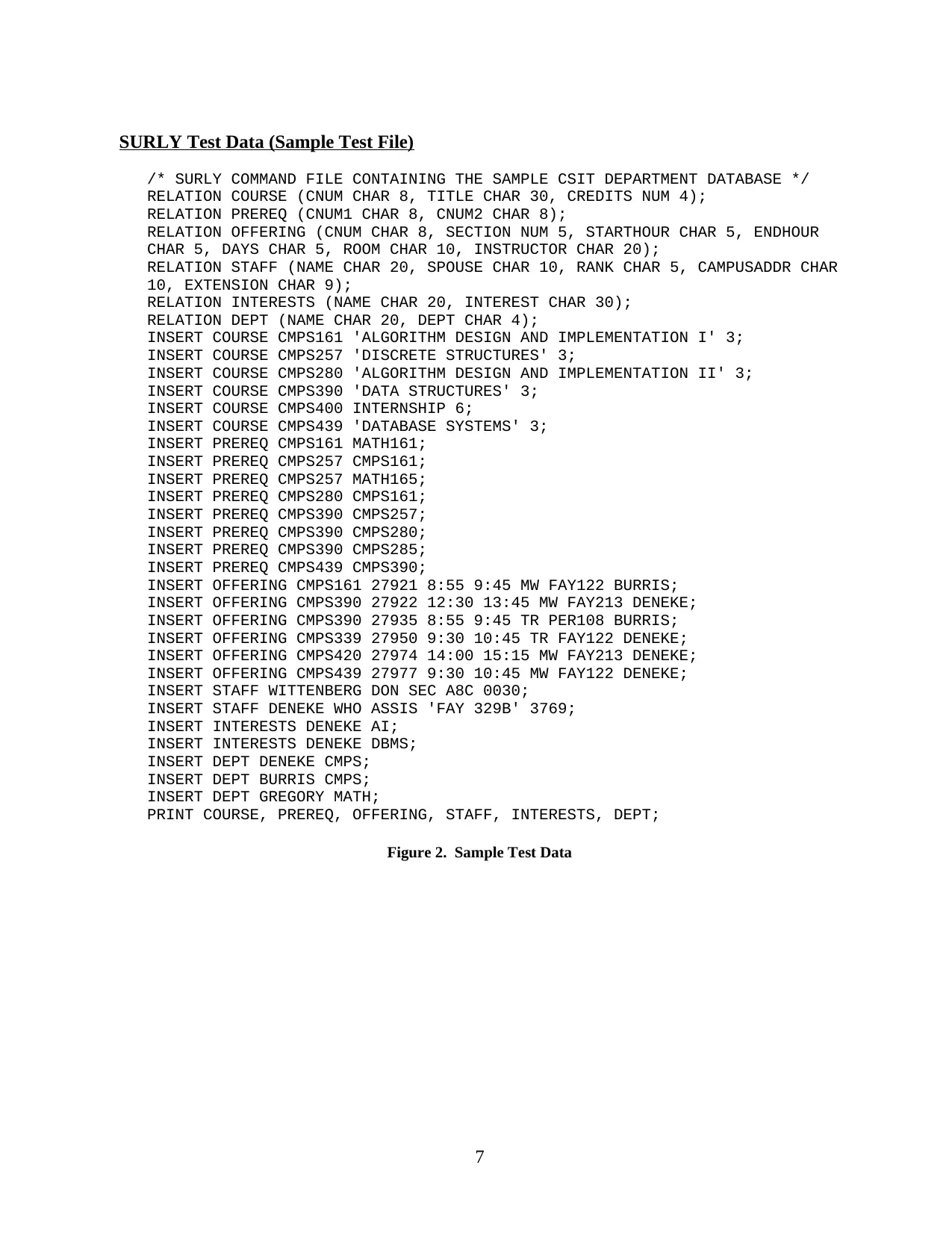
SURLY Test Data (Sample Test File)
/* SURLY COMMAND FILE CONTAINING THE SAMPLE CSIT DEPARTMENT DATABASE */
RELATION COURSE (CNUM CHAR 8, TITLE CHAR 30, CREDITS NUM 4);
RELATION PREREQ (CNUM1 CHAR 8, CNUM2 CHAR 8);
RELATION OFFERING (CNUM CHAR 8, SECTION NUM 5, STARTHOUR CHAR 5, ENDHOUR
CHAR 5, DAYS CHAR 5, ROOM CHAR 10, INSTRUCTOR CHAR 20);
RELATION STAFF (NAME CHAR 20, SPOUSE CHAR 10, RANK CHAR 5, CAMPUSADDR CHAR
10, EXTENSION CHAR 9);
RELATION INTERESTS (NAME CHAR 20, INTEREST CHAR 30);
RELATION DEPT (NAME CHAR 20, DEPT CHAR 4);
INSERT COURSE CMPS161 'ALGORITHM DESIGN AND IMPLEMENTATION I' 3;
INSERT COURSE CMPS257 'DISCRETE STRUCTURES' 3;
INSERT COURSE CMPS280 'ALGORITHM DESIGN AND IMPLEMENTATION II' 3;
INSERT COURSE CMPS390 'DATA STRUCTURES' 3;
INSERT COURSE CMPS400 INTERNSHIP 6;
INSERT COURSE CMPS439 'DATABASE SYSTEMS' 3;
INSERT PREREQ CMPS161 MATH161;
INSERT PREREQ CMPS257 CMPS161;
INSERT PREREQ CMPS257 MATH165;
INSERT PREREQ CMPS280 CMPS161;
INSERT PREREQ CMPS390 CMPS257;
INSERT PREREQ CMPS390 CMPS280;
INSERT PREREQ CMPS390 CMPS285;
INSERT PREREQ CMPS439 CMPS390;
INSERT OFFERING CMPS161 27921 8:55 9:45 MW FAY122 BURRIS;
INSERT OFFERING CMPS390 27922 12:30 13:45 MW FAY213 DENEKE;
INSERT OFFERING CMPS390 27935 8:55 9:45 TR PER108 BURRIS;
INSERT OFFERING CMPS339 27950 9:30 10:45 TR FAY122 DENEKE;
INSERT OFFERING CMPS420 27974 14:00 15:15 MW FAY213 DENEKE;
INSERT OFFERING CMPS439 27977 9:30 10:45 MW FAY122 DENEKE;
INSERT STAFF WITTENBERG DON SEC A8C 0030;
INSERT STAFF DENEKE WHO ASSIS 'FAY 329B' 3769;
INSERT INTERESTS DENEKE AI;
INSERT INTERESTS DENEKE DBMS;
INSERT DEPT DENEKE CMPS;
INSERT DEPT BURRIS CMPS;
INSERT DEPT GREGORY MATH;
PRINT COURSE, PREREQ, OFFERING, STAFF, INTERESTS, DEPT;
Figure 2. Sample Test Data
7
/* SURLY COMMAND FILE CONTAINING THE SAMPLE CSIT DEPARTMENT DATABASE */
RELATION COURSE (CNUM CHAR 8, TITLE CHAR 30, CREDITS NUM 4);
RELATION PREREQ (CNUM1 CHAR 8, CNUM2 CHAR 8);
RELATION OFFERING (CNUM CHAR 8, SECTION NUM 5, STARTHOUR CHAR 5, ENDHOUR
CHAR 5, DAYS CHAR 5, ROOM CHAR 10, INSTRUCTOR CHAR 20);
RELATION STAFF (NAME CHAR 20, SPOUSE CHAR 10, RANK CHAR 5, CAMPUSADDR CHAR
10, EXTENSION CHAR 9);
RELATION INTERESTS (NAME CHAR 20, INTEREST CHAR 30);
RELATION DEPT (NAME CHAR 20, DEPT CHAR 4);
INSERT COURSE CMPS161 'ALGORITHM DESIGN AND IMPLEMENTATION I' 3;
INSERT COURSE CMPS257 'DISCRETE STRUCTURES' 3;
INSERT COURSE CMPS280 'ALGORITHM DESIGN AND IMPLEMENTATION II' 3;
INSERT COURSE CMPS390 'DATA STRUCTURES' 3;
INSERT COURSE CMPS400 INTERNSHIP 6;
INSERT COURSE CMPS439 'DATABASE SYSTEMS' 3;
INSERT PREREQ CMPS161 MATH161;
INSERT PREREQ CMPS257 CMPS161;
INSERT PREREQ CMPS257 MATH165;
INSERT PREREQ CMPS280 CMPS161;
INSERT PREREQ CMPS390 CMPS257;
INSERT PREREQ CMPS390 CMPS280;
INSERT PREREQ CMPS390 CMPS285;
INSERT PREREQ CMPS439 CMPS390;
INSERT OFFERING CMPS161 27921 8:55 9:45 MW FAY122 BURRIS;
INSERT OFFERING CMPS390 27922 12:30 13:45 MW FAY213 DENEKE;
INSERT OFFERING CMPS390 27935 8:55 9:45 TR PER108 BURRIS;
INSERT OFFERING CMPS339 27950 9:30 10:45 TR FAY122 DENEKE;
INSERT OFFERING CMPS420 27974 14:00 15:15 MW FAY213 DENEKE;
INSERT OFFERING CMPS439 27977 9:30 10:45 MW FAY122 DENEKE;
INSERT STAFF WITTENBERG DON SEC A8C 0030;
INSERT STAFF DENEKE WHO ASSIS 'FAY 329B' 3769;
INSERT INTERESTS DENEKE AI;
INSERT INTERESTS DENEKE DBMS;
INSERT DEPT DENEKE CMPS;
INSERT DEPT BURRIS CMPS;
INSERT DEPT GREGORY MATH;
PRINT COURSE, PREREQ, OFFERING, STAFF, INTERESTS, DEPT;
Figure 2. Sample Test Data
7
Secure Best Marks with AI Grader
Need help grading? Try our AI Grader for instant feedback on your assignments.
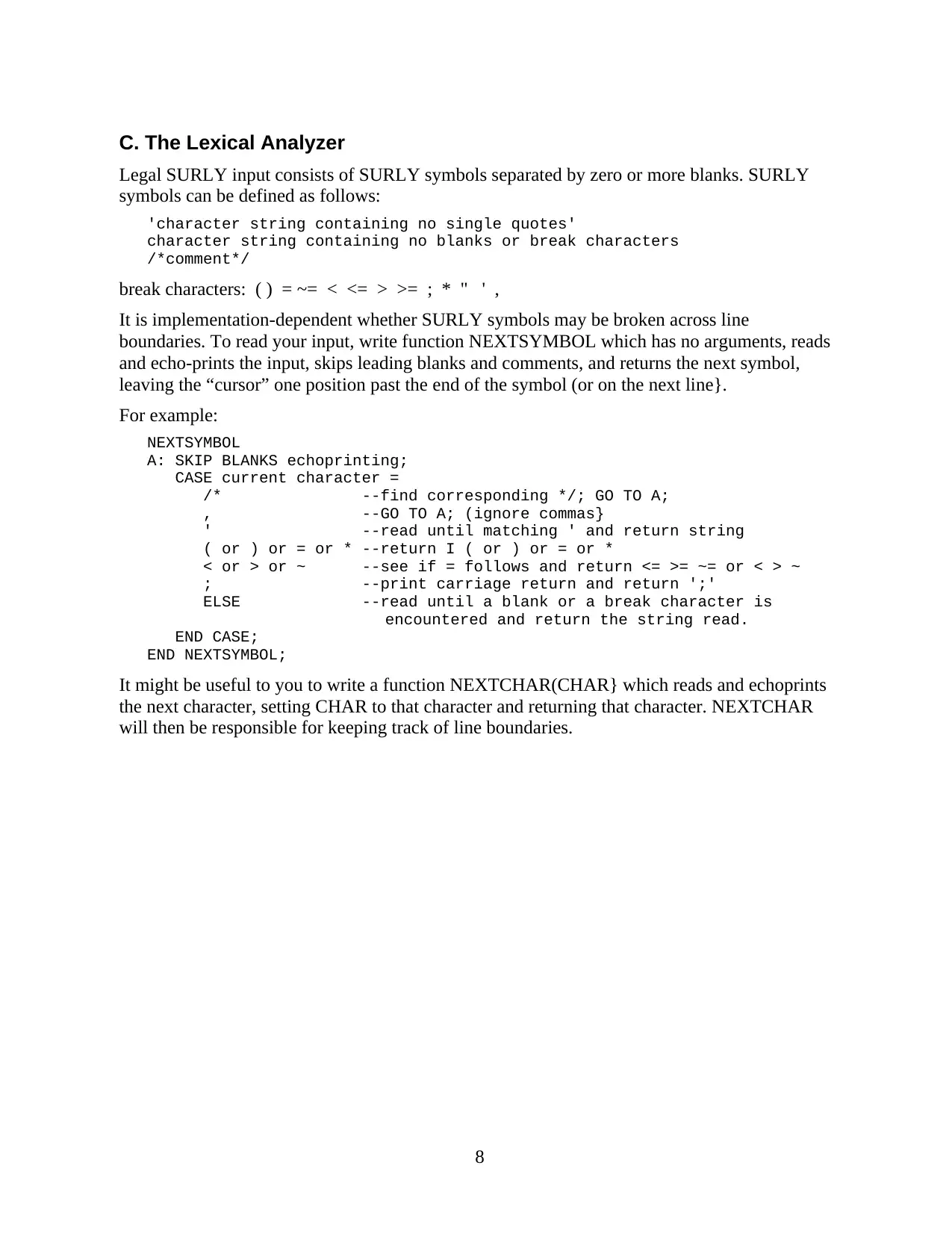
C. The Lexical Analyzer
Legal SURLY input consists of SURLY symbols separated by zero or more blanks. SURLY
symbols can be defined as follows:
'character string containing no single quotes'
character string containing no blanks or break characters
/*comment*/
break characters: ( ) = ~= < <= > >= ; * " ' ,
It is implementation-dependent whether SURLY symbols may be broken across line
boundaries. To read your input, write function NEXTSYMBOL which has no arguments, reads
and echo-prints the input, skips leading blanks and comments, and returns the next symbol,
leaving the “cursor” one position past the end of the symbol (or on the next line}.
For example:
NEXTSYMBOL
A: SKIP BLANKS echoprinting;
CASE current character =
/* --find corresponding */; GO TO A;
, --GO TO A; (ignore commas}
' --read until matching ' and return string
( or ) or = or * --return I ( or ) or = or *
< or > or ~ --see if = follows and return <= >= ~= or < > ~
; --print carriage return and return ';'
ELSE --read until a blank or a break character is
encountered and return the string read.
END CASE;
END NEXTSYMBOL;
It might be useful to you to write a function NEXTCHAR(CHAR} which reads and echoprints
the next character, setting CHAR to that character and returning that character. NEXTCHAR
will then be responsible for keeping track of line boundaries.
8
Legal SURLY input consists of SURLY symbols separated by zero or more blanks. SURLY
symbols can be defined as follows:
'character string containing no single quotes'
character string containing no blanks or break characters
/*comment*/
break characters: ( ) = ~= < <= > >= ; * " ' ,
It is implementation-dependent whether SURLY symbols may be broken across line
boundaries. To read your input, write function NEXTSYMBOL which has no arguments, reads
and echo-prints the input, skips leading blanks and comments, and returns the next symbol,
leaving the “cursor” one position past the end of the symbol (or on the next line}.
For example:
NEXTSYMBOL
A: SKIP BLANKS echoprinting;
CASE current character =
/* --find corresponding */; GO TO A;
, --GO TO A; (ignore commas}
' --read until matching ' and return string
( or ) or = or * --return I ( or ) or = or *
< or > or ~ --see if = follows and return <= >= ~= or < > ~
; --print carriage return and return ';'
ELSE --read until a blank or a break character is
encountered and return the string read.
END CASE;
END NEXTSYMBOL;
It might be useful to you to write a function NEXTCHAR(CHAR} which reads and echoprints
the next character, setting CHAR to that character and returning that character. NEXTCHAR
will then be responsible for keeping track of line boundaries.
8
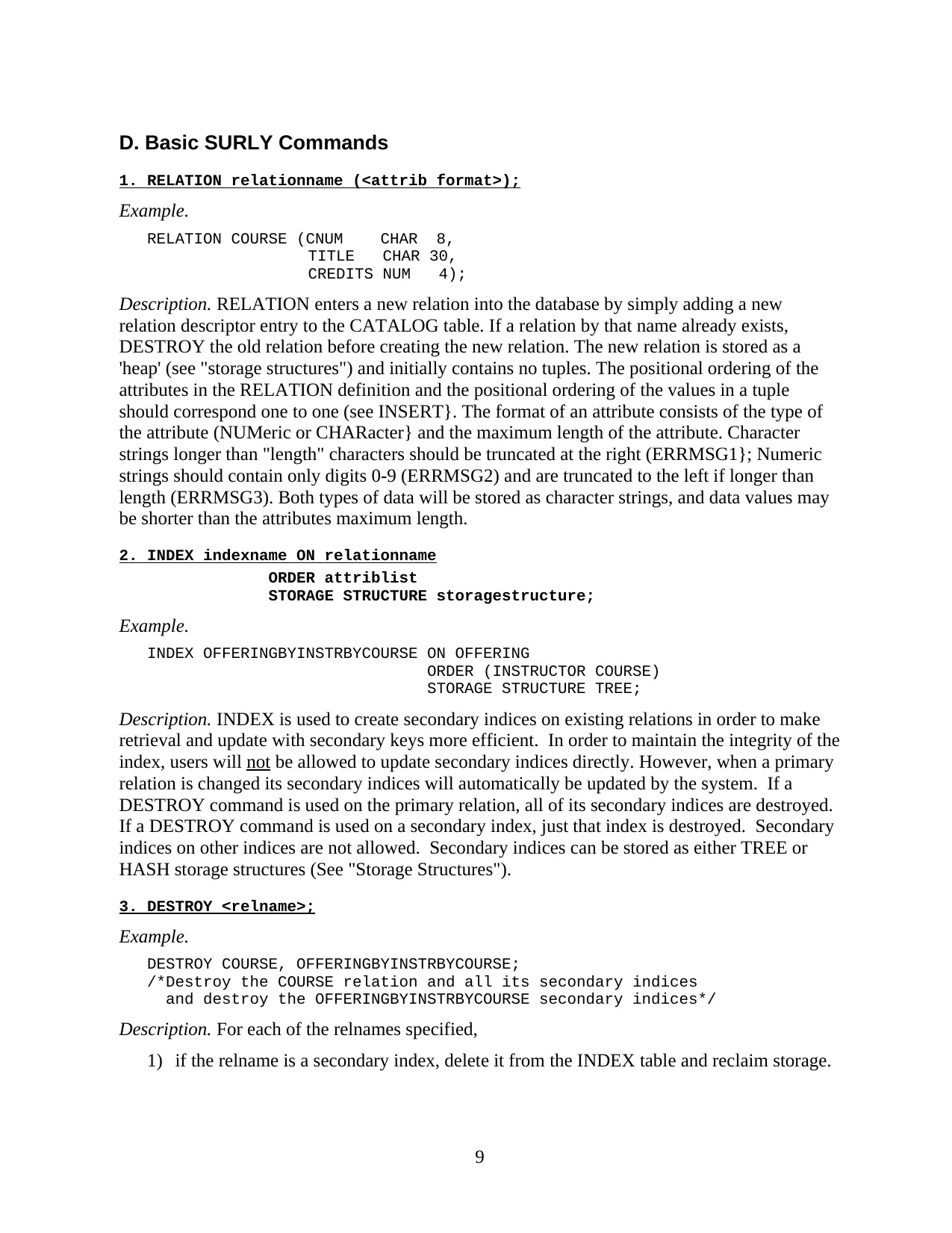
D. Basic SURLY Commands
1. RELATION relationname (<attrib format>);
Example.
RELATION COURSE (CNUM CHAR 8,
TITLE CHAR 30,
CREDITS NUM 4);
Description. RELATION enters a new relation into the database by simply adding a new
relation descriptor entry to the CATALOG table. If a relation by that name already exists,
DESTROY the old relation before creating the new relation. The new relation is stored as a
'heap' (see "storage structures") and initially contains no tuples. The positional ordering of the
attributes in the RELATION definition and the positional ordering of the values in a tuple
should correspond one to one (see INSERT}. The format of an attribute consists of the type of
the attribute (NUMeric or CHARacter} and the maximum length of the attribute. Character
strings longer than "length" characters should be truncated at the right (ERRMSG1}; Numeric
strings should contain only digits 0-9 (ERRMSG2) and are truncated to the left if longer than
length (ERRMSG3). Both types of data will be stored as character strings, and data values may
be shorter than the attributes maximum length.
2. INDEX indexname ON relationname
ORDER attriblist
STORAGE STRUCTURE storagestructure;
Example.
INDEX OFFERINGBYINSTRBYCOURSE ON OFFERING
ORDER (INSTRUCTOR COURSE)
STORAGE STRUCTURE TREE;
Description. INDEX is used to create secondary indices on existing relations in order to make
retrieval and update with secondary keys more efficient. In order to maintain the integrity of the
index, users will not be allowed to update secondary indices directly. However, when a primary
relation is changed its secondary indices will automatically be updated by the system. If a
DESTROY command is used on the primary relation, all of its secondary indices are destroyed.
If a DESTROY command is used on a secondary index, just that index is destroyed. Secondary
indices on other indices are not allowed. Secondary indices can be stored as either TREE or
HASH storage structures (See "Storage Structures").
3. DESTROY <relname>;
Example.
DESTROY COURSE, OFFERINGBYINSTRBYCOURSE;
/*Destroy the COURSE relation and all its secondary indices
and destroy the OFFERINGBYINSTRBYCOURSE secondary indices*/
Description. For each of the relnames specified,
1) if the relname is a secondary index, delete it from the INDEX table and reclaim storage.
9
1. RELATION relationname (<attrib format>);
Example.
RELATION COURSE (CNUM CHAR 8,
TITLE CHAR 30,
CREDITS NUM 4);
Description. RELATION enters a new relation into the database by simply adding a new
relation descriptor entry to the CATALOG table. If a relation by that name already exists,
DESTROY the old relation before creating the new relation. The new relation is stored as a
'heap' (see "storage structures") and initially contains no tuples. The positional ordering of the
attributes in the RELATION definition and the positional ordering of the values in a tuple
should correspond one to one (see INSERT}. The format of an attribute consists of the type of
the attribute (NUMeric or CHARacter} and the maximum length of the attribute. Character
strings longer than "length" characters should be truncated at the right (ERRMSG1}; Numeric
strings should contain only digits 0-9 (ERRMSG2) and are truncated to the left if longer than
length (ERRMSG3). Both types of data will be stored as character strings, and data values may
be shorter than the attributes maximum length.
2. INDEX indexname ON relationname
ORDER attriblist
STORAGE STRUCTURE storagestructure;
Example.
INDEX OFFERINGBYINSTRBYCOURSE ON OFFERING
ORDER (INSTRUCTOR COURSE)
STORAGE STRUCTURE TREE;
Description. INDEX is used to create secondary indices on existing relations in order to make
retrieval and update with secondary keys more efficient. In order to maintain the integrity of the
index, users will not be allowed to update secondary indices directly. However, when a primary
relation is changed its secondary indices will automatically be updated by the system. If a
DESTROY command is used on the primary relation, all of its secondary indices are destroyed.
If a DESTROY command is used on a secondary index, just that index is destroyed. Secondary
indices on other indices are not allowed. Secondary indices can be stored as either TREE or
HASH storage structures (See "Storage Structures").
3. DESTROY <relname>;
Example.
DESTROY COURSE, OFFERINGBYINSTRBYCOURSE;
/*Destroy the COURSE relation and all its secondary indices
and destroy the OFFERINGBYINSTRBYCOURSE secondary indices*/
Description. For each of the relnames specified,
1) if the relname is a secondary index, delete it from the INDEX table and reclaim storage.
9
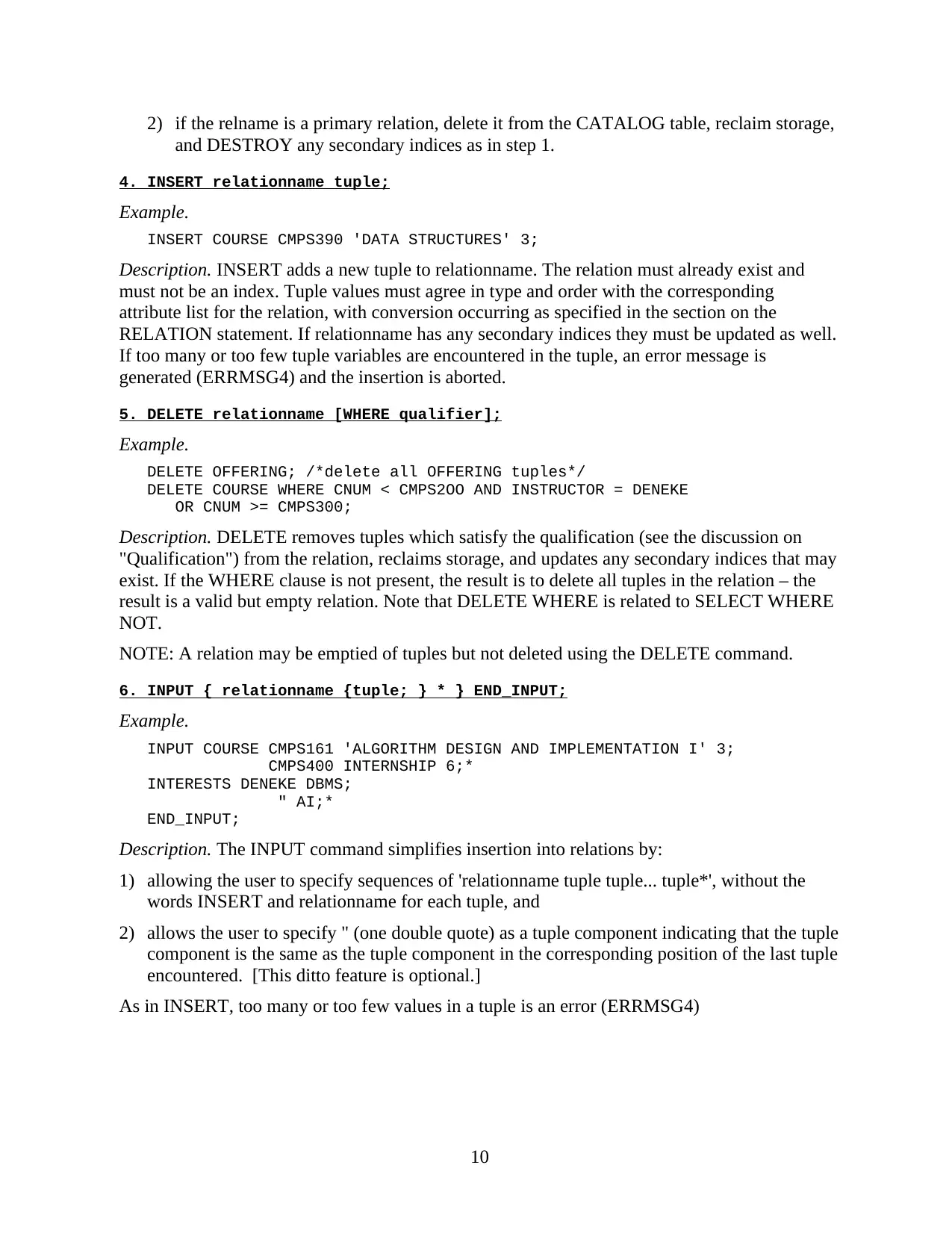
2) if the relname is a primary relation, delete it from the CATALOG table, reclaim storage,
and DESTROY any secondary indices as in step 1.
4. INSERT relationname tuple;
Example.
INSERT COURSE CMPS390 'DATA STRUCTURES' 3;
Description. INSERT adds a new tuple to relationname. The relation must already exist and
must not be an index. Tuple values must agree in type and order with the corresponding
attribute list for the relation, with conversion occurring as specified in the section on the
RELATION statement. If relationname has any secondary indices they must be updated as well.
If too many or too few tuple variables are encountered in the tuple, an error message is
generated (ERRMSG4) and the insertion is aborted.
5. DELETE relationname [WHERE qualifier];
Example.
DELETE OFFERING; /*delete all OFFERING tuples*/
DELETE COURSE WHERE CNUM < CMPS2OO AND INSTRUCTOR = DENEKE
OR CNUM >= CMPS300;
Description. DELETE removes tuples which satisfy the qualification (see the discussion on
"Qualification") from the relation, reclaims storage, and updates any secondary indices that may
exist. If the WHERE clause is not present, the result is to delete all tuples in the relation – the
result is a valid but empty relation. Note that DELETE WHERE is related to SELECT WHERE
NOT.
NOTE: A relation may be emptied of tuples but not deleted using the DELETE command.
6. INPUT { relationname {tuple; } * } END_INPUT;
Example.
INPUT COURSE CMPS161 'ALGORITHM DESIGN AND IMPLEMENTATION I' 3;
CMPS400 INTERNSHIP 6;*
INTERESTS DENEKE DBMS;
" AI;*
END_INPUT;
Description. The INPUT command simplifies insertion into relations by:
1) allowing the user to specify sequences of 'relationname tuple tuple... tuple*', without the
words INSERT and relationname for each tuple, and
2) allows the user to specify " (one double quote) as a tuple component indicating that the tuple
component is the same as the tuple component in the corresponding position of the last tuple
encountered. [This ditto feature is optional.]
As in INSERT, too many or too few values in a tuple is an error (ERRMSG4)
10
and DESTROY any secondary indices as in step 1.
4. INSERT relationname tuple;
Example.
INSERT COURSE CMPS390 'DATA STRUCTURES' 3;
Description. INSERT adds a new tuple to relationname. The relation must already exist and
must not be an index. Tuple values must agree in type and order with the corresponding
attribute list for the relation, with conversion occurring as specified in the section on the
RELATION statement. If relationname has any secondary indices they must be updated as well.
If too many or too few tuple variables are encountered in the tuple, an error message is
generated (ERRMSG4) and the insertion is aborted.
5. DELETE relationname [WHERE qualifier];
Example.
DELETE OFFERING; /*delete all OFFERING tuples*/
DELETE COURSE WHERE CNUM < CMPS2OO AND INSTRUCTOR = DENEKE
OR CNUM >= CMPS300;
Description. DELETE removes tuples which satisfy the qualification (see the discussion on
"Qualification") from the relation, reclaims storage, and updates any secondary indices that may
exist. If the WHERE clause is not present, the result is to delete all tuples in the relation – the
result is a valid but empty relation. Note that DELETE WHERE is related to SELECT WHERE
NOT.
NOTE: A relation may be emptied of tuples but not deleted using the DELETE command.
6. INPUT { relationname {tuple; } * } END_INPUT;
Example.
INPUT COURSE CMPS161 'ALGORITHM DESIGN AND IMPLEMENTATION I' 3;
CMPS400 INTERNSHIP 6;*
INTERESTS DENEKE DBMS;
" AI;*
END_INPUT;
Description. The INPUT command simplifies insertion into relations by:
1) allowing the user to specify sequences of 'relationname tuple tuple... tuple*', without the
words INSERT and relationname for each tuple, and
2) allows the user to specify " (one double quote) as a tuple component indicating that the tuple
component is the same as the tuple component in the corresponding position of the last tuple
encountered. [This ditto feature is optional.]
As in INSERT, too many or too few values in a tuple is an error (ERRMSG4)
10
Paraphrase This Document
Need a fresh take? Get an instant paraphrase of this document with our AI Paraphraser
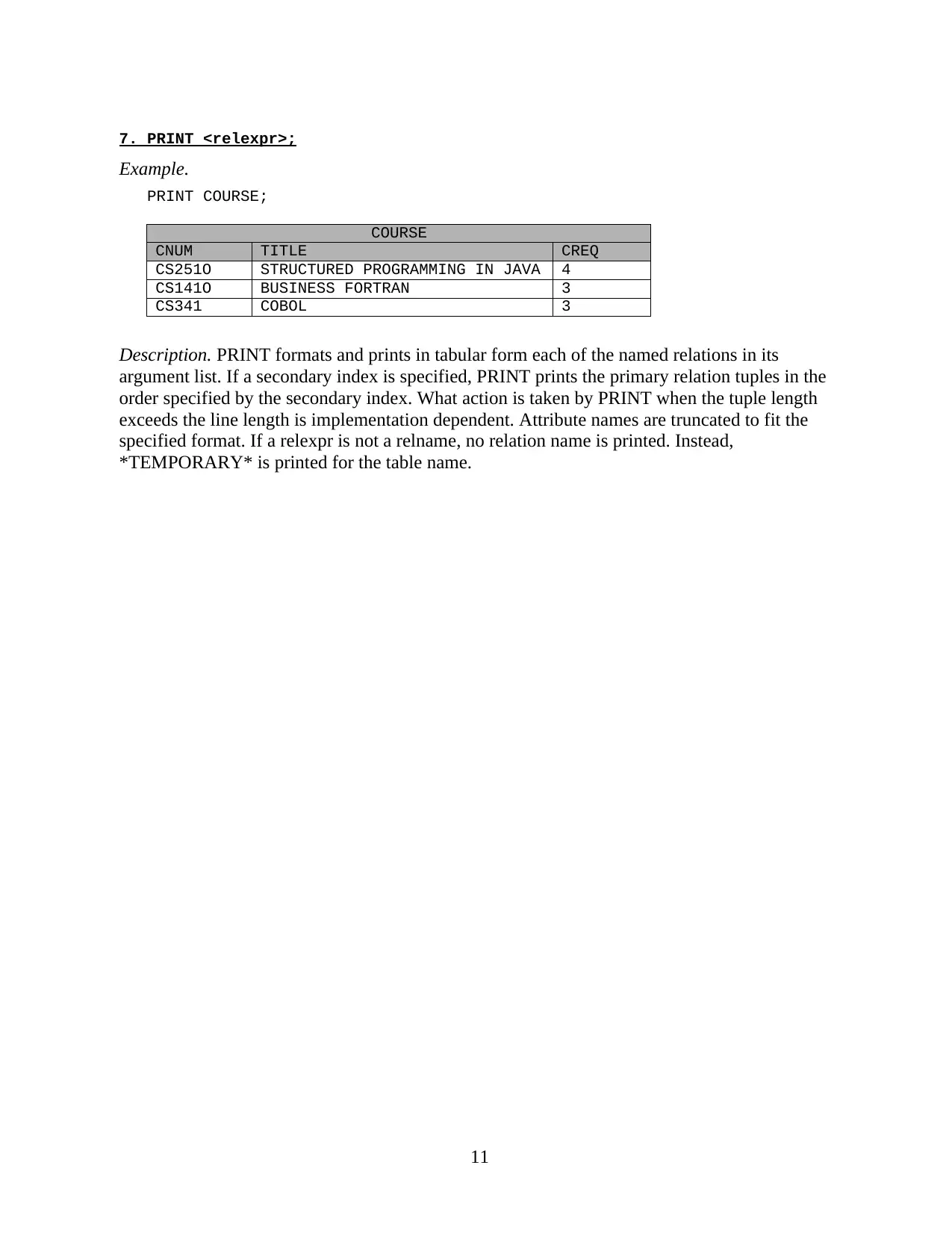
7. PRINT <relexpr>;
Example.
PRINT COURSE;
COURSE
CNUM TITLE CREQ
CS251O STRUCTURED PROGRAMMING IN JAVA 4
CS141O BUSINESS FORTRAN 3
CS341 COBOL 3
Description. PRINT formats and prints in tabular form each of the named relations in its
argument list. If a secondary index is specified, PRINT prints the primary relation tuples in the
order specified by the secondary index. What action is taken by PRINT when the tuple length
exceeds the line length is implementation dependent. Attribute names are truncated to fit the
specified format. If a relexpr is not a relname, no relation name is printed. Instead,
*TEMPORARY* is printed for the table name.
11
Example.
PRINT COURSE;
COURSE
CNUM TITLE CREQ
CS251O STRUCTURED PROGRAMMING IN JAVA 4
CS141O BUSINESS FORTRAN 3
CS341 COBOL 3
Description. PRINT formats and prints in tabular form each of the named relations in its
argument list. If a secondary index is specified, PRINT prints the primary relation tuples in the
order specified by the secondary index. What action is taken by PRINT when the tuple length
exceeds the line length is implementation dependent. Attribute names are truncated to fit the
specified format. If a relexpr is not a relname, no relation name is printed. Instead,
*TEMPORARY* is printed for the table name.
11
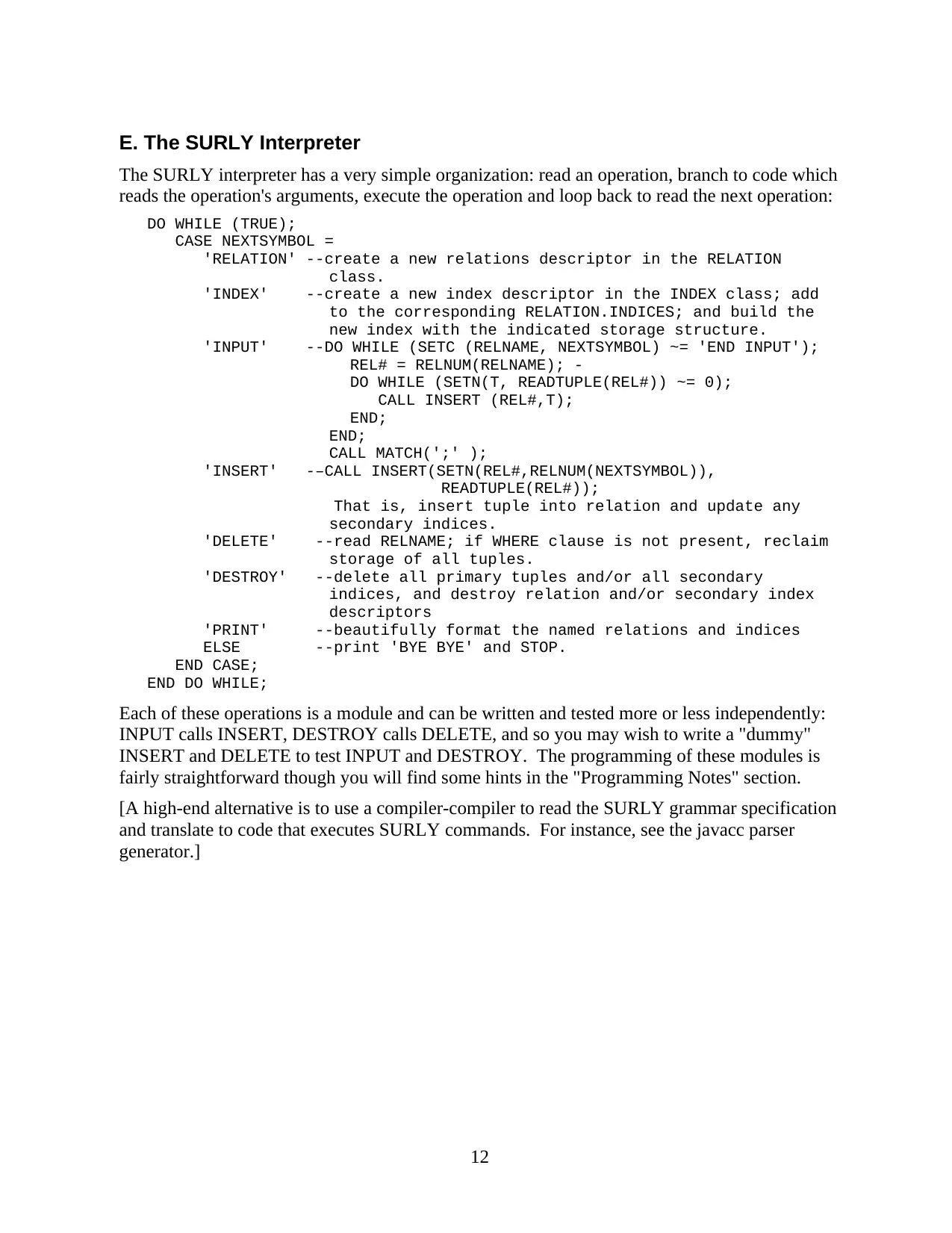
E. The SURLY Interpreter
The SURLY interpreter has a very simple organization: read an operation, branch to code which
reads the operation's arguments, execute the operation and loop back to read the next operation:
DO WHILE (TRUE);
CASE NEXTSYMBOL =
'RELATION' --create a new relations descriptor in the RELATION
class.
'INDEX' --create a new index descriptor in the INDEX class; add
to the corresponding RELATION.INDICES; and build the
new index with the indicated storage structure.
'INPUT' --DO WHILE (SETC (RELNAME, NEXTSYMBOL) ~= 'END INPUT');
REL# = RELNUM(RELNAME); -
DO WHILE (SETN(T, READTUPLE(REL#)) ~= 0);
CALL INSERT (REL#,T);
END;
END;
CALL MATCH(';' );
'INSERT' -–CALL INSERT(SETN(REL#,RELNUM(NEXTSYMBOL)),
READTUPLE(REL#));
That is, insert tuple into relation and update any
secondary indices.
'DELETE' --read RELNAME; if WHERE clause is not present, reclaim
storage of all tuples.
'DESTROY' --delete all primary tuples and/or all secondary
indices, and destroy relation and/or secondary index
descriptors
'PRINT' --beautifully format the named relations and indices
ELSE --print 'BYE BYE' and STOP.
END CASE;
END DO WHILE;
Each of these operations is a module and can be written and tested more or less independently:
INPUT calls INSERT, DESTROY calls DELETE, and so you may wish to write a "dummy"
INSERT and DELETE to test INPUT and DESTROY. The programming of these modules is
fairly straightforward though you will find some hints in the "Programming Notes" section.
[A high-end alternative is to use a compiler-compiler to read the SURLY grammar specification
and translate to code that executes SURLY commands. For instance, see the javacc parser
generator.]
12
The SURLY interpreter has a very simple organization: read an operation, branch to code which
reads the operation's arguments, execute the operation and loop back to read the next operation:
DO WHILE (TRUE);
CASE NEXTSYMBOL =
'RELATION' --create a new relations descriptor in the RELATION
class.
'INDEX' --create a new index descriptor in the INDEX class; add
to the corresponding RELATION.INDICES; and build the
new index with the indicated storage structure.
'INPUT' --DO WHILE (SETC (RELNAME, NEXTSYMBOL) ~= 'END INPUT');
REL# = RELNUM(RELNAME); -
DO WHILE (SETN(T, READTUPLE(REL#)) ~= 0);
CALL INSERT (REL#,T);
END;
END;
CALL MATCH(';' );
'INSERT' -–CALL INSERT(SETN(REL#,RELNUM(NEXTSYMBOL)),
READTUPLE(REL#));
That is, insert tuple into relation and update any
secondary indices.
'DELETE' --read RELNAME; if WHERE clause is not present, reclaim
storage of all tuples.
'DESTROY' --delete all primary tuples and/or all secondary
indices, and destroy relation and/or secondary index
descriptors
'PRINT' --beautifully format the named relations and indices
ELSE --print 'BYE BYE' and STOP.
END CASE;
END DO WHILE;
Each of these operations is a module and can be written and tested more or less independently:
INPUT calls INSERT, DESTROY calls DELETE, and so you may wish to write a "dummy"
INSERT and DELETE to test INPUT and DESTROY. The programming of these modules is
fairly straightforward though you will find some hints in the "Programming Notes" section.
[A high-end alternative is to use a compiler-compiler to read the SURLY grammar specification
and translate to code that executes SURLY commands. For instance, see the javacc parser
generator.]
12
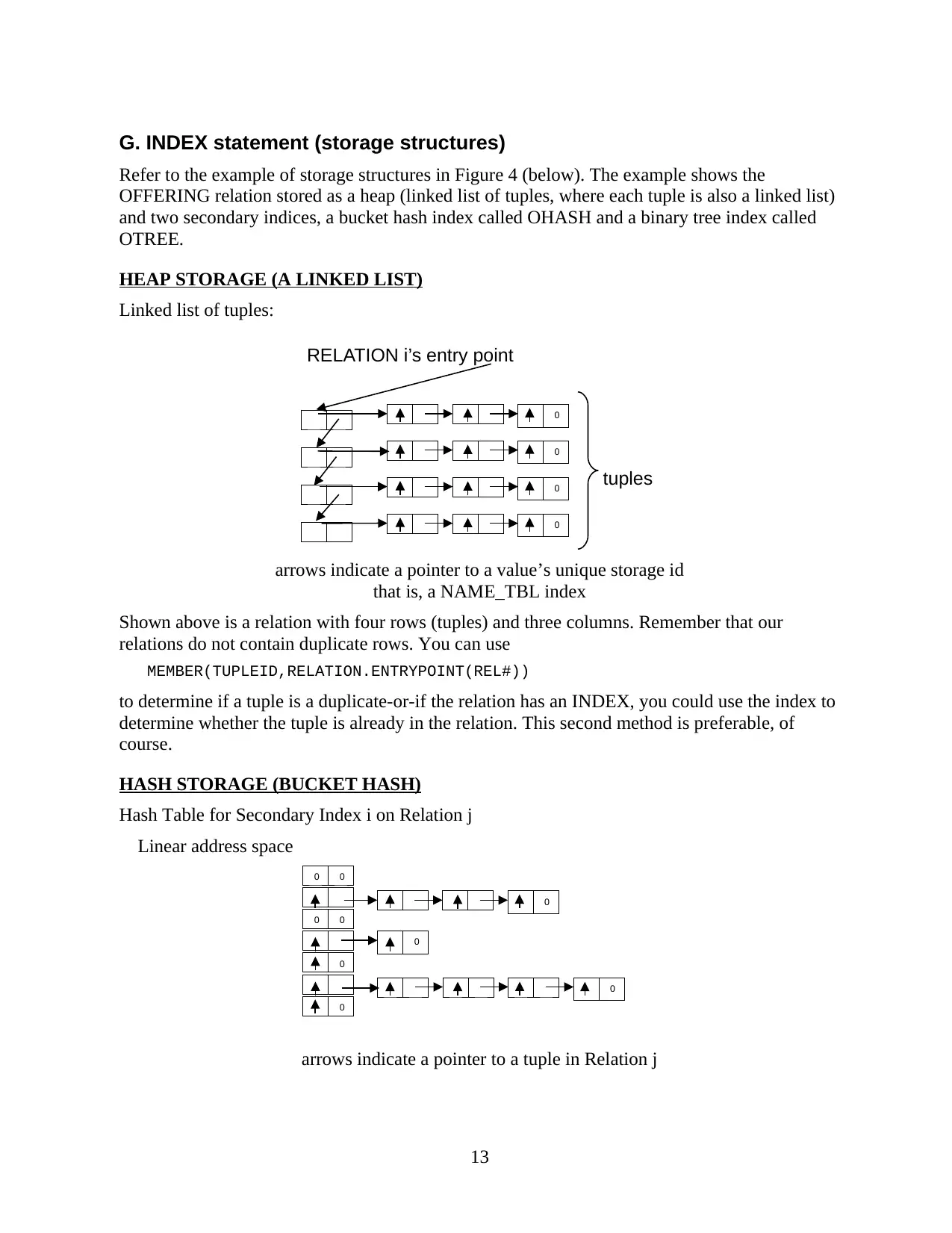
G. INDEX statement (storage structures)
Refer to the example of storage structures in Figure 4 (below). The example shows the
OFFERING relation stored as a heap (linked list of tuples, where each tuple is also a linked list)
and two secondary indices, a bucket hash index called OHASH and a binary tree index called
OTREE.
HEAP STORAGE (A LINKED LIST)
Linked list of tuples:
arrows indicate a pointer to a value’s unique storage id
that is, a NAME_TBL index
Shown above is a relation with four rows (tuples) and three columns. Remember that our
relations do not contain duplicate rows. You can use
MEMBER(TUPLEID,RELATION.ENTRYPOINT(REL#))
to determine if a tuple is a duplicate-or-if the relation has an INDEX, you could use the index to
determine whether the tuple is already in the relation. This second method is preferable, of
course.
HASH STORAGE (BUCKET HASH)
Hash Table for Secondary Index i on Relation j
Linear address space
arrows indicate a pointer to a tuple in Relation j
0
0
0
0
tuples
RELATION i’s entry point
0
0 0
0 0
0
0
0
0
13
Refer to the example of storage structures in Figure 4 (below). The example shows the
OFFERING relation stored as a heap (linked list of tuples, where each tuple is also a linked list)
and two secondary indices, a bucket hash index called OHASH and a binary tree index called
OTREE.
HEAP STORAGE (A LINKED LIST)
Linked list of tuples:
arrows indicate a pointer to a value’s unique storage id
that is, a NAME_TBL index
Shown above is a relation with four rows (tuples) and three columns. Remember that our
relations do not contain duplicate rows. You can use
MEMBER(TUPLEID,RELATION.ENTRYPOINT(REL#))
to determine if a tuple is a duplicate-or-if the relation has an INDEX, you could use the index to
determine whether the tuple is already in the relation. This second method is preferable, of
course.
HASH STORAGE (BUCKET HASH)
Hash Table for Secondary Index i on Relation j
Linear address space
arrows indicate a pointer to a tuple in Relation j
0
0
0
0
tuples
RELATION i’s entry point
0
0 0
0 0
0
0
0
0
13
Secure Best Marks with AI Grader
Need help grading? Try our AI Grader for instant feedback on your assignments.
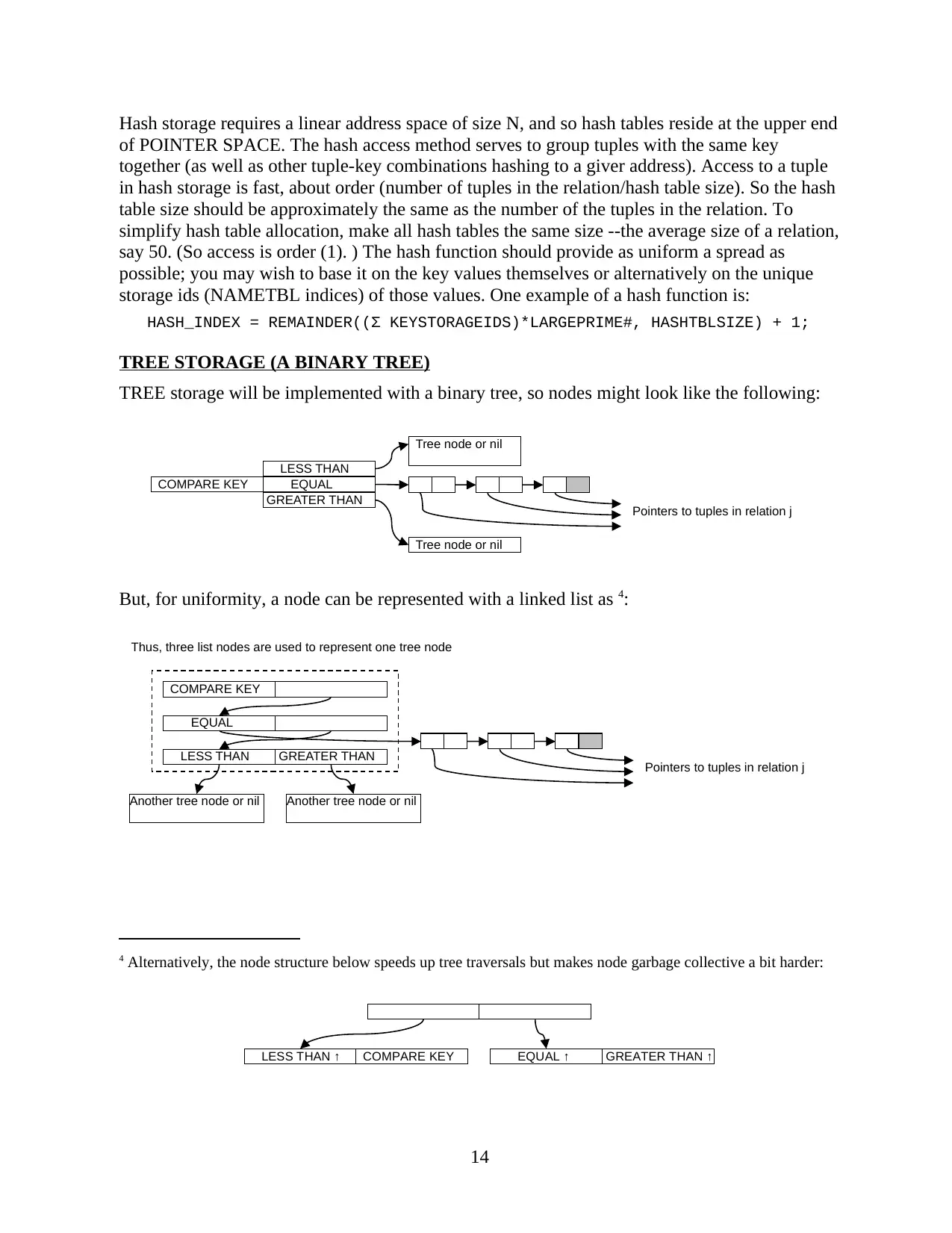
Hash storage requires a linear address space of size N, and so hash tables reside at the upper end
of POINTER SPACE. The hash access method serves to group tuples with the same key
together (as well as other tuple-key combinations hashing to a giver address). Access to a tuple
in hash storage is fast, about order (number of tuples in the relation/hash table size). So the hash
table size should be approximately the same as the number of the tuples in the relation. To
simplify hash table allocation, make all hash tables the same size --the average size of a relation,
say 50. (So access is order (1). ) The hash function should provide as uniform a spread as
possible; you may wish to base it on the key values themselves or alternatively on the unique
storage ids (NAMETBL indices) of those values. One example of a hash function is:
HASH_INDEX = REMAINDER((Σ KEYSTORAGEIDS)*LARGEPRIME#, HASHTBLSIZE) + 1;
TREE STORAGE (A BINARY TREE)
TREE storage will be implemented with a binary tree, so nodes might look like the following:
But, for uniformity, a node can be represented with a linked list as 4:
4 Alternatively, the node structure below speeds up tree traversals but makes node garbage collective a bit harder:
COMPARE KEYLESS THAN ↑ GREATER THAN ↑EQUAL ↑
Tree node or nil
COMPARE KEY
LESS THAN
GREATER THAN
EQUAL
Tree node or nil
Pointers to tuples in relation j
Thus, three list nodes are used to represent one tree node
COMPARE KEY
LESS THAN GREATER THAN
EQUAL
Another tree node or nil
Pointers to tuples in relation j
Another tree node or nil
14
of POINTER SPACE. The hash access method serves to group tuples with the same key
together (as well as other tuple-key combinations hashing to a giver address). Access to a tuple
in hash storage is fast, about order (number of tuples in the relation/hash table size). So the hash
table size should be approximately the same as the number of the tuples in the relation. To
simplify hash table allocation, make all hash tables the same size --the average size of a relation,
say 50. (So access is order (1). ) The hash function should provide as uniform a spread as
possible; you may wish to base it on the key values themselves or alternatively on the unique
storage ids (NAMETBL indices) of those values. One example of a hash function is:
HASH_INDEX = REMAINDER((Σ KEYSTORAGEIDS)*LARGEPRIME#, HASHTBLSIZE) + 1;
TREE STORAGE (A BINARY TREE)
TREE storage will be implemented with a binary tree, so nodes might look like the following:
But, for uniformity, a node can be represented with a linked list as 4:
4 Alternatively, the node structure below speeds up tree traversals but makes node garbage collective a bit harder:
COMPARE KEYLESS THAN ↑ GREATER THAN ↑EQUAL ↑
Tree node or nil
COMPARE KEY
LESS THAN
GREATER THAN
EQUAL
Tree node or nil
Pointers to tuples in relation j
Thus, three list nodes are used to represent one tree node
COMPARE KEY
LESS THAN GREATER THAN
EQUAL
Another tree node or nil
Pointers to tuples in relation j
Another tree node or nil
14
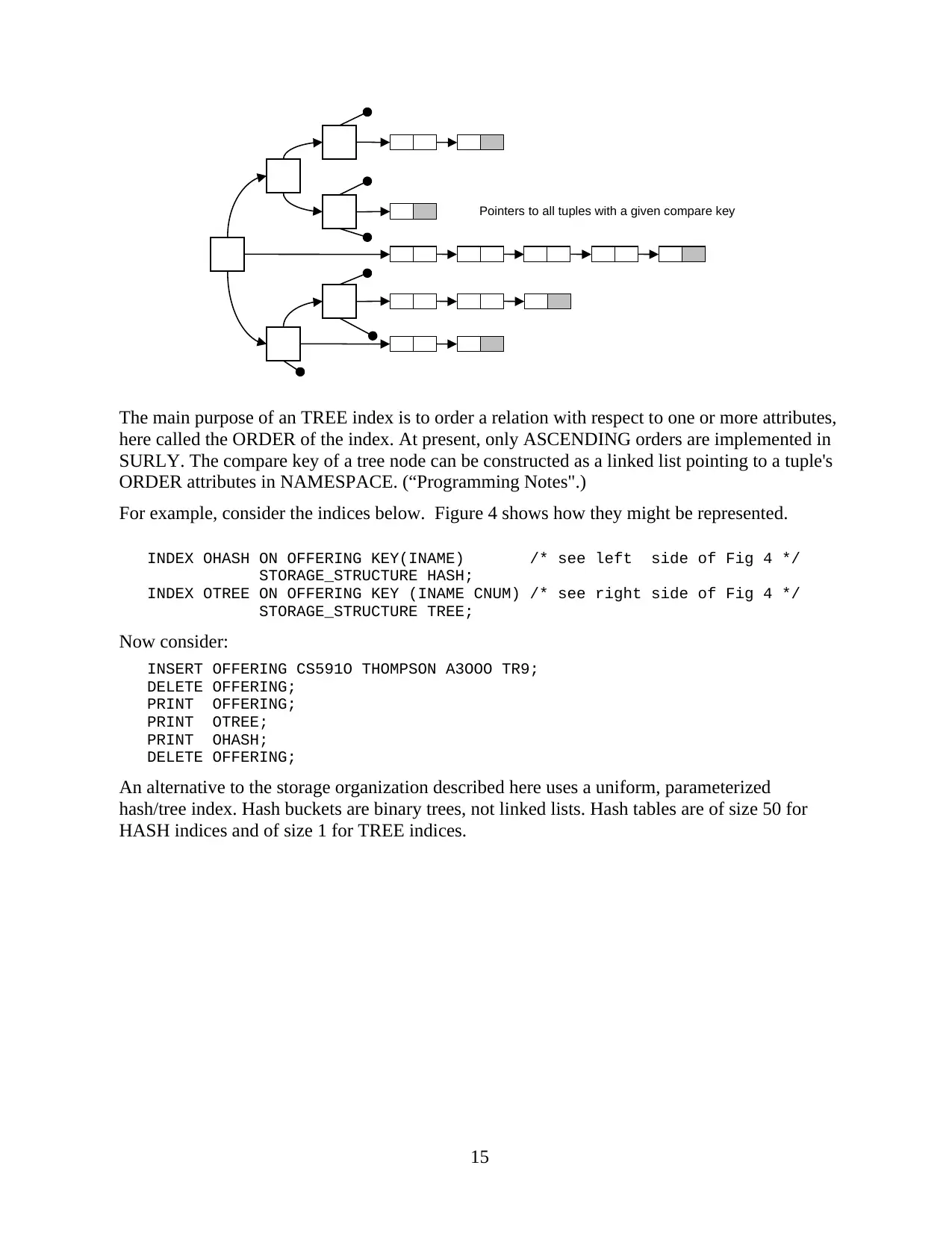
The main purpose of an TREE index is to order a relation with respect to one or more attributes,
here called the ORDER of the index. At present, only ASCENDING orders are implemented in
SURLY. The compare key of a tree node can be constructed as a linked list pointing to a tuple's
ORDER attributes in NAMESPACE. (“Programming Notes".)
For example, consider the indices below. Figure 4 shows how they might be represented.
INDEX OHASH ON OFFERING KEY(INAME) /* see left side of Fig 4 */
STORAGE_STRUCTURE HASH;
INDEX OTREE ON OFFERING KEY (INAME CNUM) /* see right side of Fig 4 */
STORAGE_STRUCTURE TREE;
Now consider:
INSERT OFFERING CS591O THOMPSON A3OOO TR9;
DELETE OFFERING;
PRINT OFFERING;
PRINT OTREE;
PRINT OHASH;
DELETE OFFERING;
An alternative to the storage organization described here uses a uniform, parameterized
hash/tree index. Hash buckets are binary trees, not linked lists. Hash tables are of size 50 for
HASH indices and of size 1 for TREE indices.
Pointers to all tuples with a given compare key
15
here called the ORDER of the index. At present, only ASCENDING orders are implemented in
SURLY. The compare key of a tree node can be constructed as a linked list pointing to a tuple's
ORDER attributes in NAMESPACE. (“Programming Notes".)
For example, consider the indices below. Figure 4 shows how they might be represented.
INDEX OHASH ON OFFERING KEY(INAME) /* see left side of Fig 4 */
STORAGE_STRUCTURE HASH;
INDEX OTREE ON OFFERING KEY (INAME CNUM) /* see right side of Fig 4 */
STORAGE_STRUCTURE TREE;
Now consider:
INSERT OFFERING CS591O THOMPSON A3OOO TR9;
DELETE OFFERING;
PRINT OFFERING;
PRINT OTREE;
PRINT OHASH;
DELETE OFFERING;
An alternative to the storage organization described here uses a uniform, parameterized
hash/tree index. Hash buckets are binary trees, not linked lists. Hash tables are of size 50 for
HASH indices and of size 1 for TREE indices.
Pointers to all tuples with a given compare key
15
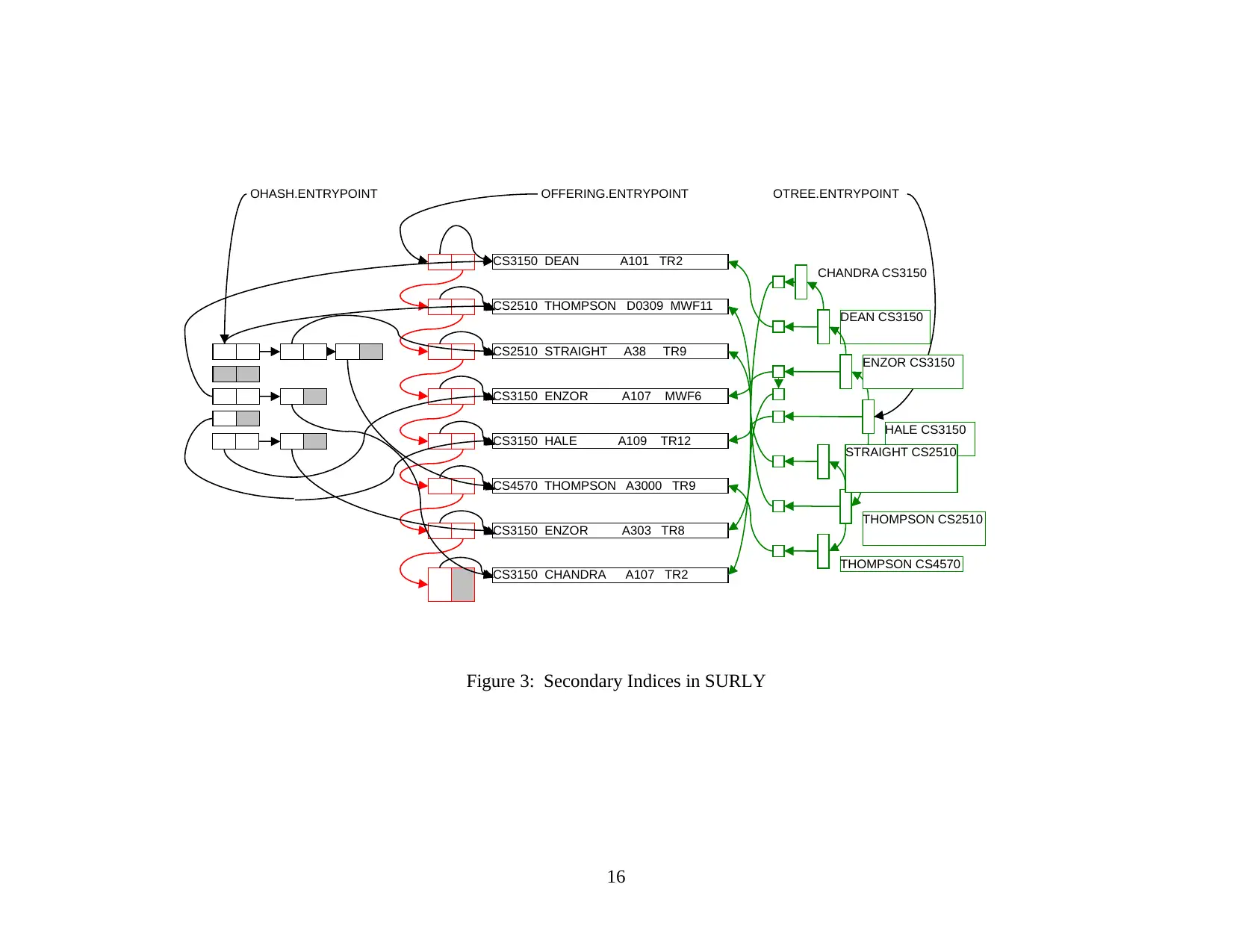
Figure 3: Secondary Indices in SURLY
CS3150 DEAN A101 TR2
CS2510 THOMPSON D0309 MWF11
CS2510 STRAIGHT A38 TR9
CS3150 ENZOR A107 MWF6
CS3150 HALE A109 TR12
CS3150 CHANDRA A107 TR2
CS3150 ENZOR A303 TR8
CS4570 THOMPSON A3000 TR9
OFFERING.ENTRYPOINTOHASH.ENTRYPOINT OTREE.ENTRYPOINT
CHANDRA CS3150
DEAN CS3150
ENZOR CS3150
HALE CS3150
THOMPSON CS4570
THOMPSON CS2510
STRAIGHT CS2510
16
CS3150 DEAN A101 TR2
CS2510 THOMPSON D0309 MWF11
CS2510 STRAIGHT A38 TR9
CS3150 ENZOR A107 MWF6
CS3150 HALE A109 TR12
CS3150 CHANDRA A107 TR2
CS3150 ENZOR A303 TR8
CS4570 THOMPSON A3000 TR9
OFFERING.ENTRYPOINTOHASH.ENTRYPOINT OTREE.ENTRYPOINT
CHANDRA CS3150
DEAN CS3150
ENZOR CS3150
HALE CS3150
THOMPSON CS4570
THOMPSON CS2510
STRAIGHT CS2510
16
Paraphrase This Document
Need a fresh take? Get an instant paraphrase of this document with our AI Paraphraser

H. EXPORT and IMPORT statements
EXPORT <relationname>;
For each relation in the list of relations, export the relation to a file of the same name (in a
default directory).
To export a relation, make up an XML format that encodes the RELATION, INDEXes, and
tuples for a relation and write that to the file.
IMPORT <relationname>;
For each relation in the list of relations, import the relation from a file of the same name (in a
default directory). That means reading the XML statement.
(Alternatively, you can export a file by writing RELATION, INDEX, and INPUT statements
and importing is just reading these. In.
I. Assignments
This looks like a healthy project – but we have a whole semester. Still, the best way to attack a
big problem is to break it into sub-problems. For this kind of problem, a natural decomposition
is to implement only a subset of the system's rules. Then to add on modules as we go until the
whole language has been implemented. The most natural set of rules to start with is one that
implements a subset of SURLY.
Do not write and test your program all at once. You have several weeks to finish your
assignment, but you won't finish it if you wait to the last week or two to get started. First break
the problem into pieces and decide to work on certain pieces each week. Test each piece with a
driver before putting the pieces together.
Consider that you are implementing a prototypical SURLY. In this version, don't spend a lot of
time on handling input errors. You may assume error-free input.
Be sure to include a comprehensive collection of test cases with your assignment. Develop a
file of test commands and read these in, executing them. This “regression test” will help you
test your program.
17
EXPORT <relationname>;
For each relation in the list of relations, export the relation to a file of the same name (in a
default directory).
To export a relation, make up an XML format that encodes the RELATION, INDEXes, and
tuples for a relation and write that to the file.
IMPORT <relationname>;
For each relation in the list of relations, import the relation from a file of the same name (in a
default directory). That means reading the XML statement.
(Alternatively, you can export a file by writing RELATION, INDEX, and INPUT statements
and importing is just reading these. In.
I. Assignments
This looks like a healthy project – but we have a whole semester. Still, the best way to attack a
big problem is to break it into sub-problems. For this kind of problem, a natural decomposition
is to implement only a subset of the system's rules. Then to add on modules as we go until the
whole language has been implemented. The most natural set of rules to start with is one that
implements a subset of SURLY.
Do not write and test your program all at once. You have several weeks to finish your
assignment, but you won't finish it if you wait to the last week or two to get started. First break
the problem into pieces and decide to work on certain pieces each week. Test each piece with a
driver before putting the pieces together.
Consider that you are implementing a prototypical SURLY. In this version, don't spend a lot of
time on handling input errors. You may assume error-free input.
Be sure to include a comprehensive collection of test cases with your assignment. Develop a
file of test commands and read these in, executing them. This “regression test” will help you
test your program.
17
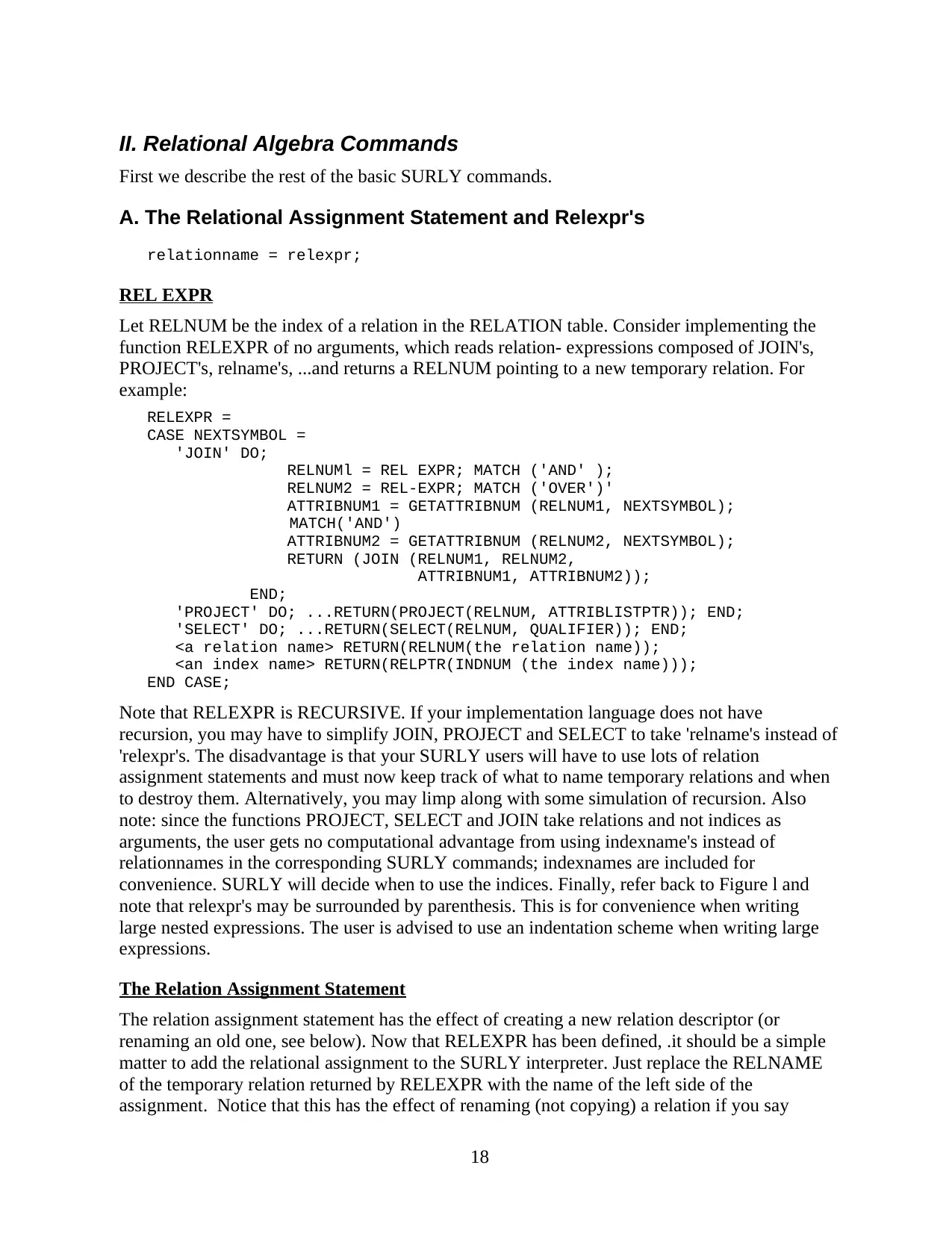
II. Relational Algebra Commands
First we describe the rest of the basic SURLY commands.
A. The Relational Assignment Statement and Relexpr's
relationname = relexpr;
REL EXPR
Let RELNUM be the index of a relation in the RELATION table. Consider implementing the
function RELEXPR of no arguments, which reads relation- expressions composed of JOIN's,
PROJECT's, relname's, ...and returns a RELNUM pointing to a new temporary relation. For
example:
RELEXPR =
CASE NEXTSYMBOL =
'JOIN' DO;
RELNUMl = REL EXPR; MATCH ('AND' );
RELNUM2 = REL-EXPR; MATCH ('OVER')'
ATTRIBNUM1 = GETATTRIBNUM (RELNUM1, NEXTSYMBOL);
MATCH('AND')
ATTRIBNUM2 = GETATTRIBNUM (RELNUM2, NEXTSYMBOL);
RETURN (JOIN (RELNUM1, RELNUM2,
ATTRIBNUM1, ATTRIBNUM2));
END;
'PROJECT' DO; ...RETURN(PROJECT(RELNUM, ATTRIBLISTPTR)); END;
'SELECT' DO; ...RETURN(SELECT(RELNUM, QUALIFIER)); END;
<a relation name> RETURN(RELNUM(the relation name));
<an index name> RETURN(RELPTR(INDNUM (the index name)));
END CASE;
Note that RELEXPR is RECURSIVE. If your implementation language does not have
recursion, you may have to simplify JOIN, PROJECT and SELECT to take 'relname's instead of
'relexpr's. The disadvantage is that your SURLY users will have to use lots of relation
assignment statements and must now keep track of what to name temporary relations and when
to destroy them. Alternatively, you may limp along with some simulation of recursion. Also
note: since the functions PROJECT, SELECT and JOIN take relations and not indices as
arguments, the user gets no computational advantage from using indexname's instead of
relationnames in the corresponding SURLY commands; indexnames are included for
convenience. SURLY will decide when to use the indices. Finally, refer back to Figure l and
note that relexpr's may be surrounded by parenthesis. This is for convenience when writing
large nested expressions. The user is advised to use an indentation scheme when writing large
expressions.
The Relation Assignment Statement
The relation assignment statement has the effect of creating a new relation descriptor (or
renaming an old one, see below). Now that RELEXPR has been defined, .it should be a simple
matter to add the relational assignment to the SURLY interpreter. Just replace the RELNAME
of the temporary relation returned by RELEXPR with the name of the left side of the
assignment. Notice that this has the effect of renaming (not copying) a relation if you say
18
First we describe the rest of the basic SURLY commands.
A. The Relational Assignment Statement and Relexpr's
relationname = relexpr;
REL EXPR
Let RELNUM be the index of a relation in the RELATION table. Consider implementing the
function RELEXPR of no arguments, which reads relation- expressions composed of JOIN's,
PROJECT's, relname's, ...and returns a RELNUM pointing to a new temporary relation. For
example:
RELEXPR =
CASE NEXTSYMBOL =
'JOIN' DO;
RELNUMl = REL EXPR; MATCH ('AND' );
RELNUM2 = REL-EXPR; MATCH ('OVER')'
ATTRIBNUM1 = GETATTRIBNUM (RELNUM1, NEXTSYMBOL);
MATCH('AND')
ATTRIBNUM2 = GETATTRIBNUM (RELNUM2, NEXTSYMBOL);
RETURN (JOIN (RELNUM1, RELNUM2,
ATTRIBNUM1, ATTRIBNUM2));
END;
'PROJECT' DO; ...RETURN(PROJECT(RELNUM, ATTRIBLISTPTR)); END;
'SELECT' DO; ...RETURN(SELECT(RELNUM, QUALIFIER)); END;
<a relation name> RETURN(RELNUM(the relation name));
<an index name> RETURN(RELPTR(INDNUM (the index name)));
END CASE;
Note that RELEXPR is RECURSIVE. If your implementation language does not have
recursion, you may have to simplify JOIN, PROJECT and SELECT to take 'relname's instead of
'relexpr's. The disadvantage is that your SURLY users will have to use lots of relation
assignment statements and must now keep track of what to name temporary relations and when
to destroy them. Alternatively, you may limp along with some simulation of recursion. Also
note: since the functions PROJECT, SELECT and JOIN take relations and not indices as
arguments, the user gets no computational advantage from using indexname's instead of
relationnames in the corresponding SURLY commands; indexnames are included for
convenience. SURLY will decide when to use the indices. Finally, refer back to Figure l and
note that relexpr's may be surrounded by parenthesis. This is for convenience when writing
large nested expressions. The user is advised to use an indentation scheme when writing large
expressions.
The Relation Assignment Statement
The relation assignment statement has the effect of creating a new relation descriptor (or
renaming an old one, see below). Now that RELEXPR has been defined, .it should be a simple
matter to add the relational assignment to the SURLY interpreter. Just replace the RELNAME
of the temporary relation returned by RELEXPR with the name of the left side of the
assignment. Notice that this has the effect of renaming (not copying) a relation if you say
18
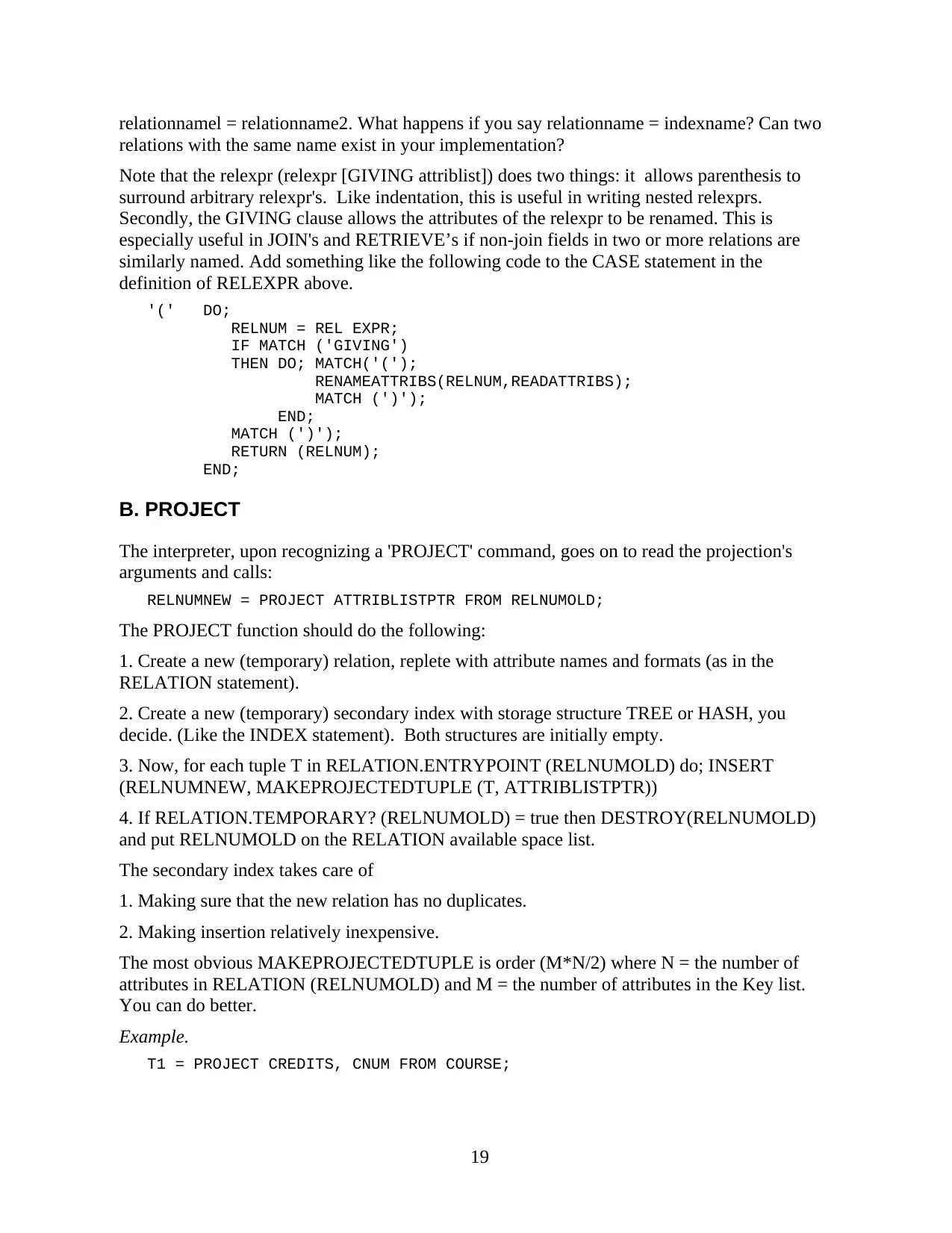
relationnamel = relationname2. What happens if you say relationname = indexname? Can two
relations with the same name exist in your implementation?
Note that the relexpr (relexpr [GIVING attriblist]) does two things: it allows parenthesis to
surround arbitrary relexpr's. Like indentation, this is useful in writing nested relexprs.
Secondly, the GIVING clause allows the attributes of the relexpr to be renamed. This is
especially useful in JOIN's and RETRIEVE’s if non-join fields in two or more relations are
similarly named. Add something like the following code to the CASE statement in the
definition of RELEXPR above.
'(' DO;
RELNUM = REL EXPR;
IF MATCH ('GIVING')
THEN DO; MATCH('(');
RENAMEATTRIBS(RELNUM,READATTRIBS);
MATCH (')');
END;
MATCH (')');
RETURN (RELNUM);
END;
B. PROJECT
The interpreter, upon recognizing a 'PROJECT' command, goes on to read the projection's
arguments and calls:
RELNUMNEW = PROJECT ATTRIBLISTPTR FROM RELNUMOLD;
The PROJECT function should do the following:
1. Create a new (temporary) relation, replete with attribute names and formats (as in the
RELATION statement).
2. Create a new (temporary) secondary index with storage structure TREE or HASH, you
decide. (Like the INDEX statement). Both structures are initially empty.
3. Now, for each tuple T in RELATION.ENTRYPOINT (RELNUMOLD) do; INSERT
(RELNUMNEW, MAKEPROJECTEDTUPLE (T, ATTRIBLISTPTR))
4. If RELATION.TEMPORARY? (RELNUMOLD) = true then DESTROY(RELNUMOLD)
and put RELNUMOLD on the RELATION available space list.
The secondary index takes care of
1. Making sure that the new relation has no duplicates.
2. Making insertion relatively inexpensive.
The most obvious MAKEPROJECTEDTUPLE is order (M*N/2) where N = the number of
attributes in RELATION (RELNUMOLD) and M = the number of attributes in the Key list.
You can do better.
Example.
T1 = PROJECT CREDITS, CNUM FROM COURSE;
19
relations with the same name exist in your implementation?
Note that the relexpr (relexpr [GIVING attriblist]) does two things: it allows parenthesis to
surround arbitrary relexpr's. Like indentation, this is useful in writing nested relexprs.
Secondly, the GIVING clause allows the attributes of the relexpr to be renamed. This is
especially useful in JOIN's and RETRIEVE’s if non-join fields in two or more relations are
similarly named. Add something like the following code to the CASE statement in the
definition of RELEXPR above.
'(' DO;
RELNUM = REL EXPR;
IF MATCH ('GIVING')
THEN DO; MATCH('(');
RENAMEATTRIBS(RELNUM,READATTRIBS);
MATCH (')');
END;
MATCH (')');
RETURN (RELNUM);
END;
B. PROJECT
The interpreter, upon recognizing a 'PROJECT' command, goes on to read the projection's
arguments and calls:
RELNUMNEW = PROJECT ATTRIBLISTPTR FROM RELNUMOLD;
The PROJECT function should do the following:
1. Create a new (temporary) relation, replete with attribute names and formats (as in the
RELATION statement).
2. Create a new (temporary) secondary index with storage structure TREE or HASH, you
decide. (Like the INDEX statement). Both structures are initially empty.
3. Now, for each tuple T in RELATION.ENTRYPOINT (RELNUMOLD) do; INSERT
(RELNUMNEW, MAKEPROJECTEDTUPLE (T, ATTRIBLISTPTR))
4. If RELATION.TEMPORARY? (RELNUMOLD) = true then DESTROY(RELNUMOLD)
and put RELNUMOLD on the RELATION available space list.
The secondary index takes care of
1. Making sure that the new relation has no duplicates.
2. Making insertion relatively inexpensive.
The most obvious MAKEPROJECTEDTUPLE is order (M*N/2) where N = the number of
attributes in RELATION (RELNUMOLD) and M = the number of attributes in the Key list.
You can do better.
Example.
T1 = PROJECT CREDITS, CNUM FROM COURSE;
19
Secure Best Marks with AI Grader
Need help grading? Try our AI Grader for instant feedback on your assignments.
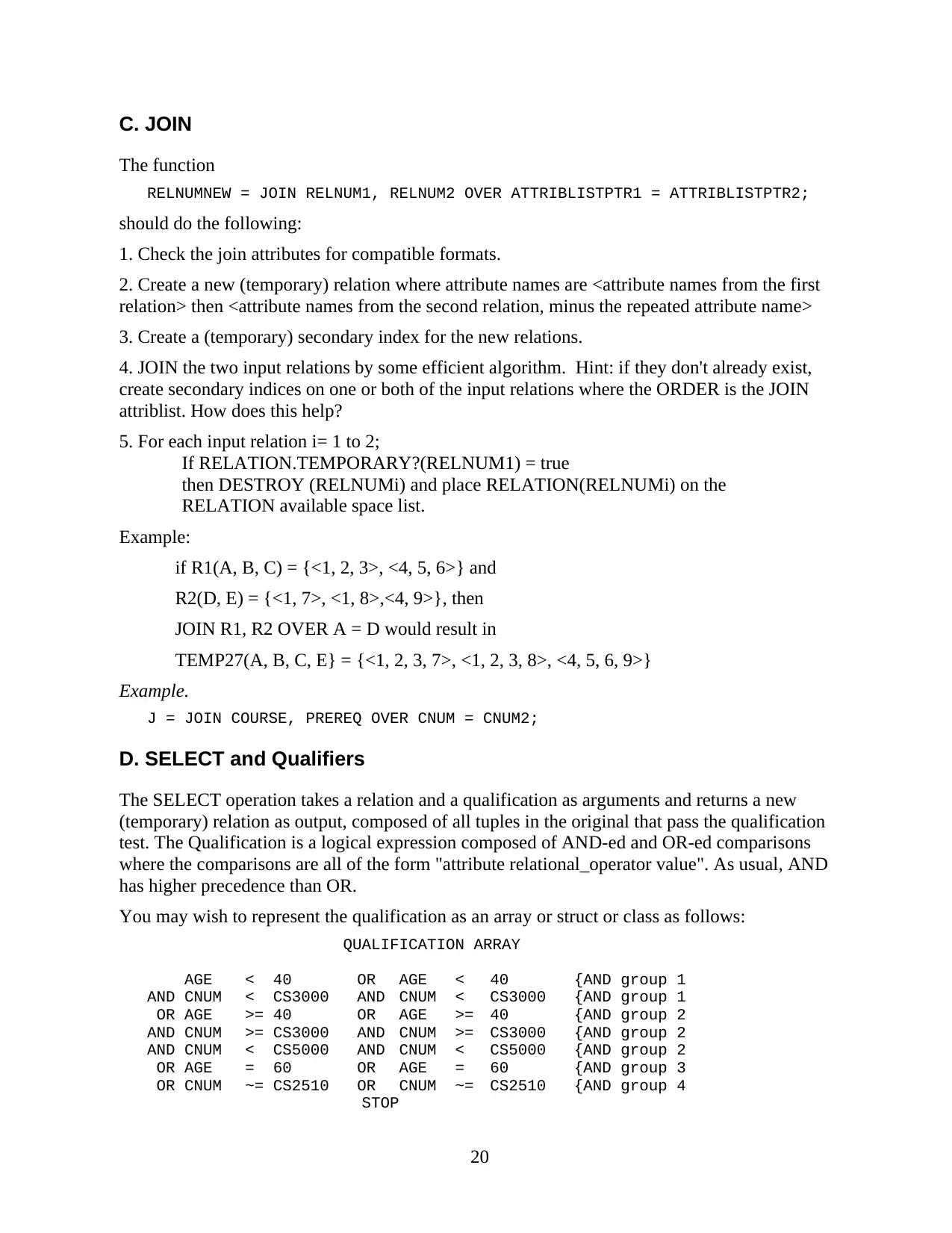
C. JOIN
The function
RELNUMNEW = JOIN RELNUM1, RELNUM2 OVER ATTRIBLISTPTR1 = ATTRIBLISTPTR2;
should do the following:
1. Check the join attributes for compatible formats.
2. Create a new (temporary) relation where attribute names are <attribute names from the first
relation> then <attribute names from the second relation, minus the repeated attribute name>
3. Create a (temporary) secondary index for the new relations.
4. JOIN the two input relations by some efficient algorithm. Hint: if they don't already exist,
create secondary indices on one or both of the input relations where the ORDER is the JOIN
attriblist. How does this help?
5. For each input relation i= 1 to 2;
If RELATION.TEMPORARY?(RELNUM1) = true
then DESTROY (RELNUMi) and place RELATION(RELNUMi) on the
RELATION available space list.
Example:
if R1(A, B, C) = {<1, 2, 3>, <4, 5, 6>} and
R2(D, E) = {<1, 7>, <1, 8>,<4, 9>}, then
JOIN R1, R2 OVER A = D would result in
TEMP27(A, B, C, E} = {<1, 2, 3, 7>, <1, 2, 3, 8>, <4, 5, 6, 9>}
Example.
J = JOIN COURSE, PREREQ OVER CNUM = CNUM2;
D. SELECT and Qualifiers
The SELECT operation takes a relation and a qualification as arguments and returns a new
(temporary) relation as output, composed of all tuples in the original that pass the qualification
test. The Qualification is a logical expression composed of AND-ed and OR-ed comparisons
where the comparisons are all of the form "attribute relational_operator value". As usual, AND
has higher precedence than OR.
You may wish to represent the qualification as an array or struct or class as follows:
QUALIFICATION ARRAY
AGE < 40 OR AGE < 40 {AND group 1
AND CNUM < CS3000 AND CNUM < CS3000 {AND group 1
OR AGE >= 40 OR AGE >= 40 {AND group 2
AND CNUM >= CS3000 AND CNUM >= CS3000 {AND group 2
AND CNUM < CS5000 AND CNUM < CS5000 {AND group 2
OR AGE = 60 OR AGE = 60 {AND group 3
OR CNUM ~= CS2510 OR CNUM ~= CS2510 {AND group 4
STOP
20
The function
RELNUMNEW = JOIN RELNUM1, RELNUM2 OVER ATTRIBLISTPTR1 = ATTRIBLISTPTR2;
should do the following:
1. Check the join attributes for compatible formats.
2. Create a new (temporary) relation where attribute names are <attribute names from the first
relation> then <attribute names from the second relation, minus the repeated attribute name>
3. Create a (temporary) secondary index for the new relations.
4. JOIN the two input relations by some efficient algorithm. Hint: if they don't already exist,
create secondary indices on one or both of the input relations where the ORDER is the JOIN
attriblist. How does this help?
5. For each input relation i= 1 to 2;
If RELATION.TEMPORARY?(RELNUM1) = true
then DESTROY (RELNUMi) and place RELATION(RELNUMi) on the
RELATION available space list.
Example:
if R1(A, B, C) = {<1, 2, 3>, <4, 5, 6>} and
R2(D, E) = {<1, 7>, <1, 8>,<4, 9>}, then
JOIN R1, R2 OVER A = D would result in
TEMP27(A, B, C, E} = {<1, 2, 3, 7>, <1, 2, 3, 8>, <4, 5, 6, 9>}
Example.
J = JOIN COURSE, PREREQ OVER CNUM = CNUM2;
D. SELECT and Qualifiers
The SELECT operation takes a relation and a qualification as arguments and returns a new
(temporary) relation as output, composed of all tuples in the original that pass the qualification
test. The Qualification is a logical expression composed of AND-ed and OR-ed comparisons
where the comparisons are all of the form "attribute relational_operator value". As usual, AND
has higher precedence than OR.
You may wish to represent the qualification as an array or struct or class as follows:
QUALIFICATION ARRAY
AGE < 40 OR AGE < 40 {AND group 1
AND CNUM < CS3000 AND CNUM < CS3000 {AND group 1
OR AGE >= 40 OR AGE >= 40 {AND group 2
AND CNUM >= CS3000 AND CNUM >= CS3000 {AND group 2
AND CNUM < CS5000 AND CNUM < CS5000 {AND group 2
OR AGE = 60 OR AGE = 60 {AND group 3
OR CNUM ~= CS2510 OR CNUM ~= CS2510 {AND group 4
STOP
20
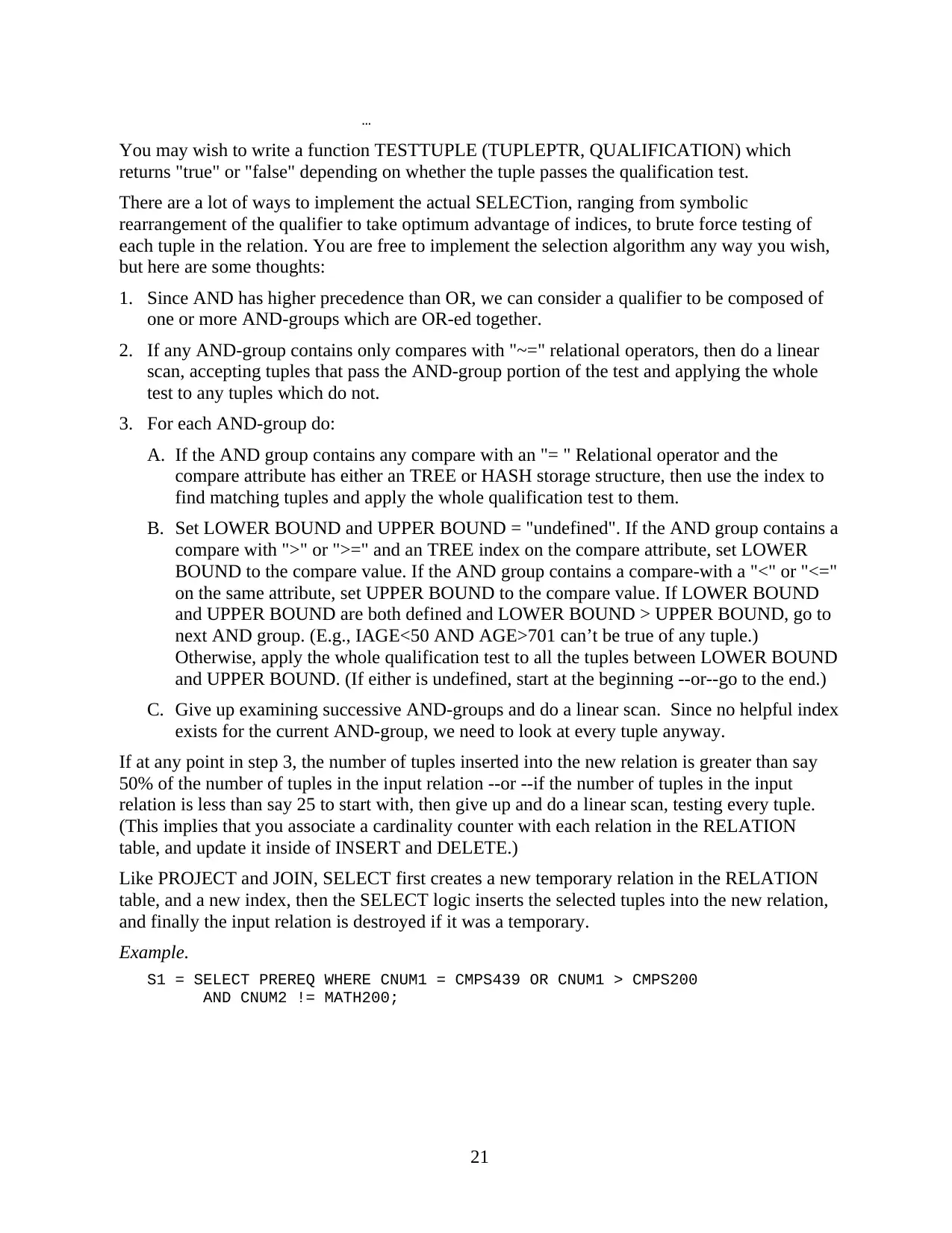
…
You may wish to write a function TESTTUPLE (TUPLEPTR, QUALIFICATION) which
returns "true" or "false" depending on whether the tuple passes the qualification test.
There are a lot of ways to implement the actual SELECTion, ranging from symbolic
rearrangement of the qualifier to take optimum advantage of indices, to brute force testing of
each tuple in the relation. You are free to implement the selection algorithm any way you wish,
but here are some thoughts:
1. Since AND has higher precedence than OR, we can consider a qualifier to be composed of
one or more AND-groups which are OR-ed together.
2. If any AND-group contains only compares with "~=" relational operators, then do a linear
scan, accepting tuples that pass the AND-group portion of the test and applying the whole
test to any tuples which do not.
3. For each AND-group do:
A. If the AND group contains any compare with an "= " Relational operator and the
compare attribute has either an TREE or HASH storage structure, then use the index to
find matching tuples and apply the whole qualification test to them.
B. Set LOWER BOUND and UPPER BOUND = "undefined". If the AND group contains a
compare with ">" or ">=" and an TREE index on the compare attribute, set LOWER
BOUND to the compare value. If the AND group contains a compare-with a "<" or "<="
on the same attribute, set UPPER BOUND to the compare value. If LOWER BOUND
and UPPER BOUND are both defined and LOWER BOUND > UPPER BOUND, go to
next AND group. (E.g., IAGE<50 AND AGE>701 can’t be true of any tuple.)
Otherwise, apply the whole qualification test to all the tuples between LOWER BOUND
and UPPER BOUND. (If either is undefined, start at the beginning --or--go to the end.)
C. Give up examining successive AND-groups and do a linear scan. Since no helpful index
exists for the current AND-group, we need to look at every tuple anyway.
If at any point in step 3, the number of tuples inserted into the new relation is greater than say
50% of the number of tuples in the input relation --or --if the number of tuples in the input
relation is less than say 25 to start with, then give up and do a linear scan, testing every tuple.
(This implies that you associate a cardinality counter with each relation in the RELATION
table, and update it inside of INSERT and DELETE.)
Like PROJECT and JOIN, SELECT first creates a new temporary relation in the RELATION
table, and a new index, then the SELECT logic inserts the selected tuples into the new relation,
and finally the input relation is destroyed if it was a temporary.
Example.
S1 = SELECT PREREQ WHERE CNUM1 = CMPS439 OR CNUM1 > CMPS200
AND CNUM2 != MATH200;
21
You may wish to write a function TESTTUPLE (TUPLEPTR, QUALIFICATION) which
returns "true" or "false" depending on whether the tuple passes the qualification test.
There are a lot of ways to implement the actual SELECTion, ranging from symbolic
rearrangement of the qualifier to take optimum advantage of indices, to brute force testing of
each tuple in the relation. You are free to implement the selection algorithm any way you wish,
but here are some thoughts:
1. Since AND has higher precedence than OR, we can consider a qualifier to be composed of
one or more AND-groups which are OR-ed together.
2. If any AND-group contains only compares with "~=" relational operators, then do a linear
scan, accepting tuples that pass the AND-group portion of the test and applying the whole
test to any tuples which do not.
3. For each AND-group do:
A. If the AND group contains any compare with an "= " Relational operator and the
compare attribute has either an TREE or HASH storage structure, then use the index to
find matching tuples and apply the whole qualification test to them.
B. Set LOWER BOUND and UPPER BOUND = "undefined". If the AND group contains a
compare with ">" or ">=" and an TREE index on the compare attribute, set LOWER
BOUND to the compare value. If the AND group contains a compare-with a "<" or "<="
on the same attribute, set UPPER BOUND to the compare value. If LOWER BOUND
and UPPER BOUND are both defined and LOWER BOUND > UPPER BOUND, go to
next AND group. (E.g., IAGE<50 AND AGE>701 can’t be true of any tuple.)
Otherwise, apply the whole qualification test to all the tuples between LOWER BOUND
and UPPER BOUND. (If either is undefined, start at the beginning --or--go to the end.)
C. Give up examining successive AND-groups and do a linear scan. Since no helpful index
exists for the current AND-group, we need to look at every tuple anyway.
If at any point in step 3, the number of tuples inserted into the new relation is greater than say
50% of the number of tuples in the input relation --or --if the number of tuples in the input
relation is less than say 25 to start with, then give up and do a linear scan, testing every tuple.
(This implies that you associate a cardinality counter with each relation in the RELATION
table, and update it inside of INSERT and DELETE.)
Like PROJECT and JOIN, SELECT first creates a new temporary relation in the RELATION
table, and a new index, then the SELECT logic inserts the selected tuples into the new relation,
and finally the input relation is destroyed if it was a temporary.
Example.
S1 = SELECT PREREQ WHERE CNUM1 = CMPS439 OR CNUM1 > CMPS200
AND CNUM2 != MATH200;
21
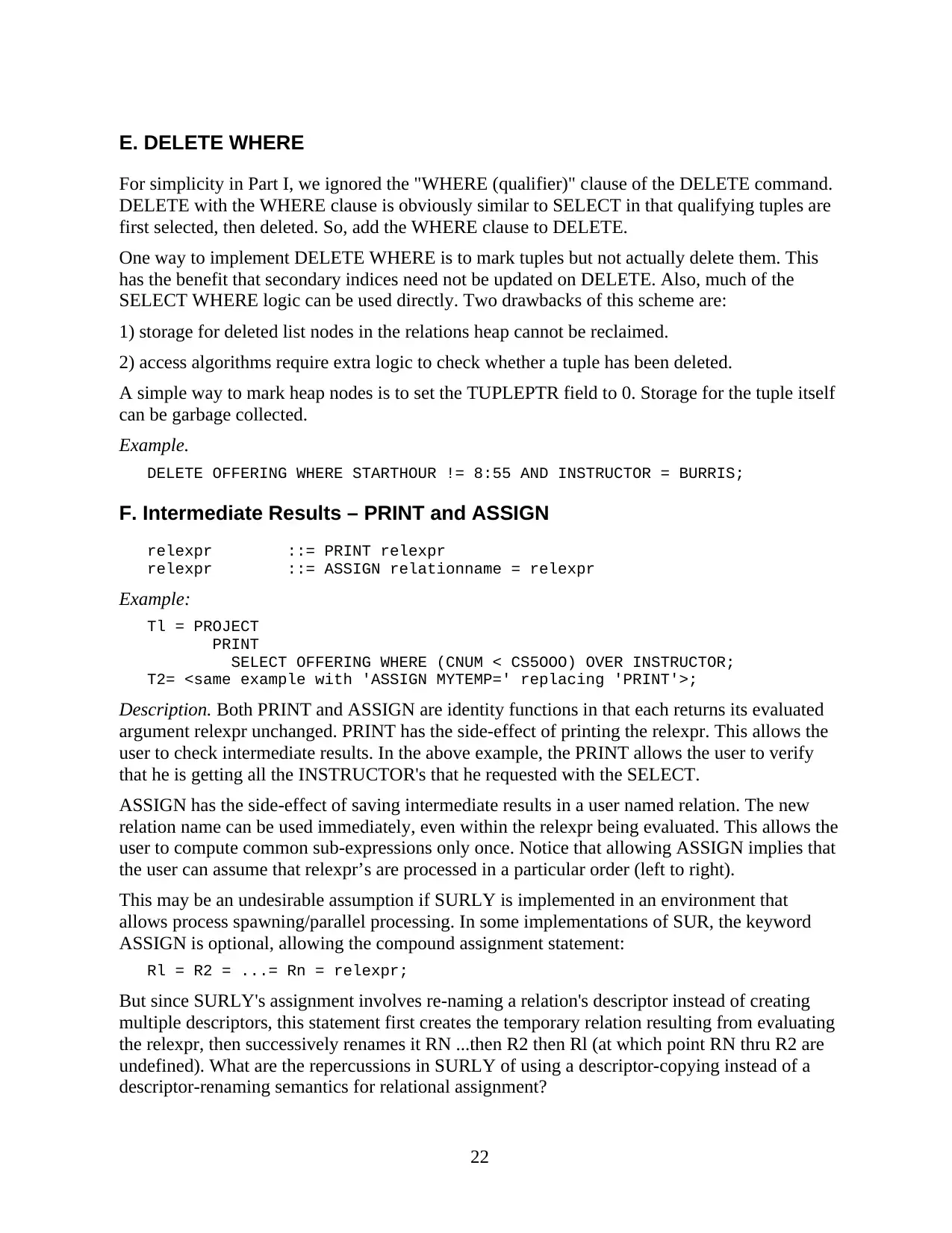
E. DELETE WHERE
For simplicity in Part I, we ignored the "WHERE (qualifier)" clause of the DELETE command.
DELETE with the WHERE clause is obviously similar to SELECT in that qualifying tuples are
first selected, then deleted. So, add the WHERE clause to DELETE.
One way to implement DELETE WHERE is to mark tuples but not actually delete them. This
has the benefit that secondary indices need not be updated on DELETE. Also, much of the
SELECT WHERE logic can be used directly. Two drawbacks of this scheme are:
1) storage for deleted list nodes in the relations heap cannot be reclaimed.
2) access algorithms require extra logic to check whether a tuple has been deleted.
A simple way to mark heap nodes is to set the TUPLEPTR field to 0. Storage for the tuple itself
can be garbage collected.
Example.
DELETE OFFERING WHERE STARTHOUR != 8:55 AND INSTRUCTOR = BURRIS;
F. Intermediate Results – PRINT and ASSIGN
relexpr ::= PRINT relexpr
relexpr ::= ASSIGN relationname = relexpr
Example:
Tl = PROJECT
PRINT
SELECT OFFERING WHERE (CNUM < CS5OOO) OVER INSTRUCTOR;
T2= <same example with 'ASSIGN MYTEMP=' replacing 'PRINT'>;
Description. Both PRINT and ASSIGN are identity functions in that each returns its evaluated
argument relexpr unchanged. PRINT has the side-effect of printing the relexpr. This allows the
user to check intermediate results. In the above example, the PRINT allows the user to verify
that he is getting all the INSTRUCTOR's that he requested with the SELECT.
ASSIGN has the side-effect of saving intermediate results in a user named relation. The new
relation name can be used immediately, even within the relexpr being evaluated. This allows the
user to compute common sub-expressions only once. Notice that allowing ASSIGN implies that
the user can assume that relexpr’s are processed in a particular order (left to right).
This may be an undesirable assumption if SURLY is implemented in an environment that
allows process spawning/parallel processing. In some implementations of SUR, the keyword
ASSIGN is optional, allowing the compound assignment statement:
Rl = R2 = ...= Rn = relexpr;
But since SURLY's assignment involves re-naming a relation's descriptor instead of creating
multiple descriptors, this statement first creates the temporary relation resulting from evaluating
the relexpr, then successively renames it RN ...then R2 then Rl (at which point RN thru R2 are
undefined). What are the repercussions in SURLY of using a descriptor-copying instead of a
descriptor-renaming semantics for relational assignment?
22
For simplicity in Part I, we ignored the "WHERE (qualifier)" clause of the DELETE command.
DELETE with the WHERE clause is obviously similar to SELECT in that qualifying tuples are
first selected, then deleted. So, add the WHERE clause to DELETE.
One way to implement DELETE WHERE is to mark tuples but not actually delete them. This
has the benefit that secondary indices need not be updated on DELETE. Also, much of the
SELECT WHERE logic can be used directly. Two drawbacks of this scheme are:
1) storage for deleted list nodes in the relations heap cannot be reclaimed.
2) access algorithms require extra logic to check whether a tuple has been deleted.
A simple way to mark heap nodes is to set the TUPLEPTR field to 0. Storage for the tuple itself
can be garbage collected.
Example.
DELETE OFFERING WHERE STARTHOUR != 8:55 AND INSTRUCTOR = BURRIS;
F. Intermediate Results – PRINT and ASSIGN
relexpr ::= PRINT relexpr
relexpr ::= ASSIGN relationname = relexpr
Example:
Tl = PROJECT
SELECT OFFERING WHERE (CNUM < CS5OOO) OVER INSTRUCTOR;
T2= <same example with 'ASSIGN MYTEMP=' replacing 'PRINT'>;
Description. Both PRINT and ASSIGN are identity functions in that each returns its evaluated
argument relexpr unchanged. PRINT has the side-effect of printing the relexpr. This allows the
user to check intermediate results. In the above example, the PRINT allows the user to verify
that he is getting all the INSTRUCTOR's that he requested with the SELECT.
ASSIGN has the side-effect of saving intermediate results in a user named relation. The new
relation name can be used immediately, even within the relexpr being evaluated. This allows the
user to compute common sub-expressions only once. Notice that allowing ASSIGN implies that
the user can assume that relexpr’s are processed in a particular order (left to right).
This may be an undesirable assumption if SURLY is implemented in an environment that
allows process spawning/parallel processing. In some implementations of SUR, the keyword
ASSIGN is optional, allowing the compound assignment statement:
Rl = R2 = ...= Rn = relexpr;
But since SURLY's assignment involves re-naming a relation's descriptor instead of creating
multiple descriptors, this statement first creates the temporary relation resulting from evaluating
the relexpr, then successively renames it RN ...then R2 then Rl (at which point RN thru R2 are
undefined). What are the repercussions in SURLY of using a descriptor-copying instead of a
descriptor-renaming semantics for relational assignment?
22
Paraphrase This Document
Need a fresh take? Get an instant paraphrase of this document with our AI Paraphraser
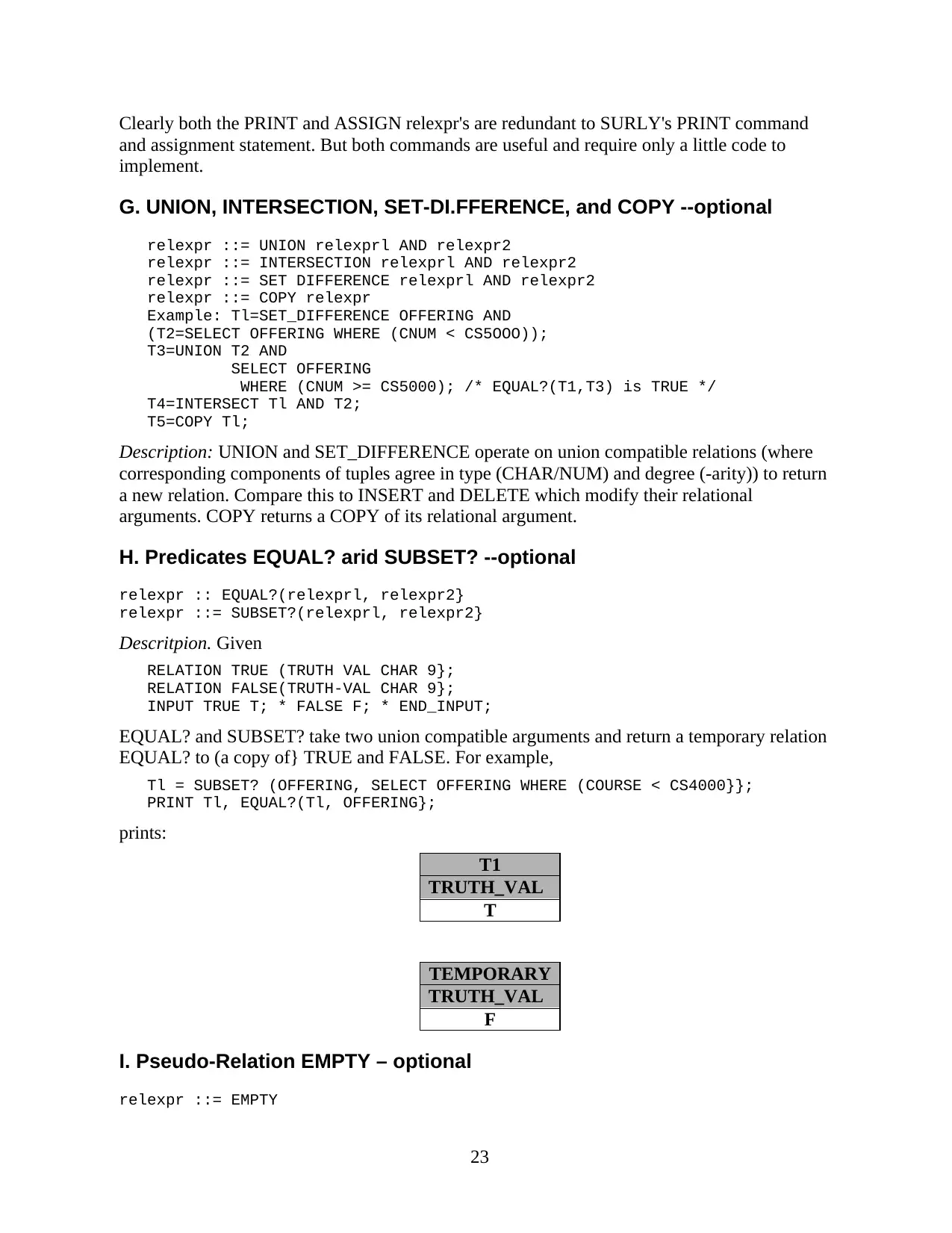
Clearly both the PRINT and ASSIGN relexpr's are redundant to SURLY's PRINT command
and assignment statement. But both commands are useful and require only a little code to
implement.
G. UNION, INTERSECTION, SET-DI.FFERENCE, and COPY --optional
relexpr ::= UNION relexprl AND relexpr2
relexpr ::= INTERSECTION relexprl AND relexpr2
relexpr ::= SET DIFFERENCE relexprl AND relexpr2
relexpr ::= COPY relexpr
Example: Tl=SET_DIFFERENCE OFFERING AND
(T2=SELECT OFFERING WHERE (CNUM < CS5OOO));
T3=UNION T2 AND
SELECT OFFERING
WHERE (CNUM >= CS5000); /* EQUAL?(T1,T3) is TRUE */
T4=INTERSECT Tl AND T2;
T5=COPY Tl;
Description: UNION and SET_DIFFERENCE operate on union compatible relations (where
corresponding components of tuples agree in type (CHAR/NUM) and degree (-arity)) to return
a new relation. Compare this to INSERT and DELETE which modify their relational
arguments. COPY returns a COPY of its relational argument.
H. Predicates EQUAL? arid SUBSET? --optional
relexpr :: EQUAL?(relexprl, relexpr2}
relexpr ::= SUBSET?(relexprl, relexpr2}
Descritpion. Given
RELATION TRUE (TRUTH VAL CHAR 9};
RELATION FALSE(TRUTH-VAL CHAR 9};
INPUT TRUE T; * FALSE F; * END_INPUT;
EQUAL? and SUBSET? take two union compatible arguments and return a temporary relation
EQUAL? to (a copy of} TRUE and FALSE. For example,
Tl = SUBSET? (OFFERING, SELECT OFFERING WHERE (COURSE < CS4000}};
PRINT Tl, EQUAL?(Tl, OFFERING};
prints:
T1
TRUTH_VAL
T
TEMPORARY
TRUTH_VAL
F
I. Pseudo-Relation EMPTY – optional
relexpr ::= EMPTY
23
and assignment statement. But both commands are useful and require only a little code to
implement.
G. UNION, INTERSECTION, SET-DI.FFERENCE, and COPY --optional
relexpr ::= UNION relexprl AND relexpr2
relexpr ::= INTERSECTION relexprl AND relexpr2
relexpr ::= SET DIFFERENCE relexprl AND relexpr2
relexpr ::= COPY relexpr
Example: Tl=SET_DIFFERENCE OFFERING AND
(T2=SELECT OFFERING WHERE (CNUM < CS5OOO));
T3=UNION T2 AND
SELECT OFFERING
WHERE (CNUM >= CS5000); /* EQUAL?(T1,T3) is TRUE */
T4=INTERSECT Tl AND T2;
T5=COPY Tl;
Description: UNION and SET_DIFFERENCE operate on union compatible relations (where
corresponding components of tuples agree in type (CHAR/NUM) and degree (-arity)) to return
a new relation. Compare this to INSERT and DELETE which modify their relational
arguments. COPY returns a COPY of its relational argument.
H. Predicates EQUAL? arid SUBSET? --optional
relexpr :: EQUAL?(relexprl, relexpr2}
relexpr ::= SUBSET?(relexprl, relexpr2}
Descritpion. Given
RELATION TRUE (TRUTH VAL CHAR 9};
RELATION FALSE(TRUTH-VAL CHAR 9};
INPUT TRUE T; * FALSE F; * END_INPUT;
EQUAL? and SUBSET? take two union compatible arguments and return a temporary relation
EQUAL? to (a copy of} TRUE and FALSE. For example,
Tl = SUBSET? (OFFERING, SELECT OFFERING WHERE (COURSE < CS4000}};
PRINT Tl, EQUAL?(Tl, OFFERING};
prints:
T1
TRUTH_VAL
T
TEMPORARY
TRUTH_VAL
F
I. Pseudo-Relation EMPTY – optional
relexpr ::= EMPTY
23
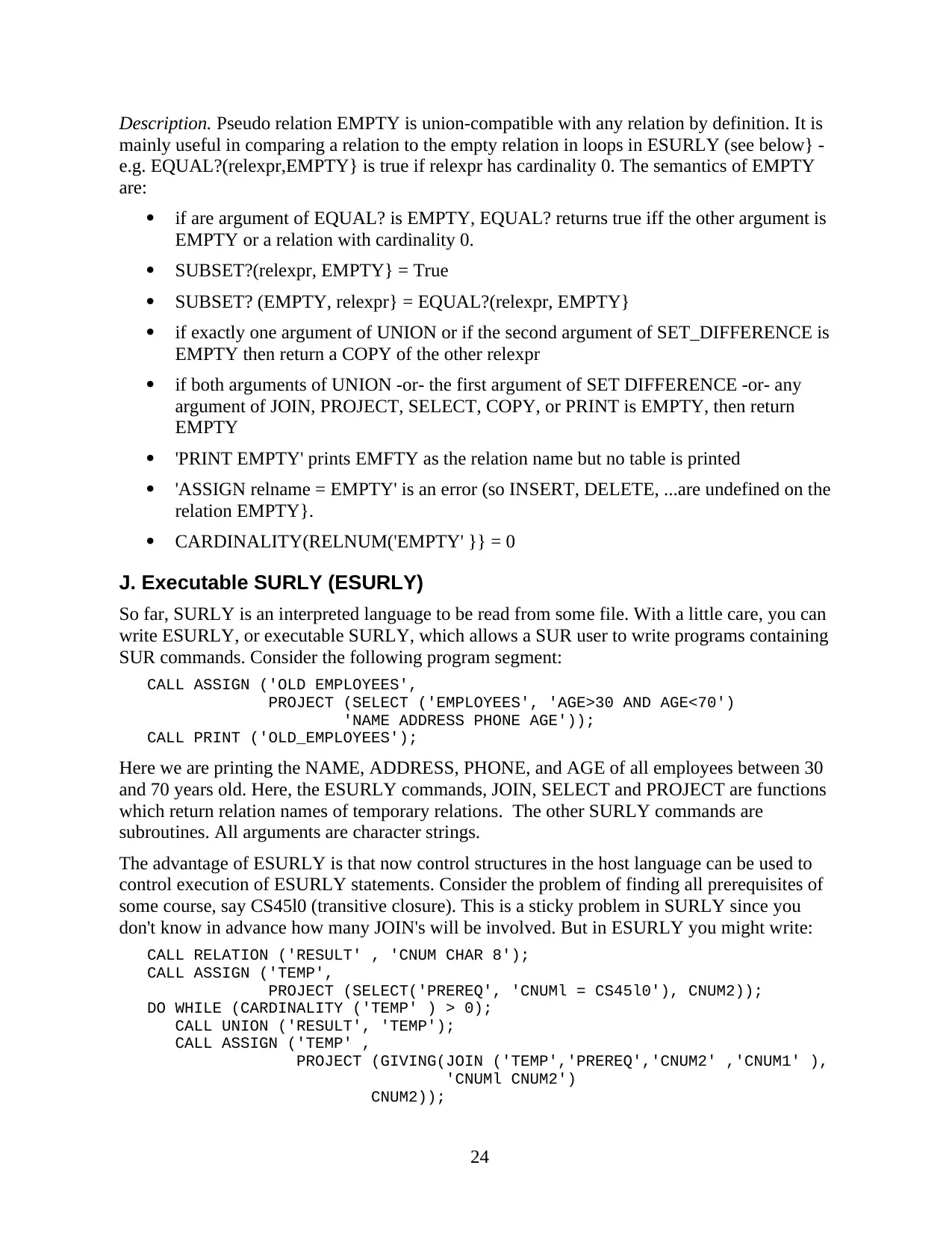
Description. Pseudo relation EMPTY is union-compatible with any relation by definition. It is
mainly useful in comparing a relation to the empty relation in loops in ESURLY (see below} -
e.g. EQUAL?(relexpr,EMPTY} is true if relexpr has cardinality 0. The semantics of EMPTY
are:
if are argument of EQUAL? is EMPTY, EQUAL? returns true iff the other argument is
EMPTY or a relation with cardinality 0.
SUBSET?(relexpr, EMPTY} = True
SUBSET? (EMPTY, relexpr} = EQUAL?(relexpr, EMPTY}
if exactly one argument of UNION or if the second argument of SET_DIFFERENCE is
EMPTY then return a COPY of the other relexpr
if both arguments of UNION -or- the first argument of SET DIFFERENCE -or- any
argument of JOIN, PROJECT, SELECT, COPY, or PRINT is EMPTY, then return
EMPTY
'PRINT EMPTY' prints EMFTY as the relation name but no table is printed
'ASSIGN relname = EMPTY' is an error (so INSERT, DELETE, ...are undefined on the
relation EMPTY}.
CARDINALITY(RELNUM('EMPTY' }} = 0
J. Executable SURLY (ESURLY)
So far, SURLY is an interpreted language to be read from some file. With a little care, you can
write ESURLY, or executable SURLY, which allows a SUR user to write programs containing
SUR commands. Consider the following program segment:
CALL ASSIGN ('OLD EMPLOYEES',
PROJECT (SELECT ('EMPLOYEES', 'AGE>30 AND AGE<70')
'NAME ADDRESS PHONE AGE'));
CALL PRINT ('OLD_EMPLOYEES');
Here we are printing the NAME, ADDRESS, PHONE, and AGE of all employees between 30
and 70 years old. Here, the ESURLY commands, JOIN, SELECT and PROJECT are functions
which return relation names of temporary relations. The other SURLY commands are
subroutines. All arguments are character strings.
The advantage of ESURLY is that now control structures in the host language can be used to
control execution of ESURLY statements. Consider the problem of finding all prerequisites of
some course, say CS45l0 (transitive closure). This is a sticky problem in SURLY since you
don't know in advance how many JOIN's will be involved. But in ESURLY you might write:
CALL RELATION ('RESULT' , 'CNUM CHAR 8');
CALL ASSIGN ('TEMP',
PROJECT (SELECT('PREREQ', 'CNUMl = CS45l0'), CNUM2));
DO WHILE (CARDINALITY ('TEMP' ) > 0);
CALL UNION ('RESULT', 'TEMP');
CALL ASSIGN ('TEMP' ,
PROJECT (GIVING(JOIN ('TEMP','PREREQ','CNUM2' ,'CNUM1' ),
'CNUMl CNUM2')
CNUM2));
24
mainly useful in comparing a relation to the empty relation in loops in ESURLY (see below} -
e.g. EQUAL?(relexpr,EMPTY} is true if relexpr has cardinality 0. The semantics of EMPTY
are:
if are argument of EQUAL? is EMPTY, EQUAL? returns true iff the other argument is
EMPTY or a relation with cardinality 0.
SUBSET?(relexpr, EMPTY} = True
SUBSET? (EMPTY, relexpr} = EQUAL?(relexpr, EMPTY}
if exactly one argument of UNION or if the second argument of SET_DIFFERENCE is
EMPTY then return a COPY of the other relexpr
if both arguments of UNION -or- the first argument of SET DIFFERENCE -or- any
argument of JOIN, PROJECT, SELECT, COPY, or PRINT is EMPTY, then return
EMPTY
'PRINT EMPTY' prints EMFTY as the relation name but no table is printed
'ASSIGN relname = EMPTY' is an error (so INSERT, DELETE, ...are undefined on the
relation EMPTY}.
CARDINALITY(RELNUM('EMPTY' }} = 0
J. Executable SURLY (ESURLY)
So far, SURLY is an interpreted language to be read from some file. With a little care, you can
write ESURLY, or executable SURLY, which allows a SUR user to write programs containing
SUR commands. Consider the following program segment:
CALL ASSIGN ('OLD EMPLOYEES',
PROJECT (SELECT ('EMPLOYEES', 'AGE>30 AND AGE<70')
'NAME ADDRESS PHONE AGE'));
CALL PRINT ('OLD_EMPLOYEES');
Here we are printing the NAME, ADDRESS, PHONE, and AGE of all employees between 30
and 70 years old. Here, the ESURLY commands, JOIN, SELECT and PROJECT are functions
which return relation names of temporary relations. The other SURLY commands are
subroutines. All arguments are character strings.
The advantage of ESURLY is that now control structures in the host language can be used to
control execution of ESURLY statements. Consider the problem of finding all prerequisites of
some course, say CS45l0 (transitive closure). This is a sticky problem in SURLY since you
don't know in advance how many JOIN's will be involved. But in ESURLY you might write:
CALL RELATION ('RESULT' , 'CNUM CHAR 8');
CALL ASSIGN ('TEMP',
PROJECT (SELECT('PREREQ', 'CNUMl = CS45l0'), CNUM2));
DO WHILE (CARDINALITY ('TEMP' ) > 0);
CALL UNION ('RESULT', 'TEMP');
CALL ASSIGN ('TEMP' ,
PROJECT (GIVING(JOIN ('TEMP','PREREQ','CNUM2' ,'CNUM1' ),
'CNUMl CNUM2')
CNUM2));
24
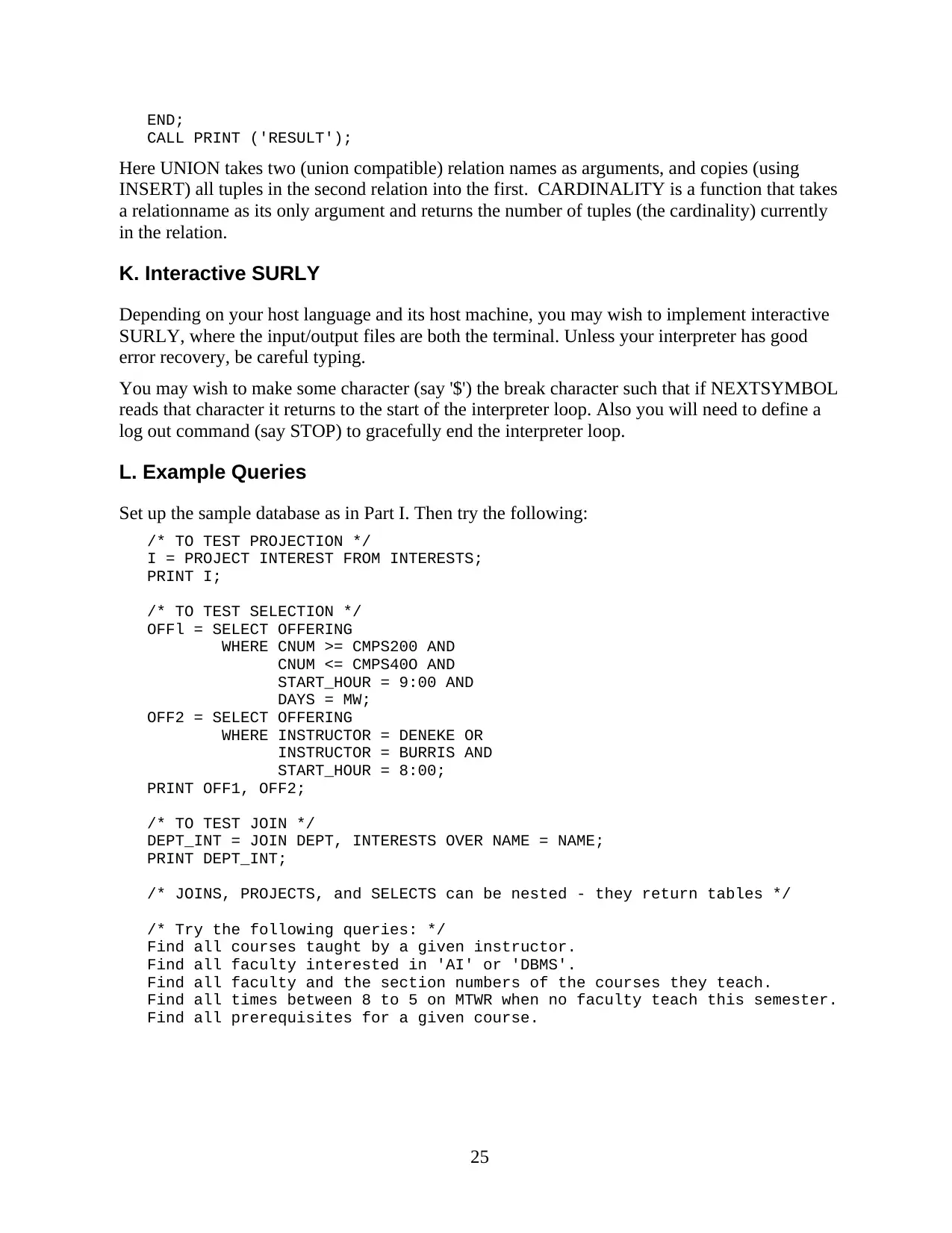
END;
CALL PRINT ('RESULT');
Here UNION takes two (union compatible) relation names as arguments, and copies (using
INSERT) all tuples in the second relation into the first. CARDINALITY is a function that takes
a relationname as its only argument and returns the number of tuples (the cardinality) currently
in the relation.
K. Interactive SURLY
Depending on your host language and its host machine, you may wish to implement interactive
SURLY, where the input/output files are both the terminal. Unless your interpreter has good
error recovery, be careful typing.
You may wish to make some character (say '$') the break character such that if NEXTSYMBOL
reads that character it returns to the start of the interpreter loop. Also you will need to define a
log out command (say STOP) to gracefully end the interpreter loop.
L. Example Queries
Set up the sample database as in Part I. Then try the following:
/* TO TEST PROJECTION */
I = PROJECT INTEREST FROM INTERESTS;
PRINT I;
/* TO TEST SELECTION */
OFFl = SELECT OFFERING
WHERE CNUM >= CMPS200 AND
CNUM <= CMPS40O AND
START_HOUR = 9:00 AND
DAYS = MW;
OFF2 = SELECT OFFERING
WHERE INSTRUCTOR = DENEKE OR
INSTRUCTOR = BURRIS AND
START_HOUR = 8:00;
PRINT OFF1, OFF2;
/* TO TEST JOIN */
DEPT_INT = JOIN DEPT, INTERESTS OVER NAME = NAME;
PRINT DEPT_INT;
/* JOINS, PROJECTS, and SELECTS can be nested - they return tables */
/* Try the following queries: */
Find all courses taught by a given instructor.
Find all faculty interested in 'AI' or 'DBMS'.
Find all faculty and the section numbers of the courses they teach.
Find all times between 8 to 5 on MTWR when no faculty teach this semester.
Find all prerequisites for a given course.
25
CALL PRINT ('RESULT');
Here UNION takes two (union compatible) relation names as arguments, and copies (using
INSERT) all tuples in the second relation into the first. CARDINALITY is a function that takes
a relationname as its only argument and returns the number of tuples (the cardinality) currently
in the relation.
K. Interactive SURLY
Depending on your host language and its host machine, you may wish to implement interactive
SURLY, where the input/output files are both the terminal. Unless your interpreter has good
error recovery, be careful typing.
You may wish to make some character (say '$') the break character such that if NEXTSYMBOL
reads that character it returns to the start of the interpreter loop. Also you will need to define a
log out command (say STOP) to gracefully end the interpreter loop.
L. Example Queries
Set up the sample database as in Part I. Then try the following:
/* TO TEST PROJECTION */
I = PROJECT INTEREST FROM INTERESTS;
PRINT I;
/* TO TEST SELECTION */
OFFl = SELECT OFFERING
WHERE CNUM >= CMPS200 AND
CNUM <= CMPS40O AND
START_HOUR = 9:00 AND
DAYS = MW;
OFF2 = SELECT OFFERING
WHERE INSTRUCTOR = DENEKE OR
INSTRUCTOR = BURRIS AND
START_HOUR = 8:00;
PRINT OFF1, OFF2;
/* TO TEST JOIN */
DEPT_INT = JOIN DEPT, INTERESTS OVER NAME = NAME;
PRINT DEPT_INT;
/* JOINS, PROJECTS, and SELECTS can be nested - they return tables */
/* Try the following queries: */
Find all courses taught by a given instructor.
Find all faculty interested in 'AI' or 'DBMS'.
Find all faculty and the section numbers of the courses they teach.
Find all times between 8 to 5 on MTWR when no faculty teach this semester.
Find all prerequisites for a given course.
25
Secure Best Marks with AI Grader
Need help grading? Try our AI Grader for instant feedback on your assignments.
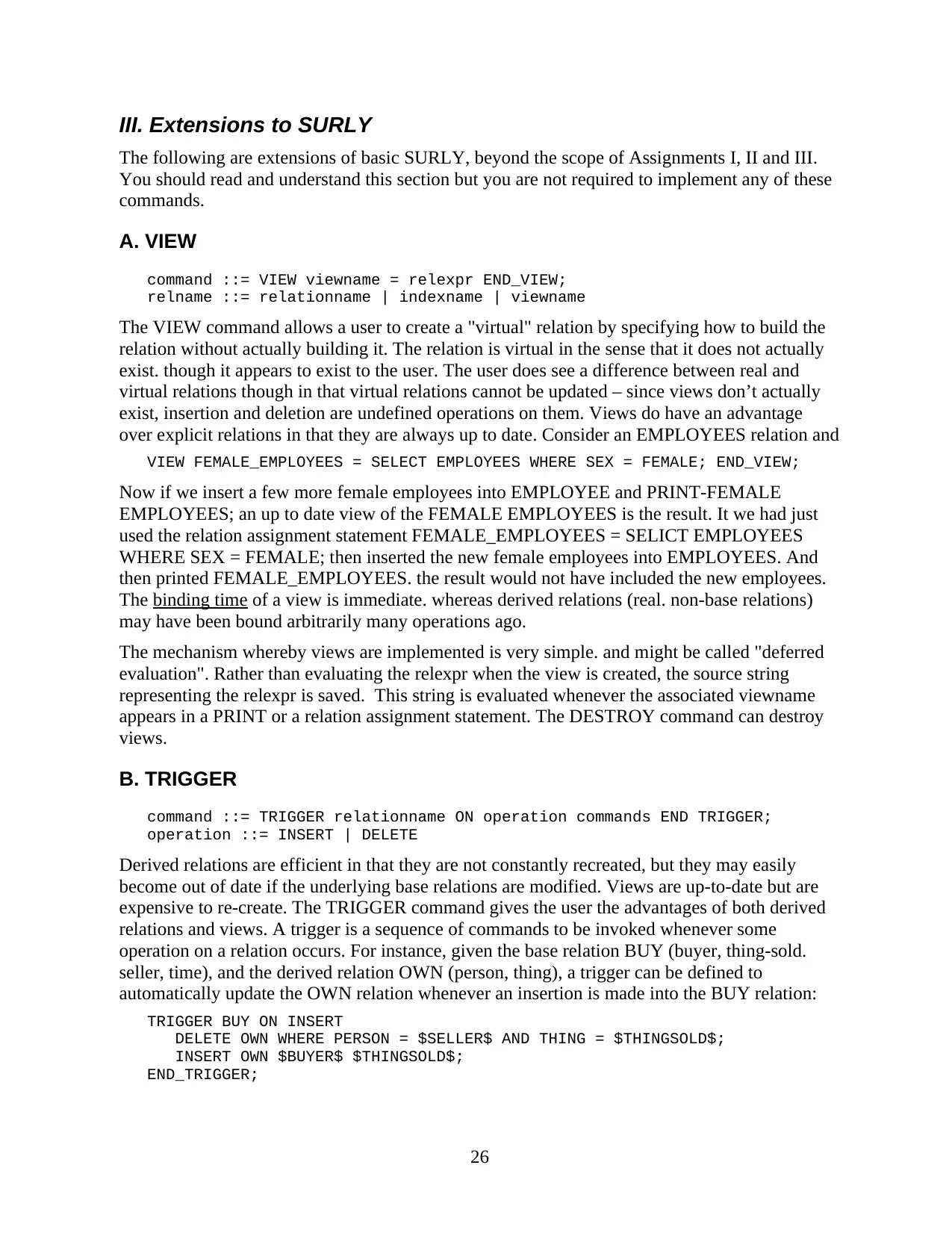
III. Extensions to SURLY
The following are extensions of basic SURLY, beyond the scope of Assignments I, II and III.
You should read and understand this section but you are not required to implement any of these
commands.
A. VIEW
command ::= VIEW viewname = relexpr END_VIEW;
relname ::= relationname | indexname | viewname
The VIEW command allows a user to create a "virtual" relation by specifying how to build the
relation without actually building it. The relation is virtual in the sense that it does not actually
exist. though it appears to exist to the user. The user does see a difference between real and
virtual relations though in that virtual relations cannot be updated – since views don’t actually
exist, insertion and deletion are undefined operations on them. Views do have an advantage
over explicit relations in that they are always up to date. Consider an EMPLOYEES relation and
VIEW FEMALE_EMPLOYEES = SELECT EMPLOYEES WHERE SEX = FEMALE; END_VIEW;
Now if we insert a few more female employees into EMPLOYEE and PRINT-FEMALE
EMPLOYEES; an up to date view of the FEMALE EMPLOYEES is the result. It we had just
used the relation assignment statement FEMALE_EMPLOYEES = SELICT EMPLOYEES
WHERE SEX = FEMALE; then inserted the new female employees into EMPLOYEES. And
then printed FEMALE_EMPLOYEES. the result would not have included the new employees.
The binding time of a view is immediate. whereas derived relations (real. non-base relations)
may have been bound arbitrarily many operations ago.
The mechanism whereby views are implemented is very simple. and might be called "deferred
evaluation". Rather than evaluating the relexpr when the view is created, the source string
representing the relexpr is saved. This string is evaluated whenever the associated viewname
appears in a PRINT or a relation assignment statement. The DESTROY command can destroy
views.
B. TRIGGER
command ::= TRIGGER relationname ON operation commands END TRIGGER;
operation ::= INSERT | DELETE
Derived relations are efficient in that they are not constantly recreated, but they may easily
become out of date if the underlying base relations are modified. Views are up-to-date but are
expensive to re-create. The TRIGGER command gives the user the advantages of both derived
relations and views. A trigger is a sequence of commands to be invoked whenever some
operation on a relation occurs. For instance, given the base relation BUY (buyer, thing-sold.
seller, time), and the derived relation OWN (person, thing), a trigger can be defined to
automatically update the OWN relation whenever an insertion is made into the BUY relation:
TRIGGER BUY ON INSERT
DELETE OWN WHERE PERSON = $SELLER$ AND THING = $THINGSOLD$;
INSERT OWN $BUYER$ $THINGSOLD$;
END_TRIGGER;
26
The following are extensions of basic SURLY, beyond the scope of Assignments I, II and III.
You should read and understand this section but you are not required to implement any of these
commands.
A. VIEW
command ::= VIEW viewname = relexpr END_VIEW;
relname ::= relationname | indexname | viewname
The VIEW command allows a user to create a "virtual" relation by specifying how to build the
relation without actually building it. The relation is virtual in the sense that it does not actually
exist. though it appears to exist to the user. The user does see a difference between real and
virtual relations though in that virtual relations cannot be updated – since views don’t actually
exist, insertion and deletion are undefined operations on them. Views do have an advantage
over explicit relations in that they are always up to date. Consider an EMPLOYEES relation and
VIEW FEMALE_EMPLOYEES = SELECT EMPLOYEES WHERE SEX = FEMALE; END_VIEW;
Now if we insert a few more female employees into EMPLOYEE and PRINT-FEMALE
EMPLOYEES; an up to date view of the FEMALE EMPLOYEES is the result. It we had just
used the relation assignment statement FEMALE_EMPLOYEES = SELICT EMPLOYEES
WHERE SEX = FEMALE; then inserted the new female employees into EMPLOYEES. And
then printed FEMALE_EMPLOYEES. the result would not have included the new employees.
The binding time of a view is immediate. whereas derived relations (real. non-base relations)
may have been bound arbitrarily many operations ago.
The mechanism whereby views are implemented is very simple. and might be called "deferred
evaluation". Rather than evaluating the relexpr when the view is created, the source string
representing the relexpr is saved. This string is evaluated whenever the associated viewname
appears in a PRINT or a relation assignment statement. The DESTROY command can destroy
views.
B. TRIGGER
command ::= TRIGGER relationname ON operation commands END TRIGGER;
operation ::= INSERT | DELETE
Derived relations are efficient in that they are not constantly recreated, but they may easily
become out of date if the underlying base relations are modified. Views are up-to-date but are
expensive to re-create. The TRIGGER command gives the user the advantages of both derived
relations and views. A trigger is a sequence of commands to be invoked whenever some
operation on a relation occurs. For instance, given the base relation BUY (buyer, thing-sold.
seller, time), and the derived relation OWN (person, thing), a trigger can be defined to
automatically update the OWN relation whenever an insertion is made into the BUY relation:
TRIGGER BUY ON INSERT
DELETE OWN WHERE PERSON = $SELLER$ AND THING = $THINGSOLD$;
INSERT OWN $BUYER$ $THINGSOLD$;
END_TRIGGER;
26

Now if "INSERT BUY JOHN CAR5l MARY 8-3-79;" is executed, the trigger automatically
deletes the fact that Mary owns car5l and inserts the fact that now John owns it.
Probably the best way to implement triggers is to store the trigger command body as a string
associated with the triggered relation. Modify INSERT and DELETE to check for triggers when
inserting/deleting a tuple into a relation. The $attrib$ notation is used in triggers to mean:
"replace $attrib$ by the corresponding tuple field before executing the code". A relation need
have only one trigger (of arbitrary complexity) for insertion and one for deletion, so to destroy a
trigger, replace it by a null trigger:
TRIGGER BUY ON INSERT '' END TRIGGER.
C. INTEGRITY CONSTRAINT
command ::= INTEGRITY_CONSTRAINT relationname WHERE (qualifier);
The INTEGRITY_CONSTRAINT command associates with a relation a membership test (the
qualification) that new tuples must pass before they can be inserted. For example:
INTEGRITY_CONSTRAINT INSTRUCTOR WHERE (IAGE > 17 AND IAGE < 75);
only allows a user to create new instructor tuples when the instructor's age is in a legal range --
tuples like <Thompson 92> should be printed as errors and should not be inserted. To
implement the INTEGRITY_CONSTRAINT command, store the qualification with the relation
in the RELATION table and change INSERT to check for and evaluate a qualification if it's
present, before inserting the tuple. Note: there may be several integrity statements per relation.
If you want to support destroying integrity statements, then add a name field to name each
integrity statement.
D. RETRIEVE – a calculus operator for SURLY
command ::= RANGE tuplevar IS relationname;
relexpr ::= RETRIEVE (<rel attrib>) WHERE (qual)
tuplevar ::= identifier
relattrib ::= tuplevar.attrib
qual ::= cf | cf AND qual | cf OR qual
cf ::= relattrib relop value |
relattrib = relattrib
Example: Given relations COURSE, OFFERING, and STAFF from Figure 2:
PRINT Tl =(RETRIEVE (STAFF.RANK,COURSE.TITLE)
WHERE (COURSE.CNUM = OFFERING.CNUM AND
OFFERING.CNUM < CS5OOO AND
OFFERING.INSTRUCTOR = STAFF.NAME)
GIVING (RANK,COURSE_TITLE));
EQUAL? (Tl, PROJECT (JOIN (JOIN COURSE
AND SELECT OFFERING WHERE (CNUM < CS5OO0)
OVER CNUM AND CNUM)
AND STAFF
OVER INSTRUCTOR AND NAME)
OVER (RANK,TITLE)
GIVING (RANK,COURSE_TITLE));
would print
27
deletes the fact that Mary owns car5l and inserts the fact that now John owns it.
Probably the best way to implement triggers is to store the trigger command body as a string
associated with the triggered relation. Modify INSERT and DELETE to check for triggers when
inserting/deleting a tuple into a relation. The $attrib$ notation is used in triggers to mean:
"replace $attrib$ by the corresponding tuple field before executing the code". A relation need
have only one trigger (of arbitrary complexity) for insertion and one for deletion, so to destroy a
trigger, replace it by a null trigger:
TRIGGER BUY ON INSERT '' END TRIGGER.
C. INTEGRITY CONSTRAINT
command ::= INTEGRITY_CONSTRAINT relationname WHERE (qualifier);
The INTEGRITY_CONSTRAINT command associates with a relation a membership test (the
qualification) that new tuples must pass before they can be inserted. For example:
INTEGRITY_CONSTRAINT INSTRUCTOR WHERE (IAGE > 17 AND IAGE < 75);
only allows a user to create new instructor tuples when the instructor's age is in a legal range --
tuples like <Thompson 92> should be printed as errors and should not be inserted. To
implement the INTEGRITY_CONSTRAINT command, store the qualification with the relation
in the RELATION table and change INSERT to check for and evaluate a qualification if it's
present, before inserting the tuple. Note: there may be several integrity statements per relation.
If you want to support destroying integrity statements, then add a name field to name each
integrity statement.
D. RETRIEVE – a calculus operator for SURLY
command ::= RANGE tuplevar IS relationname;
relexpr ::= RETRIEVE (<rel attrib>) WHERE (qual)
tuplevar ::= identifier
relattrib ::= tuplevar.attrib
qual ::= cf | cf AND qual | cf OR qual
cf ::= relattrib relop value |
relattrib = relattrib
Example: Given relations COURSE, OFFERING, and STAFF from Figure 2:
PRINT Tl =(RETRIEVE (STAFF.RANK,COURSE.TITLE)
WHERE (COURSE.CNUM = OFFERING.CNUM AND
OFFERING.CNUM < CS5OOO AND
OFFERING.INSTRUCTOR = STAFF.NAME)
GIVING (RANK,COURSE_TITLE));
EQUAL? (Tl, PROJECT (JOIN (JOIN COURSE
AND SELECT OFFERING WHERE (CNUM < CS5OO0)
OVER CNUM AND CNUM)
AND STAFF
OVER INSTRUCTOR AND NAME)
OVER (RANK,TITLE)
GIVING (RANK,COURSE_TITLE));
would print
27
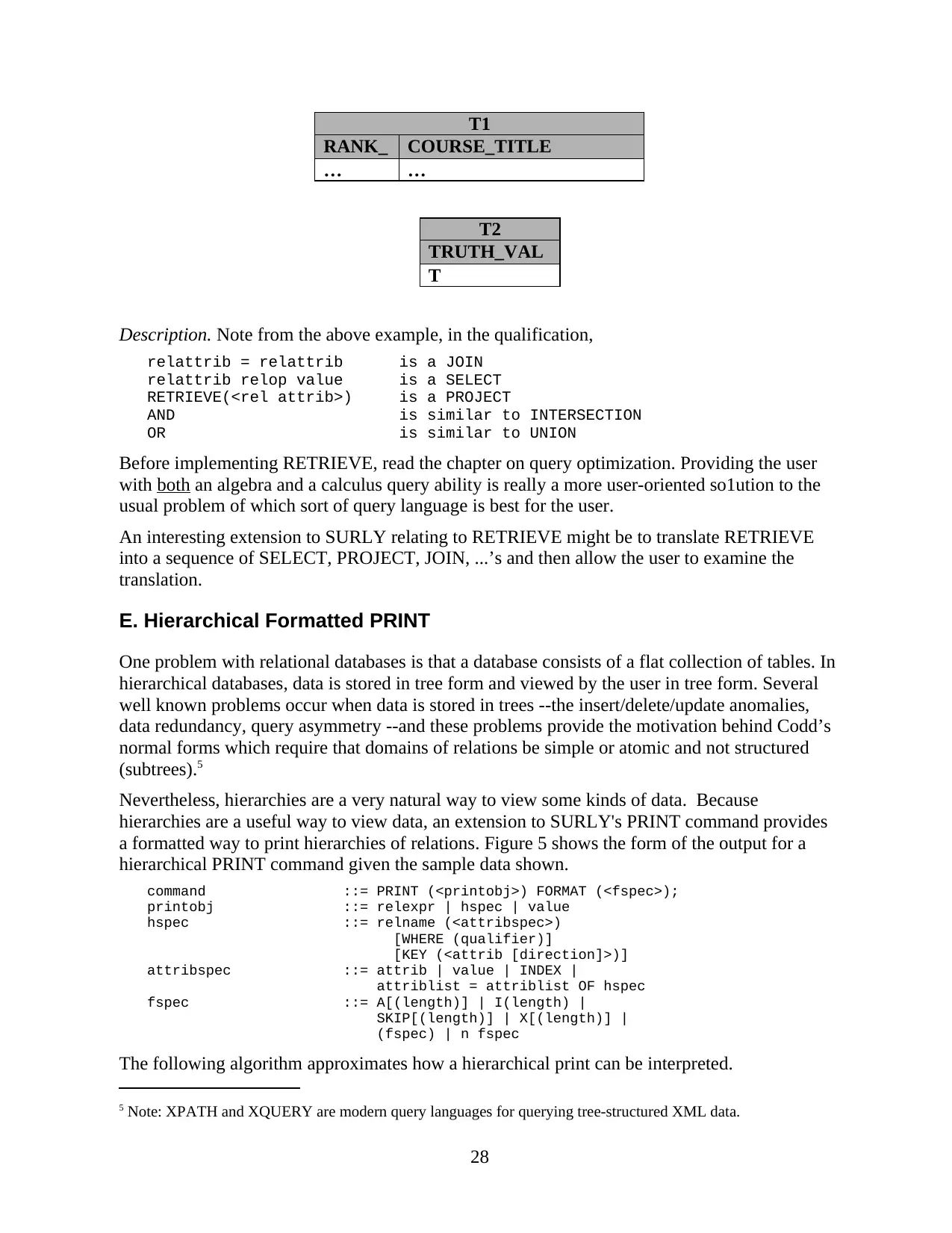
T1
RANK_ COURSE_TITLE
… …
T2
TRUTH_VAL
T
Description. Note from the above example, in the qualification,
relattrib = relattrib is a JOIN
relattrib relop value is a SELECT
RETRIEVE(<rel attrib>) is a PROJECT
AND is similar to INTERSECTION
OR is similar to UNION
Before implementing RETRIEVE, read the chapter on query optimization. Providing the user
with both an algebra and a calculus query ability is really a more user-oriented so1ution to the
usual problem of which sort of query language is best for the user.
An interesting extension to SURLY relating to RETRIEVE might be to translate RETRIEVE
into a sequence of SELECT, PROJECT, JOIN, ...’s and then allow the user to examine the
translation.
E. Hierarchical Formatted PRINT
One problem with relational databases is that a database consists of a flat collection of tables. In
hierarchical databases, data is stored in tree form and viewed by the user in tree form. Several
well known problems occur when data is stored in trees --the insert/delete/update anomalies,
data redundancy, query asymmetry --and these problems provide the motivation behind Codd’s
normal forms which require that domains of relations be simple or atomic and not structured
(subtrees).5
Nevertheless, hierarchies are a very natural way to view some kinds of data. Because
hierarchies are a useful way to view data, an extension to SURLY's PRINT command provides
a formatted way to print hierarchies of relations. Figure 5 shows the form of the output for a
hierarchical PRINT command given the sample data shown.
command ::= PRINT (<printobj>) FORMAT (<fspec>);
printobj ::= relexpr | hspec | value
hspec ::= relname (<attribspec>)
[WHERE (qualifier)]
[KEY (<attrib [direction]>)]
attribspec ::= attrib | value | INDEX |
attriblist = attriblist OF hspec
fspec ::= A[(length)] | I(length) |
SKIP[(length)] | X[(length)] |
(fspec) | n fspec
The following algorithm approximates how a hierarchical print can be interpreted.
5 Note: XPATH and XQUERY are modern query languages for querying tree-structured XML data.
28
RANK_ COURSE_TITLE
… …
T2
TRUTH_VAL
T
Description. Note from the above example, in the qualification,
relattrib = relattrib is a JOIN
relattrib relop value is a SELECT
RETRIEVE(<rel attrib>) is a PROJECT
AND is similar to INTERSECTION
OR is similar to UNION
Before implementing RETRIEVE, read the chapter on query optimization. Providing the user
with both an algebra and a calculus query ability is really a more user-oriented so1ution to the
usual problem of which sort of query language is best for the user.
An interesting extension to SURLY relating to RETRIEVE might be to translate RETRIEVE
into a sequence of SELECT, PROJECT, JOIN, ...’s and then allow the user to examine the
translation.
E. Hierarchical Formatted PRINT
One problem with relational databases is that a database consists of a flat collection of tables. In
hierarchical databases, data is stored in tree form and viewed by the user in tree form. Several
well known problems occur when data is stored in trees --the insert/delete/update anomalies,
data redundancy, query asymmetry --and these problems provide the motivation behind Codd’s
normal forms which require that domains of relations be simple or atomic and not structured
(subtrees).5
Nevertheless, hierarchies are a very natural way to view some kinds of data. Because
hierarchies are a useful way to view data, an extension to SURLY's PRINT command provides
a formatted way to print hierarchies of relations. Figure 5 shows the form of the output for a
hierarchical PRINT command given the sample data shown.
command ::= PRINT (<printobj>) FORMAT (<fspec>);
printobj ::= relexpr | hspec | value
hspec ::= relname (<attribspec>)
[WHERE (qualifier)]
[KEY (<attrib [direction]>)]
attribspec ::= attrib | value | INDEX |
attriblist = attriblist OF hspec
fspec ::= A[(length)] | I(length) |
SKIP[(length)] | X[(length)] |
(fspec) | n fspec
The following algorithm approximates how a hierarchical print can be interpreted.
5 Note: XPATH and XQUERY are modern query languages for querying tree-structured XML data.
28
Paraphrase This Document
Need a fresh take? Get an instant paraphrase of this document with our AI Paraphraser
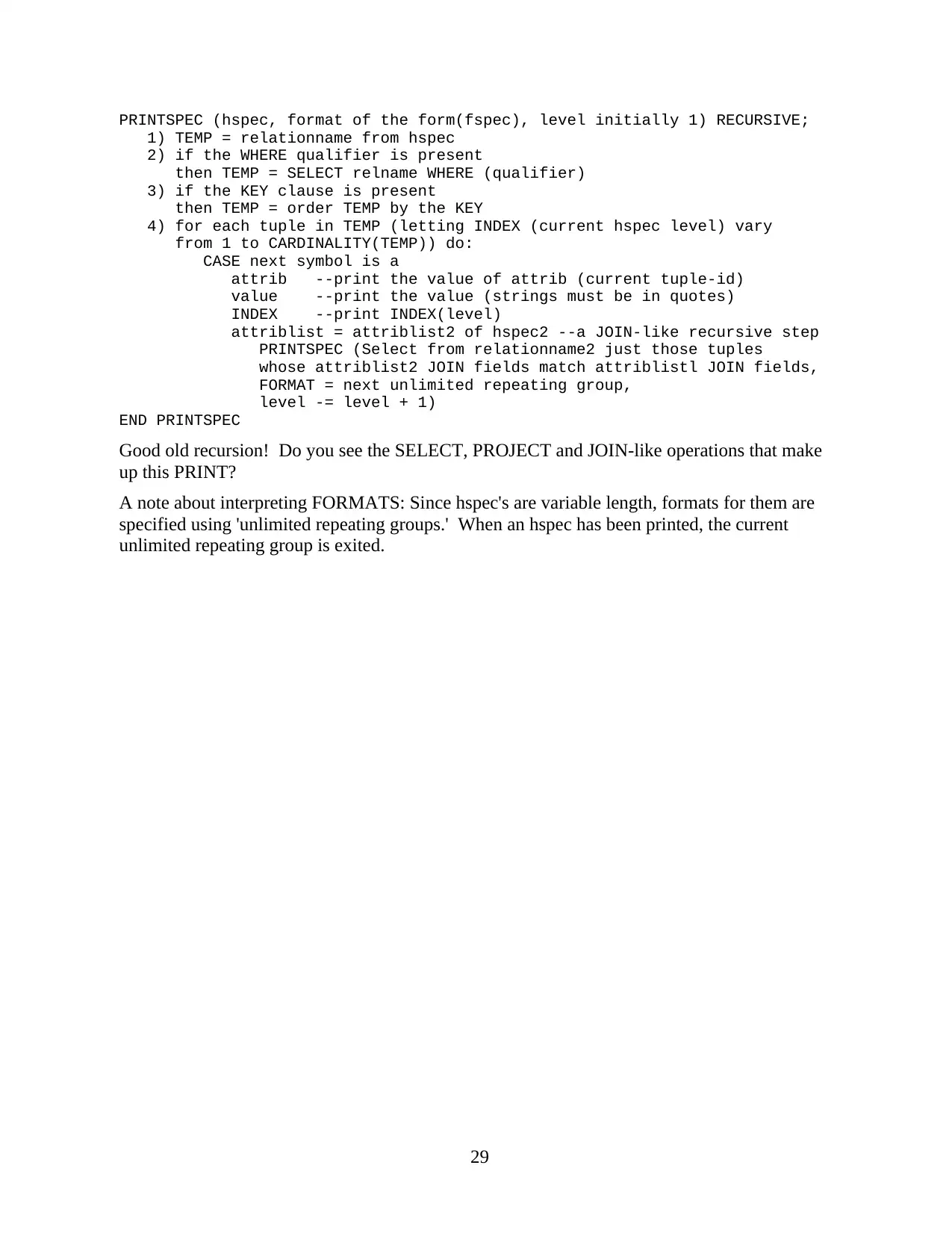
PRINTSPEC (hspec, format of the form(fspec), level initially 1) RECURSIVE;
1) TEMP = relationname from hspec
2) if the WHERE qualifier is present
then TEMP = SELECT relname WHERE (qualifier)
3) if the KEY clause is present
then TEMP = order TEMP by the KEY
4) for each tuple in TEMP (letting INDEX (current hspec level) vary
from 1 to CARDINALITY(TEMP)) do:
CASE next symbol is a
attrib --print the value of attrib (current tuple-id)
value --print the value (strings must be in quotes)
INDEX --print INDEX(level)
attriblist = attriblist2 of hspec2 --a JOIN-like recursive step
PRINTSPEC (Select from relationname2 just those tuples
whose attriblist2 JOIN fields match attriblistl JOIN fields,
FORMAT = next unlimited repeating group,
level -= level + 1)
END PRINTSPEC
Good old recursion! Do you see the SELECT, PROJECT and JOIN-like operations that make
up this PRINT?
A note about interpreting FORMATS: Since hspec's are variable length, formats for them are
specified using 'unlimited repeating groups.' When an hspec has been printed, the current
unlimited repeating group is exited.
29
1) TEMP = relationname from hspec
2) if the WHERE qualifier is present
then TEMP = SELECT relname WHERE (qualifier)
3) if the KEY clause is present
then TEMP = order TEMP by the KEY
4) for each tuple in TEMP (letting INDEX (current hspec level) vary
from 1 to CARDINALITY(TEMP)) do:
CASE next symbol is a
attrib --print the value of attrib (current tuple-id)
value --print the value (strings must be in quotes)
INDEX --print INDEX(level)
attriblist = attriblist2 of hspec2 --a JOIN-like recursive step
PRINTSPEC (Select from relationname2 just those tuples
whose attriblist2 JOIN fields match attriblistl JOIN fields,
FORMAT = next unlimited repeating group,
level -= level + 1)
END PRINTSPEC
Good old recursion! Do you see the SELECT, PROJECT and JOIN-like operations that make
up this PRINT?
A note about interpreting FORMATS: Since hspec's are variable length, formats for them are
specified using 'unlimited repeating groups.' When an hspec has been printed, the current
unlimited repeating group is exited.
29
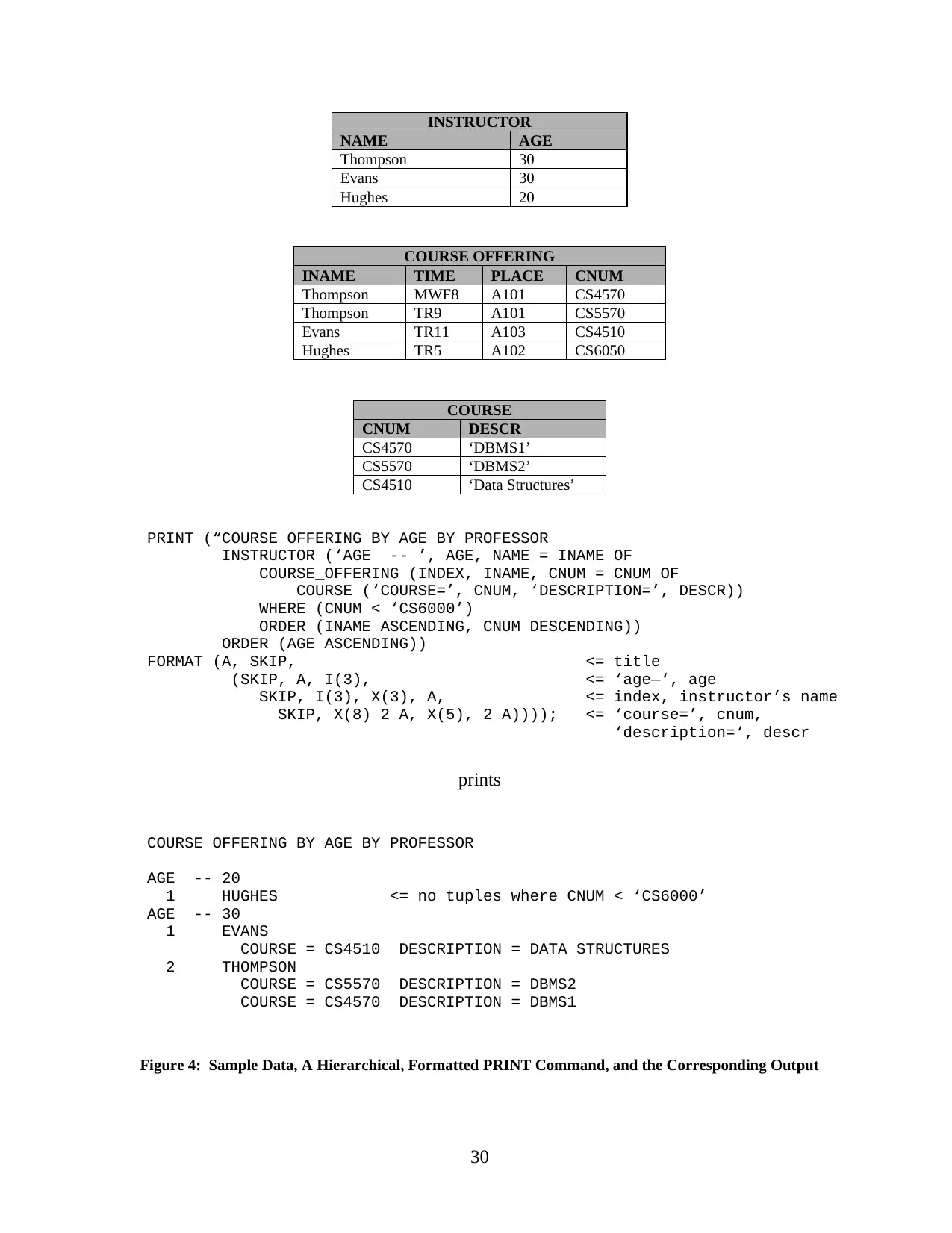
INSTRUCTOR
NAME AGE
Thompson 30
Evans 30
Hughes 20
COURSE OFFERING
INAME TIME PLACE CNUM
Thompson MWF8 A101 CS4570
Thompson TR9 A101 CS5570
Evans TR11 A103 CS4510
Hughes TR5 A102 CS6050
COURSE
CNUM DESCR
CS4570 ‘DBMS1’
CS5570 ‘DBMS2’
CS4510 ‘Data Structures’
PRINT (“COURSE OFFERING BY AGE BY PROFESSOR
INSTRUCTOR (‘AGE -- ’, AGE, NAME = INAME OF
COURSE_OFFERING (INDEX, INAME, CNUM = CNUM OF
COURSE (‘COURSE=’, CNUM, ‘DESCRIPTION=’, DESCR))
WHERE (CNUM < ‘CS6000’)
ORDER (INAME ASCENDING, CNUM DESCENDING))
ORDER (AGE ASCENDING))
FORMAT (A, SKIP, <= title
(SKIP, A, I(3), <= ‘age—‘, age
SKIP, I(3), X(3), A, <= index, instructor’s name
SKIP, X(8) 2 A, X(5), 2 A)))); <= ‘course=’, cnum,
‘description=‘, descr
prints
COURSE OFFERING BY AGE BY PROFESSOR
AGE -- 20
1 HUGHES <= no tuples where CNUM < ‘CS6000’
AGE -- 30
1 EVANS
COURSE = CS4510 DESCRIPTION = DATA STRUCTURES
2 THOMPSON
COURSE = CS5570 DESCRIPTION = DBMS2
COURSE = CS4570 DESCRIPTION = DBMS1
Figure 4: Sample Data, A Hierarchical, Formatted PRINT Command, and the Corresponding Output
30
NAME AGE
Thompson 30
Evans 30
Hughes 20
COURSE OFFERING
INAME TIME PLACE CNUM
Thompson MWF8 A101 CS4570
Thompson TR9 A101 CS5570
Evans TR11 A103 CS4510
Hughes TR5 A102 CS6050
COURSE
CNUM DESCR
CS4570 ‘DBMS1’
CS5570 ‘DBMS2’
CS4510 ‘Data Structures’
PRINT (“COURSE OFFERING BY AGE BY PROFESSOR
INSTRUCTOR (‘AGE -- ’, AGE, NAME = INAME OF
COURSE_OFFERING (INDEX, INAME, CNUM = CNUM OF
COURSE (‘COURSE=’, CNUM, ‘DESCRIPTION=’, DESCR))
WHERE (CNUM < ‘CS6000’)
ORDER (INAME ASCENDING, CNUM DESCENDING))
ORDER (AGE ASCENDING))
FORMAT (A, SKIP, <= title
(SKIP, A, I(3), <= ‘age—‘, age
SKIP, I(3), X(3), A, <= index, instructor’s name
SKIP, X(8) 2 A, X(5), 2 A)))); <= ‘course=’, cnum,
‘description=‘, descr
prints
COURSE OFFERING BY AGE BY PROFESSOR
AGE -- 20
1 HUGHES <= no tuples where CNUM < ‘CS6000’
AGE -- 30
1 EVANS
COURSE = CS4510 DESCRIPTION = DATA STRUCTURES
2 THOMPSON
COURSE = CS5570 DESCRIPTION = DBMS2
COURSE = CS4570 DESCRIPTION = DBMS1
Figure 4: Sample Data, A Hierarchical, Formatted PRINT Command, and the Corresponding Output
30
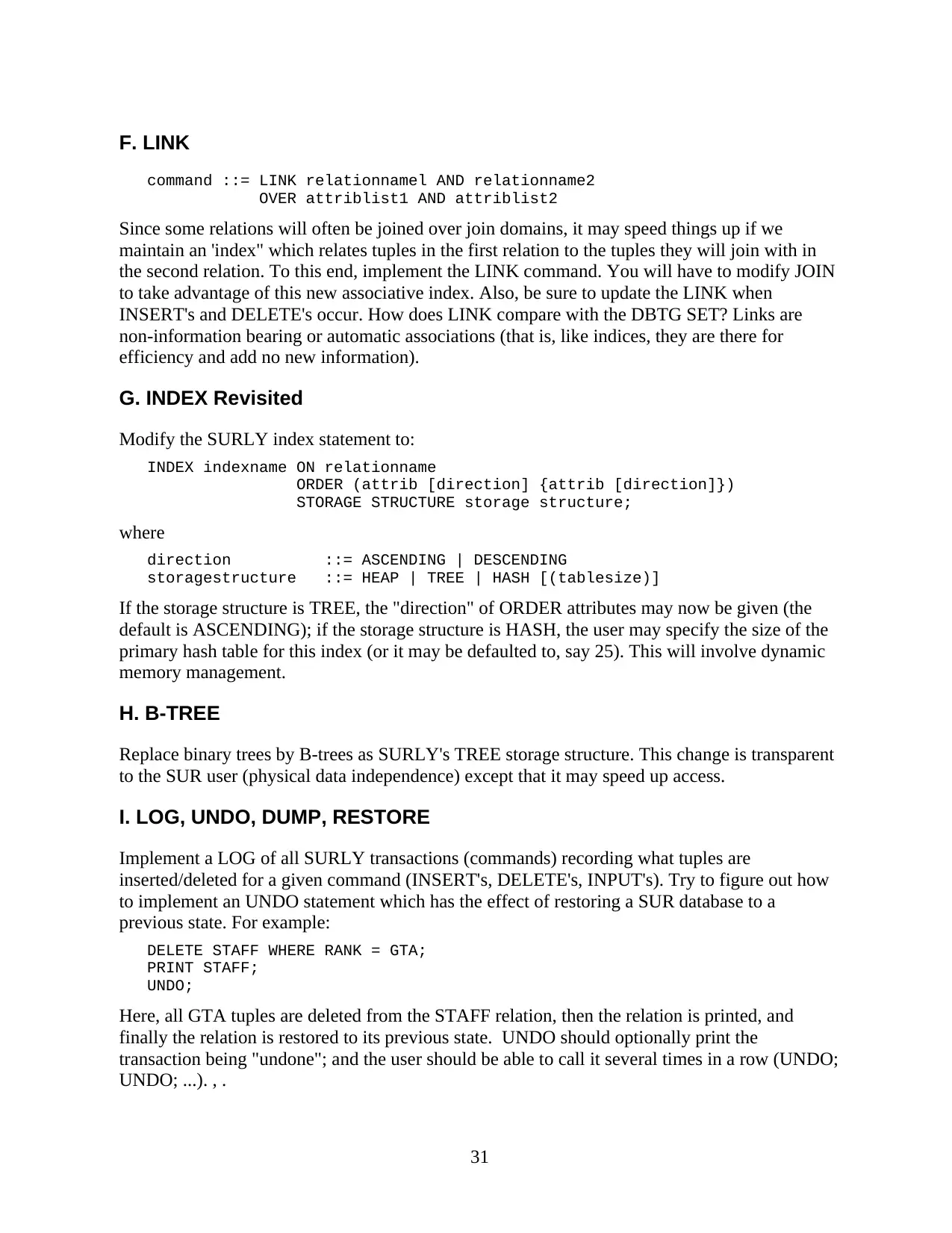
F. LINK
command ::= LINK relationnamel AND relationname2
OVER attriblist1 AND attriblist2
Since some relations will often be joined over join domains, it may speed things up if we
maintain an 'index" which relates tuples in the first relation to the tuples they will join with in
the second relation. To this end, implement the LINK command. You will have to modify JOIN
to take advantage of this new associative index. Also, be sure to update the LINK when
INSERT's and DELETE's occur. How does LINK compare with the DBTG SET? Links are
non-information bearing or automatic associations (that is, like indices, they are there for
efficiency and add no new information).
G. INDEX Revisited
Modify the SURLY index statement to:
INDEX indexname ON relationname
ORDER (attrib [direction] {attrib [direction]})
STORAGE STRUCTURE storage structure;
where
direction ::= ASCENDING | DESCENDING
storagestructure ::= HEAP | TREE | HASH [(tablesize)]
If the storage structure is TREE, the "direction" of ORDER attributes may now be given (the
default is ASCENDING); if the storage structure is HASH, the user may specify the size of the
primary hash table for this index (or it may be defaulted to, say 25). This will involve dynamic
memory management.
H. B-TREE
Replace binary trees by B-trees as SURLY's TREE storage structure. This change is transparent
to the SUR user (physical data independence) except that it may speed up access.
I. LOG, UNDO, DUMP, RESTORE
Implement a LOG of all SURLY transactions (commands) recording what tuples are
inserted/deleted for a given command (INSERT's, DELETE's, INPUT's). Try to figure out how
to implement an UNDO statement which has the effect of restoring a SUR database to a
previous state. For example:
DELETE STAFF WHERE RANK = GTA;
PRINT STAFF;
UNDO;
Here, all GTA tuples are deleted from the STAFF relation, then the relation is printed, and
finally the relation is restored to its previous state. UNDO should optionally print the
transaction being "undone"; and the user should be able to call it several times in a row (UNDO;
UNDO; ...). , .
31
command ::= LINK relationnamel AND relationname2
OVER attriblist1 AND attriblist2
Since some relations will often be joined over join domains, it may speed things up if we
maintain an 'index" which relates tuples in the first relation to the tuples they will join with in
the second relation. To this end, implement the LINK command. You will have to modify JOIN
to take advantage of this new associative index. Also, be sure to update the LINK when
INSERT's and DELETE's occur. How does LINK compare with the DBTG SET? Links are
non-information bearing or automatic associations (that is, like indices, they are there for
efficiency and add no new information).
G. INDEX Revisited
Modify the SURLY index statement to:
INDEX indexname ON relationname
ORDER (attrib [direction] {attrib [direction]})
STORAGE STRUCTURE storage structure;
where
direction ::= ASCENDING | DESCENDING
storagestructure ::= HEAP | TREE | HASH [(tablesize)]
If the storage structure is TREE, the "direction" of ORDER attributes may now be given (the
default is ASCENDING); if the storage structure is HASH, the user may specify the size of the
primary hash table for this index (or it may be defaulted to, say 25). This will involve dynamic
memory management.
H. B-TREE
Replace binary trees by B-trees as SURLY's TREE storage structure. This change is transparent
to the SUR user (physical data independence) except that it may speed up access.
I. LOG, UNDO, DUMP, RESTORE
Implement a LOG of all SURLY transactions (commands) recording what tuples are
inserted/deleted for a given command (INSERT's, DELETE's, INPUT's). Try to figure out how
to implement an UNDO statement which has the effect of restoring a SUR database to a
previous state. For example:
DELETE STAFF WHERE RANK = GTA;
PRINT STAFF;
UNDO;
Here, all GTA tuples are deleted from the STAFF relation, then the relation is printed, and
finally the relation is restored to its previous state. UNDO should optionally print the
transaction being "undone"; and the user should be able to call it several times in a row (UNDO;
UNDO; ...). , .
31
Secure Best Marks with AI Grader
Need help grading? Try our AI Grader for instant feedback on your assignments.
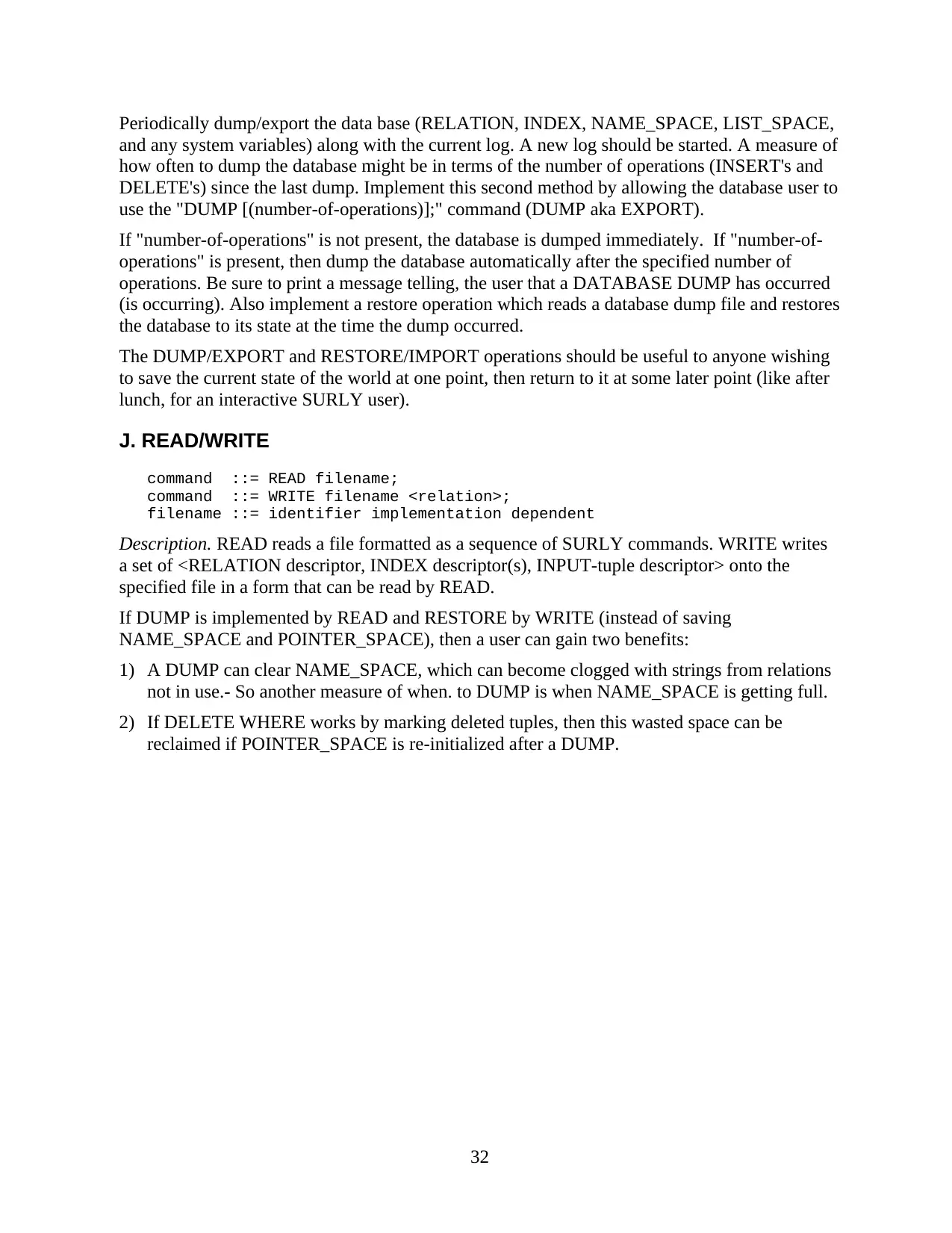
Periodically dump/export the data base (RELATION, INDEX, NAME_SPACE, LIST_SPACE,
and any system variables) along with the current log. A new log should be started. A measure of
how often to dump the database might be in terms of the number of operations (INSERT's and
DELETE's) since the last dump. Implement this second method by allowing the database user to
use the "DUMP [(number-of-operations)];" command (DUMP aka EXPORT).
If "number-of-operations" is not present, the database is dumped immediately. If "number-of-
operations" is present, then dump the database automatically after the specified number of
operations. Be sure to print a message telling, the user that a DATABASE DUMP has occurred
(is occurring). Also implement a restore operation which reads a database dump file and restores
the database to its state at the time the dump occurred.
The DUMP/EXPORT and RESTORE/IMPORT operations should be useful to anyone wishing
to save the current state of the world at one point, then return to it at some later point (like after
lunch, for an interactive SURLY user).
J. READ/WRITE
command ::= READ filename;
command ::= WRITE filename <relation>;
filename ::= identifier implementation dependent
Description. READ reads a file formatted as a sequence of SURLY commands. WRITE writes
a set of <RELATION descriptor, INDEX descriptor(s), INPUT-tuple descriptor> onto the
specified file in a form that can be read by READ.
If DUMP is implemented by READ and RESTORE by WRITE (instead of saving
NAME_SPACE and POINTER_SPACE), then a user can gain two benefits:
1) A DUMP can clear NAME_SPACE, which can become clogged with strings from relations
not in use.- So another measure of when. to DUMP is when NAME_SPACE is getting full.
2) If DELETE WHERE works by marking deleted tuples, then this wasted space can be
reclaimed if POINTER_SPACE is re-initialized after a DUMP.
32
and any system variables) along with the current log. A new log should be started. A measure of
how often to dump the database might be in terms of the number of operations (INSERT's and
DELETE's) since the last dump. Implement this second method by allowing the database user to
use the "DUMP [(number-of-operations)];" command (DUMP aka EXPORT).
If "number-of-operations" is not present, the database is dumped immediately. If "number-of-
operations" is present, then dump the database automatically after the specified number of
operations. Be sure to print a message telling, the user that a DATABASE DUMP has occurred
(is occurring). Also implement a restore operation which reads a database dump file and restores
the database to its state at the time the dump occurred.
The DUMP/EXPORT and RESTORE/IMPORT operations should be useful to anyone wishing
to save the current state of the world at one point, then return to it at some later point (like after
lunch, for an interactive SURLY user).
J. READ/WRITE
command ::= READ filename;
command ::= WRITE filename <relation>;
filename ::= identifier implementation dependent
Description. READ reads a file formatted as a sequence of SURLY commands. WRITE writes
a set of <RELATION descriptor, INDEX descriptor(s), INPUT-tuple descriptor> onto the
specified file in a form that can be read by READ.
If DUMP is implemented by READ and RESTORE by WRITE (instead of saving
NAME_SPACE and POINTER_SPACE), then a user can gain two benefits:
1) A DUMP can clear NAME_SPACE, which can become clogged with strings from relations
not in use.- So another measure of when. to DUMP is when NAME_SPACE is getting full.
2) If DELETE WHERE works by marking deleted tuples, then this wasted space can be
reclaimed if POINTER_SPACE is re-initialized after a DUMP.
32
1 out of 32
![[object Object]](/_next/static/media/star-bottom.7253800d.svg)
